
WINTER 2024 EDITION 19 MANAGING LIFE WITH VARROA Industry 18 MARK SALTER VISITS QUEENSLAND Rubus 53 FUNGICIDE UPDATE Strawberries 81 GETTING NITROGEN RIGHT Blueberries 102
AUSTRALIAN BERRY JOURNAL



EDITOR
Jane Richter
TERES Communication 0431 700 258 jane@teres.com.au
CONTRIBUTORS
Jane Richter Rachel Mackenzie Anthony Poiner
Simon Dornauf Andrew Bell
Richard McGruddy Brett Fifield
Gaius Leong
ADVERTISING
For
Dr
Jutta
Dr
Apollo Gomez
DESIGN
Sama Creative | samacreative.com.au
Blueberry Growers Field Day, Tasmania .............................................................................. 94 Blueberry Research Open Day, Wollongbar Agricultural Institute, NSW 98 Developing nitrogen fertiliser guidelines for blueberry: Research update ....................... 102 Dam Water Quality Workshop: How to manage algae, aquatic weed & iron issues 104 BLUEBERRIES Varroa destructor Transition to Management: What happens now? 18 SIMODIS® insecticide: Emergency Use Permit for Chilli thrip in berries ............................. 21 Reporting Chemical ‘Non-Performances’ or ‘Adverse Experiences’ 24 IDO & Communications Project Update: Year 1 Achievements ......................................... 26 BerryQuest International 2025: Opportunities to Sponsor & Exhibit................................. 28 Berry Basket Marketing: Burst One ...................................................................................... 33 MT21000: Enhancing Health Professional Engagement ..................................................... 38 Export Update: Market Profile – Hong Kong 40 Certified soil biodegradable mulches ................................................................................... 43 INDUSTRY Profile: Blue Hills Berries & Cherries, Victoria ....................................................................... 47 Profile: Henry Scott, Costa Group ..........................................................................................51 Rubus IDO Mark Salter visits Queensland 53 RUBUS Webinar Report: What yield pattern are you aiming for? ................................................. 61 Yields of strawberry plants vary more with the season than with the cultivar 73 Management of fruit rot diseases & fungicide resistance: 2024 update ............................81 Planting at the right time after fumigation saves money 87 STRAWBERRIES WINTER 2024 EDITION 19 AUSTRALIAN BERRY JOURNAL Wherever you see this logo, the initiative is part of the Hort Innovation Blueberry, Strawberry and Raspberry and Blackberry Fund. Like this publication itself, it has been funded by Hort Innovation using the Blueberry, Strawberry and Raspberry and Blackberry R&D levy and funds from the Australian Government. Some projects also involve funding from additional sources. DISCLAIMER: Whilst every care has been taken in the preparation of this journal, the information contained is necessarily of a general nature and should not be relied upon as a substitute for specific advice. The advice and opinions in the articles published in Australian Berry Journal are essentially those of contributors and do not necessarily reflect the views of Berries Australia or the Editor. The advice is at the reader’s own risk, and no responsibility is accepted for the accuracy of the material presented. Inclusion of an advertisement in this publication does not necessarily imply endorsement of the product, company or service by Berries Australia or the Editor. Horticulture Innovation Australia Limited (Hort Innovation) makes no representations and expressly disclaims all warranties (to the extent permitted by law) about the accuracy, completeness, or currency of information in Australian Berry Journal. Reliance on any information provided by Hort Innovation is entirely at your own risk. Hort Innovation is not responsible for, and will not be liable for, any loss, damage, claim, expense, cost (including legal costs) or other liability arising in any way, including from any Hort Innovation or other person’s negligence or otherwise from your use or non-use of Australian Berry Journal or from reliance on information contained in the material or that Hort Innovation provides to you by any other means. Copyright © Horticulture Innovation Australia Limited 2024 Copyright subsists in Australian Berry Journal. Horticulture Innovation Australia Limited (Hort Innovation) owns the copyright, other than as permitted under the Copyright ACT 1968 (Cth). Australian Berry Journal (in part or as a whole) cannot be reproduced, published, communicated or adapted without the prior written consent of Hort Innovation. Any request or enquiry to use the Australian Berry Journal should be addressed to: Communications Manager, Hort Innovation, Level 7 | 141 Walker Street, North Sydney 2060, Australia | E: communications@horticulture.com.au | P: 02 8295 2300
all Advertising & Partnership
0491 751 123 | admin@berries.net.au
advertising
advertorial material is subject to review
approval prior to publication.
Enquiries
All
and
and
Jen Rowling Dr Angela Atkinson
Mark Salter
Helen Newman Wendy Morris
Parks
Scott Mattner
Melinda Simpson Sophie
Dr
Dylan McFarlane
Wright
Christopher Menzel

Executive Director's Report
Rachel Mackenzie | 0408 796 199 | rachelmackenzie@berries.net.au
It is not often that I get to start an article with not one, but two wins in the advocacy space. The government has walked back its requirement that all PALM workers have to get paid a minimum of 30 hours per week even if they did not work those hours. The new provisions are that PALM workers must get paid for 120 hours averaged over four weeks. This is a huge win for common sense and, I must point out, the result of tireless advocacy from the Australian Fresh Produce Alliance (AFPA). Whilst AFPA members are indeed the big end of town, this is a win for all growers so I would like to take this opportunity to thank Claire McLelland and Cameron Brown on behalf of the berry industry.
The second win relates to the rejection by the Senate of the proposed Biosecurity Protection Levy (BPL). As you may recall this was sprung on industry in the 2023 budget whereby the government announced that they would be collecting a $50 million contribution from primary producers towards the cost of biosecurity. The BPL would have cost the Rubus industry $140,000 per year and the strawberry industry $275,000 per year on top of existing levies, and a new levy of about $280,000 per year was to be applied to the blueberry industry. This levy was additional to any levy funding for biosecurity responses such as Varroa mite.
Berries Australia was part of an informal coalition of industry associations who lobbied hard against the imposition of the BPL. I had the opportunity to present
to a Senate Inquiry relating to the Bill and it was very pleasing that the Greens and Independent Senator David Pocock along with the Coalition indicated to government that they would not support the Bill. To me this is an excellent example of how our democracy should work, with the Senate acting as the check and balance. I would like to thank the Senators for listening to industry and taking the time to make an informed decision.
It is important that I also give Minister Watt and the government credit for the work they are doing in the trade space. We have had several productive meetings with the Department and the Minister’s office in relation to Vietnam market access. The reopening of negotiations with China is enormously significant for the berry industry, particularly blueberries, where our premium offering has the potential to be highly sought after.
As an industry association we are staunchly apolitical in our advocacy, and we support good policy no matter which side of politics it comes from. Further to that, good policy must be evidence-based and so I would like to thank all 85 of the growers who responded to our recent survey on the Core Skills Occupation List. It makes my job so much easier when I can present robust data to government to support our positions. It was clear from the survey responses that many of the occupations under review are still critical for berry production, so I hope that is taken into consideration by government when making the final decision.
We publish our submissions on the website so please check them out if you are interested. It is also important that we hear from you about the issues that are affecting your business so please get in contact with me directly or via your IDO.
2 INDUSTRY BERRY AUSTRALIAN JOURNAL WINTER 2024 EDITION 19

Chairman's Report
Anthony Poiner | 0412 010 843 |
Berries Australia recently held our six-monthly face-to-face meetings in Melbourne. As always it was a good opportunity to engage with our fellow growers and the Berries Australia team and re-affirm our priorities which are demand creation, industry development and communication and advocacy.
Demand creation has many facets, but marketing and export are our current areas of focus. A new five-year contract has been signed with Hort Innovation to support export market access for berries. Each of the berry categories is at a different stage of their export journey but this new project will make sure that we are ready to seize every opportunity that comes our way.
The joint berry marketing program is well underway, and you can read more about it on PAGE 33. Whilst this is a pilot program it is giving us an opportunity to see what a berry basket campaign looks like as well as developing marketing collateral which we can all use.
The export and marketing programs are overseen by sub-committees which comprise members from across the category who have expertise or a passion in these areas. The success of these committees has stimulated conversation about how we can best deliver outcomes to all berry growers across a range of topics.
We are actively seeking ways to streamline our current committee structure to deliver better outcomes to our growers. The current model whereby we have three PIB committees supported by the team as well as a Berries Australia board has been fine to a point, but it is increasingly evident that there is a lot of duplication of effort, and it makes sense to cut down on administration so we can focus on delivery.
anthony@smartberries.com.au
We are considering expanding the sub-committee concept so they become the engine room of our activities and may cover issues such as export, marketing, workforce and social license/sustainability which cut across all berries as well as berry-specific topics such as strawberry breeding and access to propagation material. These committees will be formal sub-committees of Berries Australia and can comprise members who are not on the Berries Australia board. This will complement the new research and development consultation process now being delivered by Berries Australia on behalf of Hort Innovation and I welcome Angela Atkinson into the role of our new Research and Development Co-ordinator.
As a committee we are thinking long and hard about how we maximise efficiencies, but at the same time don’t lose the buy-in from you, the growers, and your sense that we are here to represent you. This is where the IDO team become really important as each State has a dedicated IDO, but we also have a range of expertise across the berry categories. The IDOs are your connection to Berries Australia but also provide critical intelligence about what is happening on the ground.
Berry Quest International 2025 is a fantastic opportunity for all growers to share knowledge across the category and learn from a range of informative speakers. Simon Dornauf is doing a stellar job in chairing the event subcommittee and the program is really coming together. Please put it in your calendar and I look forward to seeing you in Hobart next February.
If you are an industry stakeholder or supply chain participant and you would like to be a part of BerryQuest International 2025 we have a wide range of sponsorship and exhibitor options available. Please SEE PAGE 28.
3 INDUSTRY
President's Report
Andrew Bell | 0422 234 124 | andrew@mountainblue.com.au

Why we keep pushing for export!
You may wonder why the ABGA committee remains committed to chasing down export markets. We only have to look across the vineyard to the table grape industry to see why! Recent Trademap data shows that the current value of table grape exports from Australia is $605 million, and it has tripled since 2014.
The big game changer for grapes was access to China, with export value increasing from $9 million in 2014 to a whopping $206 million in 2023. For some context, the current value of Australian blueberry exports is $25 million which is a tidy increase from the $1.9 million in 2014. Nevertheless, we have a long way to go, or should I say an enormous opportunity for growth.
Whilst China offers significant potential, the more immediate opportunity may be in Vietnam which could be a game changer for Australian blueberries. Again, looking at the table grape figures, the value of exports to Vietnam in 2014 was $30 million and has increased to $89 million in 2023. Whilst we can’t expect exactly the same sort of response for blueberries straight away, the market intelligence is that Australian fruit is highly prized by the burgeoning middle class and premium fruit can expect premium prices.
Currently the United States dominates the Vietnamese blueberry market from June to September and New Zealand is the only supplier from October through to
April. There are large gaps in supply in the blueberry market there in the Australian peak season from July through to October. New Zealand achieves considerably higher prices in Vietnam than the USA does, although prices do soften in the February peak supply period. We are realistically hopeful that Vietnam could become our largest export market eclipsing Hong Kong which currently sits at $14 million.
We have had excellent engagement with the Australian Department of Agriculture in recent months. Obviously, progression is dependent on the response from our trading partners, but in the case of Australia and Vietnam, as we have accorded each other special trading partner status the signs are positive.
Along with the rest of the committee, I firmly believe that focusing on gaining market access is the single biggest way we can improve the bottom line for Australian berry growers. Even if you are not considering export yourself, just taking the pressure off the Australian supply chain during peak supply periods will give us all more negotiating power in the domestic market.
The ABGA continues to have access to the services of the highly competent Jenny Van de Meeberg through the Berries Australia export project. We have just signed a new five-year contract which I firmly believe positions us for export success. The project ‘Multi-industry berry trade development and market access project (2024-2029) (MT23004) is a strategic levy investment under the Hort Innovation Blueberry, Strawberry, and Raspberry and Blackberry Funds.
If you would like to know more, please access our Export Hub on the Berries Australia website at bit.ly/BA-Export and make sure that you sign up there to join the Export Group so you receive all of the communications from the Export Project.
4 INDUSTRY BERRY AUSTRALIAN JOURNAL WINTER 2024 EDITION 19


President's Report
Richard McGruddy | 0408
763 804 |
As mentioned by my fellow Chairs, the berry committees all recently met in Melbourne and it was good to convene with my fellow Rubus growers at the RABA meeting. The meetings were definitely an opportunity to reflect on how best we can support the members and there is a strong sense that is time to take the next step towards greater integration with the other berry categories.
Berries Australia recently sent out a survey relating to skilled occupations for visa holders and took the opportunity to understand the demographics of the industry. We had about a 30% response rate which is quite high for this sort of survey and does at least show industry trends. Of the 85 respondents, only 4 grow just Rubus with a further 12 growing Rubus and strawberries, seven growing blueberries and Rubus and eleven growing all three berry types. To put that another way, only 12% of Rubus growers who responded just grow Rubus.
Historically, Victoria was the stronghold of Australian Rubus production but in this survey only 17% were from Victoria whereas 44% of respondents were from Tasmania, followed by 38% in Queensland and 35% from NSW. Interestingly three of the four growers who just grow Rubus were based in Victoria. So, what does this all mean? Without wanting to overstate the statistical validity of the survey, it really does highlight that a stand-alone Rubus industry association is less relevant than it has been in the past and this is reflected in our dwindling membership numbers despite ever increasing production. Many of our members are part of Berries Australia through their ABGA membership or
richard@berryq.com.au
membership of a state based strawberry association, so expecting them to purchase another membership is a hard sell.
Berries Australia is exploring options to streamline the committees, but we are very conscious that we don’t want you to feel that you no longer have a voice. The fact that we have a full time Rubus IDO does ensure that you get value from the joint berry activities and investments.I am also pleased that the new berry consultation mechanism which provides advice to Hort Innovation on research and development opportunities has a stand alone Rubus prioritisation committee and great representation from Rubus growers. As always, the door is open if you would like to have more involvement in any of these processes.
I also want to take this opportunity to farewell Mark Salter - our well respected Rubus IDO - who is sailing off into retirement. He has really established the importance of the role and we will miss him. I am however very happy to welcome our new Rubus IDO Ella Roper. Ella has most recently been working with Costa in Tasmania and has a deep knowledge of Rubus production. I hope you make her welcome when you cross paths with her once she joins the team in late June.
Finally, I do have to draw your attention to the article on PAGE 18 regarding Varroa mite. It is pretty depressing that we have to pay for a battle that we didn’t win but that is the nature of biosecurity. We also need to remember that without the advocacy from Berries Australia and other PIB’s our bill would have been three times higher.
I wish you all a productive few months and I hope you are gearing up for BerryQuest International 2025 in Hobart next February.
5 INDUSTRY

Chairman's Report
Simon Dornauf | 0408 681 206 | simon@hillwoodberries.com.au
Strawberries Australia and Berries Australia recently held face-to-face meetings in Melbourne. Over two days, various important topics were discussed, and I hope this column will bring our readers up to speed on some of the key points.
A major focus was the southern season, where the committee addressed thwe increasing challenges growers face due to rising labour and input costs, contrasted with the relatively stagnant prices received for fruit sold. As growers, it is frustrating to see the supply chain able to increase their margins to match inflation while the prices we receive remain static. We understand the supply and demand environment, but at some point, there must be adjustments to ensure the continued supply of berries to Australian families. Otherwise, growers may be forced to exit the industry.
I'm pleased to announce that BerryQuest is scheduled for 24 – 27 February 2025 and will be hosted in Hobart, Tasmania. As the chairman of the organising committee, I have seen firsthand the tireless work put in by Jen Rowling and her team to make this the most impressive event yet. Tickets will be on sale from 1 July 2024 with early bird deals available and I encourage you all to get in early to secure those discounts.
The program is being developed as I write this and more information will be released in the coming months, but the event will definitely be comprised of two days of farm tours to the northern and southern growing regions, plus two full conference days finishing with a Gala Dinner evening that will also introduce the first Australian Berry Industry Awards. I challenge all growers to attend to gather and learn for the benefit of our entire industry.
Jen and the team have also released a broad range of ways in which industry stakeholder businesses can support the conference and I would urge anyone interested to secure their sponsorship or exhibitor package quickly.

Scan this QR code or visit the BQI25 Conference Website at bit.ly/BQI25Website for all the latest information and to secure Sponsorship or Exhibitor Packages
Another significant topic was the future of the three berry Peak Industry Bodies (PIBs). There is a growing consensus among committee members that consolidating the three PIBs into a larger Berries Australia Board, consisting of three members from each PIB, could be more productive and efficient. The intention is not to disband the current PIBs entirely but to place them in a holding pattern.
Our ultimate aim is to ensure that we, as a berry collective, continue to align on our agri-political concerns and work together for the greater good of our industry. There will be times when berry-specific topics require input from experienced individuals, and sub-committees with a targeted approach can be more effective than relying solely on the main committee. I want to stress that this consolidation is still in the conceptual stage and far from decided. However, with dwindling participation rates within all PIBs, change is necessary to ensure a vibrant future.
As we move into the winter season, I wish all strawberry growers a successful and profitable growing season. Hopefully, your efforts will yield abundant and highquality berries, and the challenges you face will be met with innovative solutions and strong support from our strawberry consumers. Here's to a season of growth, resilience, and profitability for all.
6 INDUSTRY BERRY AUSTRALIAN JOURNAL WINTER 2024 EDITION 19
 Brett Fifield, Hort Innovation, Chief Executive Officer
Brett Fifield, Hort Innovation, Chief Executive Officer
We’re almost halfway through 2024 and Hort Innovation has been hard at work delivering impactful investments for berry growers. One of the key priorities in Hort Innovation’s Strategy 2024-2026 is to lead world-class innovation to ensure Australian horticulture is globally competitive. Here are just two new initiatives underway to support Australian berry growers:
Embarking on a refreshed non-levy investment approach: Unveiled in June, Hort Innovation’s Frontiers will team up with local and global innovators, to invest in seizing big opportunities and developing solutions to horticulture’s major challenges. Over the next 10 years we’re aiming to inject $500 million in research and development (R&D) to drive transformation in Australian horticulture.
Five new investment themes steer our approach to Frontiers’ R&D co-investment (non-levy funded), helping identify and solve challenges along the value chain to ensure a profitable and sustainable Australian horticulture sector:
Disruptive technologies | Healthy living Adaptation and resilience | Capability building Market growth and security
And we’re simplifying our investment pathways. Moving from 12 to four.
Australian-grown Innovation: Nurtures grassroots ingenuity, empowering growers to take their ideas from concept to reality through a competitive Expression of Interest process.
Innovation Partnerships: Delivered through our existing procurement approaches, this stream beckons strategic collaborations, inviting stakeholders from all corners of the sector to join forces in advancing industry innovation.
Hort Innovation Venture Fund: Channels resources into high-growth early-stage startups, propelling innovative products and services from inception to market readiness.
Incubate and Accelerate: Serves as a launchpad for startup enterprises seeking to scale within the horticulture domain. Through rigorous selection and support mechanisms, budding entrepreneurs,
researchers, and students will be equipped to thrive in the competitive landscape.
This refreshed approach enables Hort Innovation’s Frontiers to address industry critical needs, do business more flexibly, support ideas that sprout in the paddock to come to fruition, and deliver outcomes for growers without the need for levy-investment.
Unleash grassroots ingenuity, talk with Hort Innovations’ Head of Investment, Growth & Commercial, Jesse Reader on 0413 777 501 or visit the Hort Innovation website for more information.
AI-powered weather forecasting accuracy to help berry growers: Berry growers could soon have tailored local weather forecasts directly at their fingertips through a new ground-breaking program that leverages the cutting-edge capabilities of artificial intelligence and machine learning combined with traditional weather forecasting techniques.
Aimed at significantly enhancing the precision, quality and usability of weather-related information, the $1.3 million initiative led by Jane's Weather is tailored to meet the specific needs of individual growers, considering their farming block, unique terrain and operational requirements.
This innovative project seeks to provide local weather predictions, empowering growers with the ability to make more informed decisions regarding frost management, spraying, irrigation, and pest and disease control, among other critical agricultural activities.
Machine learning and artificial intelligence are the missing ingredient in solving the problem of what the weather will do next and will give growers the power of being even more accurate, more often.
As always, I encourage you to get involved with Hort Innovation as your rural research and development corporation dedicated to delivering you value. A great first point of call is our Industry Service & Delivery Manager for berries, Adrian Englefield, who is always willing to have a chat. You can get in touch with him on 0427 143 709 or adrian.englefield@horticulture.com.au
7 INDUSTRY
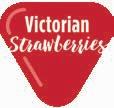
Victoria & South Australia
Dr Angela Atkinson, Berry Industry Development Officer 0408 416 538 | ido@vicstrawberry.com.au
At the time of writing this we are having beautiful autumn weather here in the Yarra Valley; cold nights and mornings, with clear sunny days, perfect for preparation for next season. As the season winds up everyone will be looking forward to a well-earned break. As strawberry growers prepare for next season, the article in this edition of the journal about plant back timing after soil fumigation is very relevant (SEE PAGE 87), with Scott and Dylan from VSICA Research fine-tuning their in-field tests for fumigant levels.

This has become increasingly important with the widespread adoption of totally impermeable films (TIF) in strawberry production in Victoria meaning that fumigants potentially remain in the soil longer which can impact runners or plugs planted too soon.
In early April, the Australian Strawberry Breeding Program held a farm walk at the Wandin Research Farm after the Program Reference Group meeting for the project, so growers could have a look at potential new plants coming out of the program, and provide feedback.
 Victorian Strawberry Industry Development Committee
Victorian Strawberry Industry Development Committee
8 INDUSTRY BERRY AUSTRALIAN JOURNAL WINTER 2024 EDITION 19
Wandin Research Farm. Photo credit: Angela Atkinson
Before the meeting and farm walk, I had the opportunity to show Adrian Englefield, Hort Innovation’s Berry Industry Services and Delivery Manager (ISDM), some aspects of strawberry production in Victoria.
We visited the Victorian Strawberry Industry Certification Authority (VSICA), so Adrian could see how the nucleus and mother stock are grown and maintained and learn about the processes involved in the production of certified strawberry planting material in Victoria.
In Toolangi we also visited Perry’s Certified Strawberry Runner Growers to see how strawberry plug plants are produced. Finally, we visited Australian Strawberry Distributors in Coldstream to see strawberry tabletop production in their Cravo greenhouse system. Thanks to Corina Horstra (VSICA), Shane Perry (Perry Runners) and Joe Ripepi (ASD) for giving up their time to show us around.
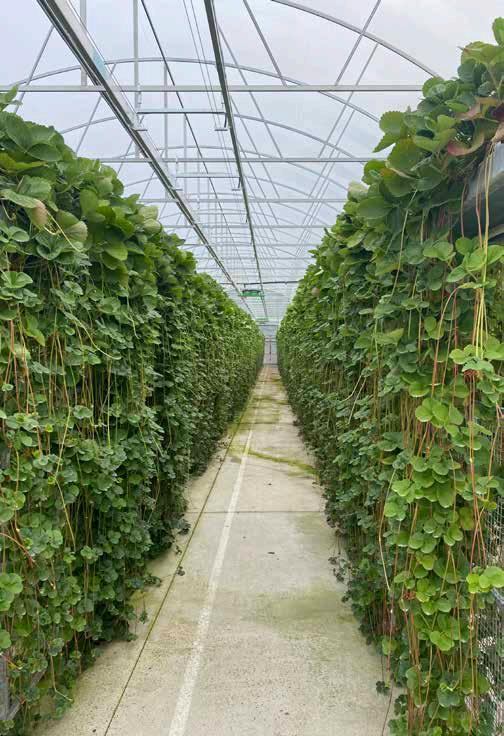
We have a series of grower events planned for the offseason, and leading into next season. The first event was a field day held at Spirli Strawberries in Wandin North on 9 May, with the team from Polybee in Singapore who have been conducting on-farm trials there.
Polybee have been working with tomatoes and strawberries to develop Autonomous Pollination using small drones, as well as developing a yield forecasting App.
For more information about Polybee, you can download the article from the Spring 2023 edition of this journal at our online Resource Library. Visit berries.net.au/resource-library and type ‘polybee’ into the search box
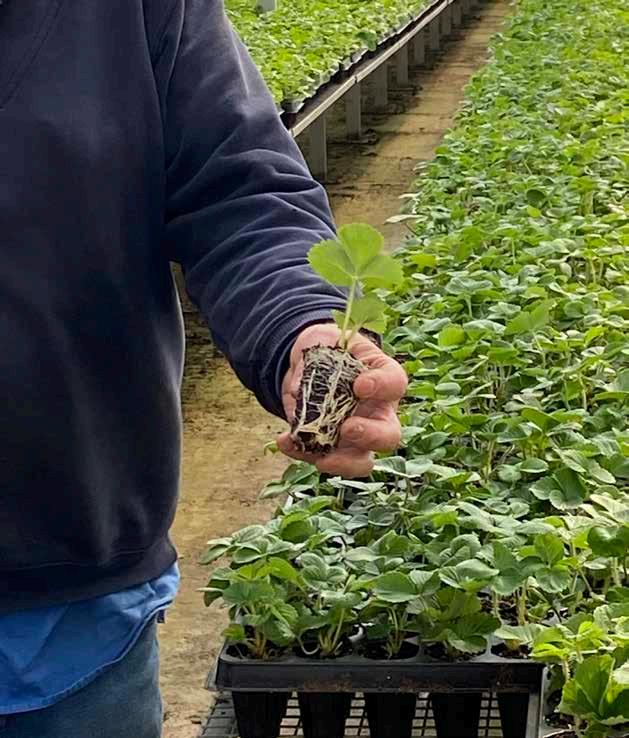 Foundation screen house, VSICA
Photo credit: Angela Atkinson
Plug plants at Perry’s Certified Strawberry Runner Growers. Photo credit: Angela Atkinson
Foundation screen house, VSICA
Photo credit: Angela Atkinson
Plug plants at Perry’s Certified Strawberry Runner Growers. Photo credit: Angela Atkinson
9
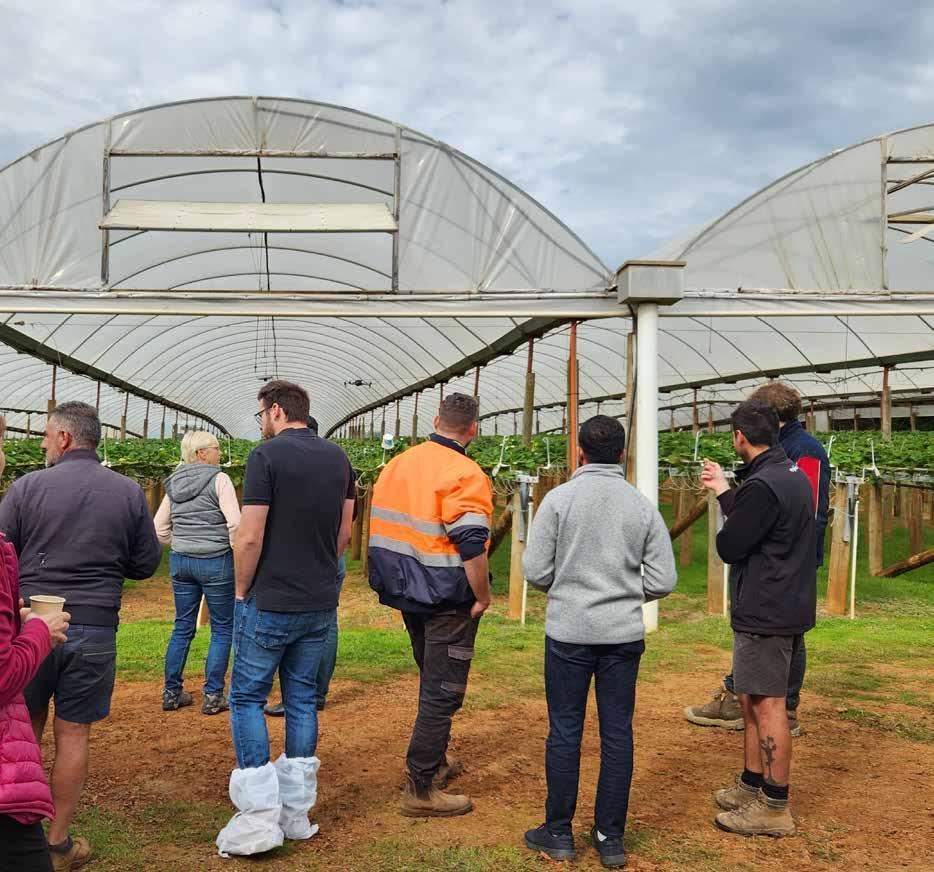

Currently the yield forecasting is done using video captured on a smart phone, but ultimately they intend to use drones to capture the information. There are lots of possibilities going forward for using the images captured, including looking for areas in crops under stress or disease pressure.
They were able to demonstrate the drones used in pollination in the strawberry tunnels after their presentation which was really interesting. In addition to the photos here, we have recordings of the drone and their presentation which will be available on the Resource Library at the Berries Australia website
Finally, this will be my last regional update as IDO for Victoria and South Australia, as I will be starting in a new role as R&D and Biosecurity Manager with Berries Australia from 1 July.
I will still be working with growers, researchers and other industry stakeholders in the new role, just in a different capacity.
I have enjoyed my time in the IDO role immensely, and will continue to work with the industry to support R&D and biosecurity nationally.
Demonstration of drone for autonomous pollination
Photo credit: Clarissa Cincotta
Drone in action
10 BERRY AUSTRALIAN JOURNAL WINTER 2024 EDITION 19
Photo credit: Angela Atkinson
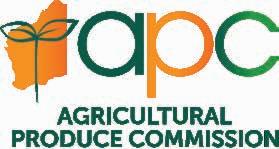
Climate and crop
Western Australia
Helen Newman, Industry Development Officer, Agricultural Produce Commission
Scorching summer temperatures reported in the last update continued into February which was exceptionally warm with mean maximum temperatures 2–4°C above average across growing regions. An unprecedented high number of extremely hot days with maximum temperatures of at least 40°C were also recorded. Pearce RAAF base to the north of Perth reached a record-breaking 46.1°C on 19 February. A fourth severe-intensity heatwave for the summer was recorded on 17-21 February. Warmer than normal temperatures continued into autumn with maximum temperatures 1–2°C above average in March and 1–4°C above average in April. The impacts of the very hot summer, warm autumn, and a notable absence of soil moisture are evident throughout the southwest landscape with the death of many well-established native trees and understory plants. Water storages in some regions are also under pressure. Warmer than average temperatures are expected to continue for the next three months and below average rainfall is expected in May.
The hot dry conditions have provided the perfect environment for the Chilli thrip to thrive. Early-season blueberry crops have been the most affected, with warm weather and high population numbers persisting into the flowering stage.
Strawberry growers have had a good start to their planting season with the very hot temperatures dropping away just in time for new season plantings. The continued warm weather is helping plants to get well established before soil temperatures are expected to drop off in late May/June.
Industry news
Food safety standards: Implementation of the new Primary Production and Processing Standards for leafy vegetables, melons, and berries is underway in WA.

If you haven’t already, please complete the WA Health Department survey so that you can be connected with your Local Government Authority who will be implementing the standard in your area: https://datalibrary-rc.health.wa.gov.au/ surveys/?s=EMFW8RCAY8P9HW9J
Emergency Use Permit for Chilli thrip: The APVMA issued a permit for the use of Simodis® Plinazolin technology Insecticide (isocycloseram) for Chilli thrip suppression in Blueberries, Rubus, and second-year Strawberries in early April. SEE PAGE 21
Fungicide-resistant botrytis: Associate Professor Fran Lopez-Ruiz from The Fungicide Resistance Group at Curtin University has been testing berry samples at the retail level in WA and has uncovered alarming levels of fungicide resistant botrytis. If you think you are having issues with fungicide resistance in your berries let me know and I’ll collect a sample for lab testing.
Blueberry Pest and Disease Event: A BIG thank you to Costa in Neergabby for hosting the first WA Blueberry Field Day on 30 April. The weather for the first part of the day was terrible (cold wind, lightning, and then rain), but when the sun came out after lunch, we enjoyed a walk in the field and more discussion around pest and Chilli thrip management. Stuart Doyle from AgVista shared his extensive knowledge of blueberry pest and disease management and highlighted some key international pests on the horizon. Brendon Fewster, Director of the Bee Industry Council of WA, spoke about how to care for bees used for blueberry pollination and the potential impact Varroa mites will have if they reach WA. The 40-strong crowd also participated in a Chilli thrip discussion with input from participating growers, Stuart Doyle, Biological services, DPIRD Entomologists, and chemical suppliers. Before we ventured back outside, Luca Zanini took us on a tour of the Costa packing shed from the forced-air-cooler through the end of the packing line.
11 INDUSTRY
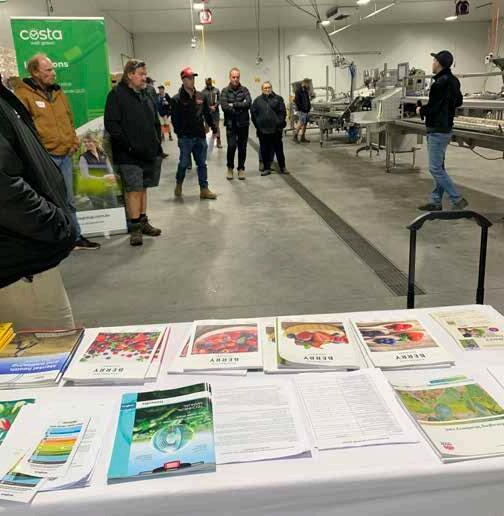
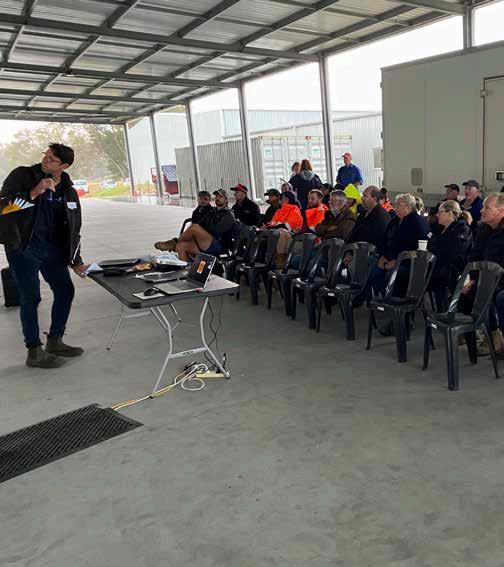
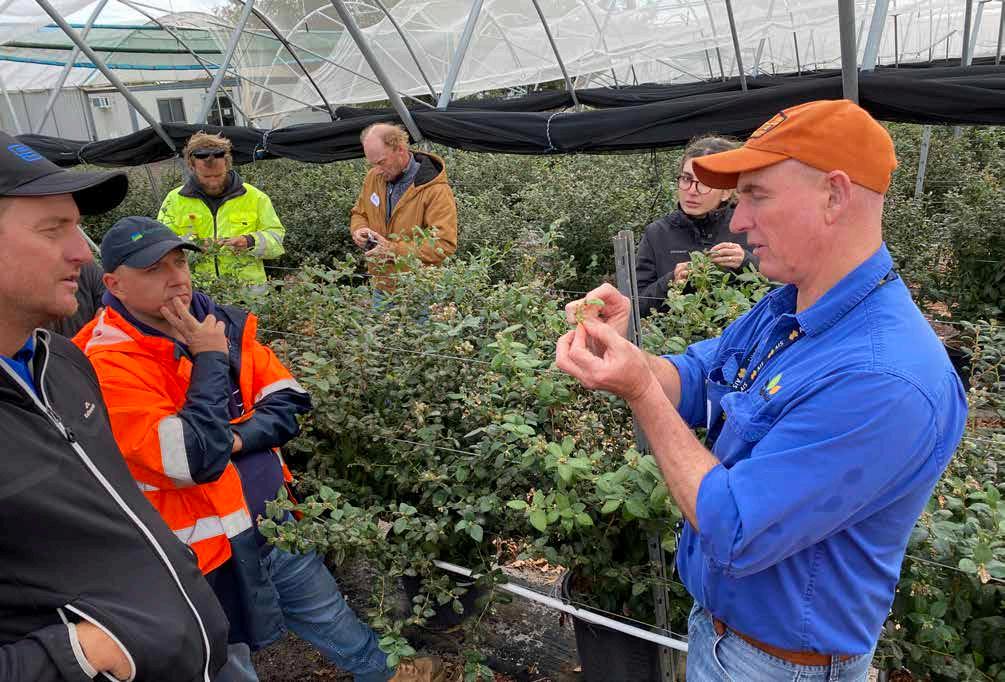 Attendees enjoyed a tour of the Costa packing shed
Photo credit: Katrina Hill, Vegetables WA
Brendon Fewster, Director of the Bee Industry Council of WA spoke to the group. Photo credit: Helen Newman
Attendees at the Blueberry Field Day on 30 April braved the weather to learn from industry expert Stuart Doyle.
Attendees enjoyed a tour of the Costa packing shed
Photo credit: Katrina Hill, Vegetables WA
Brendon Fewster, Director of the Bee Industry Council of WA spoke to the group. Photo credit: Helen Newman
Attendees at the Blueberry Field Day on 30 April braved the weather to learn from industry expert Stuart Doyle.
12 BERRY AUSTRALIAN JOURNAL WINTER 2024 EDITION 19
Photo credit: Helen Newman
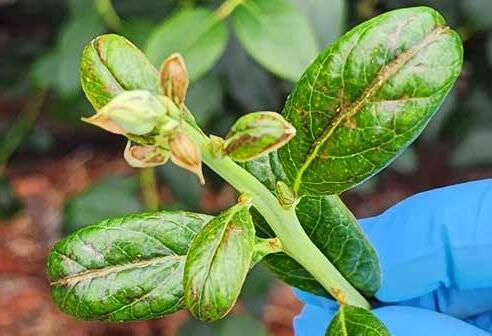
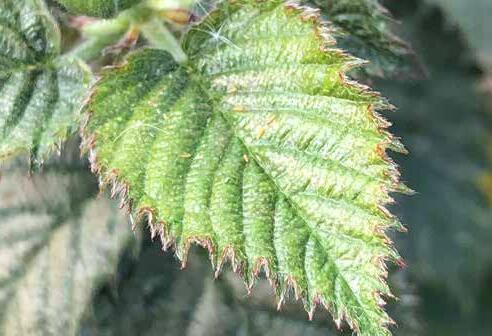

Chilli thrip management ideas
Potential chemical, biological, and cultural options for managing Chilli thrips were discussed at the Blueberry event on 30 April. Those that were of most interest are listed here.
Some additional chemistries that could be tested:
• Cyantraniliprole (Benevia ®) Group 28
• Broflanilide (Cimegra ®) Group 30
• Dimpropyridaz (Efficon ®) Group 36
• Clitoria Ternatea Extract (Sero-X ®)
A rotation of softer chemistries that can be used with biological controls is ideal but knockdowns for emergencies can sometimes be useful. Sero-X ® is particularly interesting because it is a non-toxic, bee-friendly, plant extract botanical pesticide.
Some biological controls that could be tested:
• Predatory nematode Steinernema feltiae: this nematode feeds on pupae and larvae mainly in the soil/substrate
• Predatory thrip Franklinothrips vespiformis: this thrip potentially feeds on all life stages. Biological Services are currently running trials with this predatory thrip
• Banker plants to support the establishment and retention of beneficial insects: e.g. Sweet alyssum
Other potential management options:
• Entomopathogenic Fungi (soil and foliar applications). Spores germinate and hyphae penetrate the thrip's body cavity where they proliferate and destroy the tissues
• Overhead watering to knock thrips off the foliage onto the ground where they are vulnerable
• Reflective mulch under the plants to deter thrips from entering the crop
• Barriers over the pot or ground to stop the thrip pupae from dropping into substrate/soil and prevent any existing pupae from emerging
• Coloured netting (such as red netting) to deter thrips from entering the crop
An understanding of Chilli thrip population dynamics in WA blueberry crops is also still required. Entomologists at DPIRD now have some capacity to assist in this area and planning is underway for glasshouse trials next spring.
The appearance of bronzing on new flush may be the first indication of the chilli thrip's presence in blueberries
Photo credit: Cezar Moraes, Biological Services
Early signs of chilli thrip damage in blackberry are browning and dehydration of the leaf margins
Photo credit: Elliot Howse, DPIRD
Heavy feeding by chilli thrips in strawberry causes reddening and darkening of leaf veins and petioles
For a more information about Chilli thrip, visit our RESOURCE LIBRARY online at berries.net.au/resource-library and type 'chilli' in the Search box 13
Photo credit: Cezar Moraes, Biological Services


Tasmania
Mark Salter, Berry Industry Development Officer 0400 100 593 | berryido@fruitgrowerstas.org.au
Tasmania’s berry season is now at its tail end and from all reports it’s been a good season as far as production is concerned.
I recently had the pleasure of visiting Queensland berry growers in Caboolture and Stanthorpe as part of a visit organised by Queensland IDO Wendy Morris. As we visited local strawberry growers it was clear planting has been delayed again this year by above average rainfall. It was great to see how the early season Rubus production was progressing in both regions with some growers only weeks away from harvest. SEE PAGE 53
Until recently, blueberry growers have been reluctant to travel to other farms because of the blueberry rust issue. This was particularly evident during the years when the Tasmanian blueberry industry was trying to contain and eradicate the disease, following a government regulated containment plan which restricted movement between farms. Unfortunately, blueberry rust eradication was unsuccessful, and the plan was deregulated in 2022. Following the decision to lift blueberry rust restrictions, growers have become more relaxed about visiting other farms and indicated they would like to get together for on-farm workshops and field days.
Taking this feedback on board, Fruit Growers Tasmania and Berries Australia recently held a Blueberry Growers Field Day at Griggs Bros, Castle Forbes Bay in the state’s south. More than 30 growers and industry people attended the day which included presentations from Stuart Doyle from AgVista on pest and disease issues. NSW IDO and blueberry specialist Gaius Leong travelled down to give an informative presentation on nutrition for blueberries. Kara Berry from the Tasmanian Institute of Agriculture gave growers an update on the blueberry rust project her team is conducting, including results on the various defoliation treatments. The morning session concluded with Kate Dickenson from Fruit Growers Tasmania giving an interesting and informative presentation on trade and export opportunities for blueberries.

Following lunch, those attending had a chance to view the blueberry rust defoliation trials Kara and her team are conducting at Griggs Bros. SEE PAGE 94
The next day Gaius and I took the opportunity to visit berry farms in the south and southeast. Visiting Piñata Farms at Orielton, we looked at their strawberry and raspberry production and had a chance to view their packing line in action, with many thanks to Jan Booysen for showing us around the site. From there it was a trip south to visit Tru Blu Berries at Lymington where we met with Damian Clark and Sharon Keetch who manage 13ha of blueberries. Damian explained they are growing northern highbush public varieties, all grown in the ground under bird net. While there, Gaius took the opportunity to share his knowledge on nutrition and pruning techniques with Damian. On our way back to Hobart we dropped in to visit Stuart Griggs from Griggs Bros who was keen to get some advice on pruning techniques to help control vigour in some of his plants, and after further discussion Gaius was able to help with some pointers on various pruning techniques.
As this will be my last report before retiring, I would like to take the opportunity to thank berry growers both in Tasmania and the mainland for your support. I have enjoyed the Industry Development role and particularly enjoyed wcommunicating and working with growers; at the end of the day you are the reason we are here.
I would also like to thank Rachel Mackenzie, the Berry IDO team and staff for your support and encouragement. I would also like to thank Peter Cornish and the team at Fruit Growers Tasmania; it has been a pleasure to work with you.
Thank you again and all the best for the future.
14 INDUSTRY BERRY AUSTRALIAN JOURNAL WINTER 2024 EDITION 19

Queensland
Wendy Morris, Berry Industry Development Officer 0484 272 963 | qldberryido@berries.net.au
With autumn finally upon us, many of us are reflecting on the weather forecast and wondering what lies ahead. One thing is for certain; it is keeping growers on their toes as they continually adapt to changing weather conditions.
The end of the Stanthorpe strawberry season was hot, with fruit size being affected. Despite the smaller size, the fruit still ate well. Raspberry growers in various locations were also battling the heat, with plants protesting the number of hot, humid days.
On the coast, our Sunshine Coast and Bundaberg strawberry growers have commenced planting. Field preparation was hurried for many growers who battled to find a break in the weather to put down plastic. For a number of growers, one field was being planted while another was still being prepped.
Variety substitutions continue to be part of the challenges growers face, as well as the usual gamut of pests and diseases. Fall armyworm is looking to become increasingly problematic, with the distribution and concentration appearing to be on the increase.
In 2023, we saw several occasions where retailers rejected low quality fruit. This fruit subsequently made it’s way to the market floor, where it negatively impacted prices for all growers. From there, very lowquality fruit often ends up in ‘bottom rung’ fruit and veg stores, where it is bought by unsuspecting consumers.
We know that a consumer who has a bad experience with a fruit or vegetable will typically wait around six weeks before buying it again. As such, poor quality strawberries have a disastrous impact not only on growers who receive low pricing, but on consumer confidence.
This winter season, I’m working closely with DAF and the Queensland Strawberry Growers Association to provide timely information throughout the growing

season on what pests and diseases we are noticing or anticipating. This information is not designed to replace thorough agronomic advice, but to act alongside it, and to assist those who are either inexperienced growers or who do not have the funds to pay for personalised agronomy advice. We find it is often the latter group who is most vulnerable to pest and disease problems.
Another important topic for growers is water quality, particularly in the Pumicestone Passage area. Regular testing of the water at Six Mile Creek and Coochin Creek continues and it is a timely reminder to all to ensure that good spray and run-off management practices are always adhered to.
To ensure our growers do not find themselves facing the same social license issues as the Northern NSW blueberry growers, the Queensland Strawberry Growers Association have been in contact with a number of growers whose properties abound Six Mile and Coochin Creeks to ensure they are comfortable with their measures of control for nitrate and sediment run off. It has been great that the QSGA and our growers are so proactive on this front.
If you are a grower who operates in the Six Mile or Coochin Creeks and have any concerns at all please feel free to contact me at any time. I can connect you with any existing resources as well as assist with identifying any potential grants or funding available to help you to make improvements on your farm to better manage water quality.
On the topic of water, The Department of Natural Resources, Mines and Energy has engaged a consultancy to investigate water security in the SEQ region. During farm visits growers in this region will be asked about the source of your water, and any concerns you may have. Gathering this information is crucial if our industry is to survive and expand.
It hasn’t all been serious business over the past three months. I have attended a number of interesting and informative events, including the AllClass Kubota
15 INDUSTRY

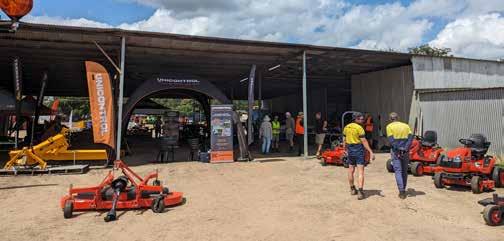
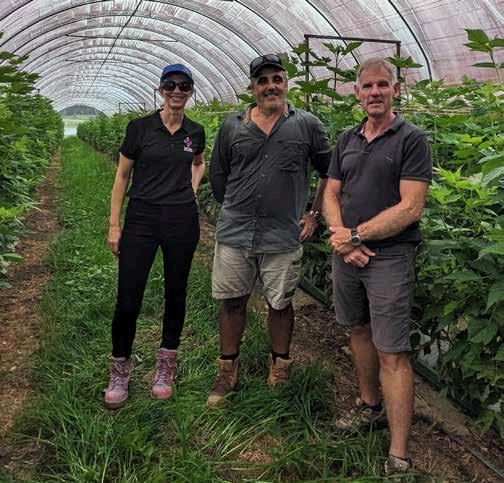
Open Day, 3rd Smart Agricultural Symposium at Griffith University and the Clean Coastal Catchments (CCC) in March Field Day down in NSW (SEE PAGE 98) where I expanded my knowledge about ways to better manage irrigation run off.
Back home in not-so-sunny Queensland, Tasmanian IDO Mark Salter and I met with raspberry growers. As part of Mark’s tour, we held grower dinners in Caboolture and Stanthorpe for all berry growers, and it was fabulous to have so many attendees. These were great opportunities to connect with industry experts as well as fellow growers. SEE PAGE 53
One of our guests at the Caboolture dinner was Amy Nash from Queensland Agriculture Workforce Network (QAWN). QAWN is a regional network of industry-based agricultural workforce officers, directly supporting producers and operators across the supply chain. Officers can provide a broad range of advice and guidance to assist with addressing recruitment and skilling issues. This is a free service available to any agribusiness with operations in Queensland, regardless of commodity or organisation membership. Through extensive links with employment and training providers across the state, a QAWN representative can support any agribusiness trying to understand or access strategies to both identify and meet future workforce or training needs.
QAWN officers can support you with advice about:
• Workforce planning
• Sourcing labour and skilled workers
• Recruitment induction
• Requirements
• Funded training opportunities
There are seven QAWN officers positioned across Queensland, hosted by industry or economic bodies. Your regional officer can be identified and contacted at www.business.qld.gov.au/industries/farms-fishingforestry/agriculture/business/workforce/qawn
QAWN is funded by the Department of Agriculture and Fisheries
Further events were held in Bundaberg (22 May) and planned for Nambour (July). If you have not attended a Berries Australia event before, we strongly encourage you to come along. If you don’t know any other berry growers, let me know beforehand as I’m happy to introduce you.
News of our events and other important industry information is frequently shared through our monthly e-newsletter, and now on our Facebook and LinkedIn pages so why not follow us to get our updates
FACEBOOK-SQUARE www.facebook.com/berriesaus linkedin-in www.linkedin.com/company/berries-australia
1 3 2
(1) Irrigation Shed at CCC Field Day (2) (L-R) Wendy Morris, Angelo Pinna & Mark Salter at Angelo’s Wamuran Farm (3) AllClass Kubota Open Day. Photo credit: Wendy Morris
16 BERRY AUSTRALIAN JOURNAL WINTER 2024 EDITION 19
New South Wales
Gaius Leong, Berry Industry Development Officer
0484 055 748 | gaius.leong@dpi.nsw.gov.au
Thoughts of a drier winter accompanied by lower disease pressure have all but vanished. At the time of writing (early May), there have been frequent rainy days and the forecast is for rainy weather with overcast days for this week along the mid north coast of NSW. A continued lack of pollinating days and increased disease pressure is expected with the current and forecast weather. This again emphasises the benefits derived from protected cropping, in particular reduced disease pressure and increased shelf life without the need to compromise on the harvest schedule.
Talking about production systems, I am thankful for the opportunity to visit beautiful Tasmania recently and to catch up with the wonderful growers and Fruit Growers Tasmania team. Whilst in Tasmania I presented on blueberry soil nutrition at the Field Day held on 18 April (SEE PAGE 94), Mark Salter (TAS IDO) showed me around the berry farms, and it struck me how different the soil production systems are between southern Tasmania and mid north coast New South Wales. The biggest difference is in the soil organic matter (SOM) content and the nutrition that the organic fraction provided to the crop.
Looking at some of the soil analyses, it is common for soils in Tasmania’s blueberry production systems to have organic matter contents of 8-10 % compared to the NSW mid north coast region’s 2-4%. The application of mulch under fertigation system in Tasmania compared to the use of weed mat (NSW) plays an important role in increasing the organic matter content of soils overtime. This higher organic matter level allows blueberry growers not only to reduce their fertiliser inputs but also ensures better soil structure which assists with a healthier root system.
In addition to blueberry systems, we visited Piñata Farms and tasted their incredible raspberries and tabletop strawberries. The highlights include the fantastic flavour profile of both their berry categories and innovative V-trellis system for raspberry production.

The potential to create organic production systems and reduce reliance on conventional chemistry allows a more holistic approach to producing berries. This is evidently possible in Tasmania with the cooler climate (lower pest/disease/weed pressure) and deciduous, compact phenological stages. Comparatively, the climate along NSW’s mid-north coast increases the potential range of diseases, weeds, and pests. This accompanied by multiple phenological stages across the production cycle makes it extremely difficult to achieve economic viability without chemical interventions. As such, ensuring resistance management strategies are used is an important part of ensuring the current available chemistry stays viable for longer.
For example, with Botrytis management, most growers can attest to the efficacy when using certain chemistry compared to others which are available. The most common strategy is to rotate chemical groups so that the pathogen or pest is not repeatedly treated with the same mode of action. All registered pesticides have a symbol on the label which identifies the action group to which it belongs. This assists growers in choosing a different mode of action when seeking to rotate chemicals in a program.
For strawberry growers, you can see more about fungicide resistance management in Apollo Gomez’s article on PAGE 81.
Research into resistance screening of old and new chemical formulations, along with having access to efficacious chemistries must not be overlooked even as we push towards more effective biological controls.
In addition to the trip to Tasmania, we have been busy with a range of projects and workshops. Notably, a dam (source for irrigation) water quality workshop held in Woolgoolga (SEE PAGE 104). We will look at creating a similar workshop for growers in the southern growing region around Macksville.
17 INDUSTRY
Varroa destructor –Transition to Management: what happens now?
Angela Atkinson, Berry Industry Development Officer, Victoria & SA
• Varroa mite (Varroa destructor), the most serious pest of European honey bees, was detected for the first time in Australia at the Port of Newcastle (NSW) in June 2022
• An emergency response was initiated according to the Emergency Plant Pest Response Deed (EPPRD) supported by the Commonwealth, state and territory governments, and agricultural industries potentially affected by this pest
• Both the strawberry and Rubus industries were involved in this response, as signatories to the EPPRD
• The Response was led by the NSW Department of Primary Industries, and was the largest agricultural biosecurity response in Australia to date
• In September 2023 the National Management Group (NMG) agreed it was no longer feasible to eradicate Varroa mite and a plan to assist industry and the community to transition to management (T2M) was developed
• The T2M plan was approved in February 2024
The aim of the T2M plan is to provide an orderly transition from the response program which focused on eradication, to management of the pest while minimising the ongoing effects of Varroa mite naturalisation on the European honey bee industry and pollinationreliant industries.
The plan focuses on maintaining business continuity for the honey bee industry and the horticulture industries that rely on honey bee pollination.
It aims to slow the spread of Varroa mite to allow beekeepers, pollination-dependent industries and the community sufficient time to prepare for the inevitable spread of Varroa mite.
The T2M plan will be delivered over 24 months to allow for recruitment of personnel, with the majority of activities delivered during the first 12 months.
There are four objectives within the plan:
• Completion of activities under the response plan
• Building industry resilience
• Slowing the spread of Varroa mite
• Future-ready industries
18 INDUSTRY BERRY AUSTRALIAN JOURNAL WINTER 2024 EDITION 19
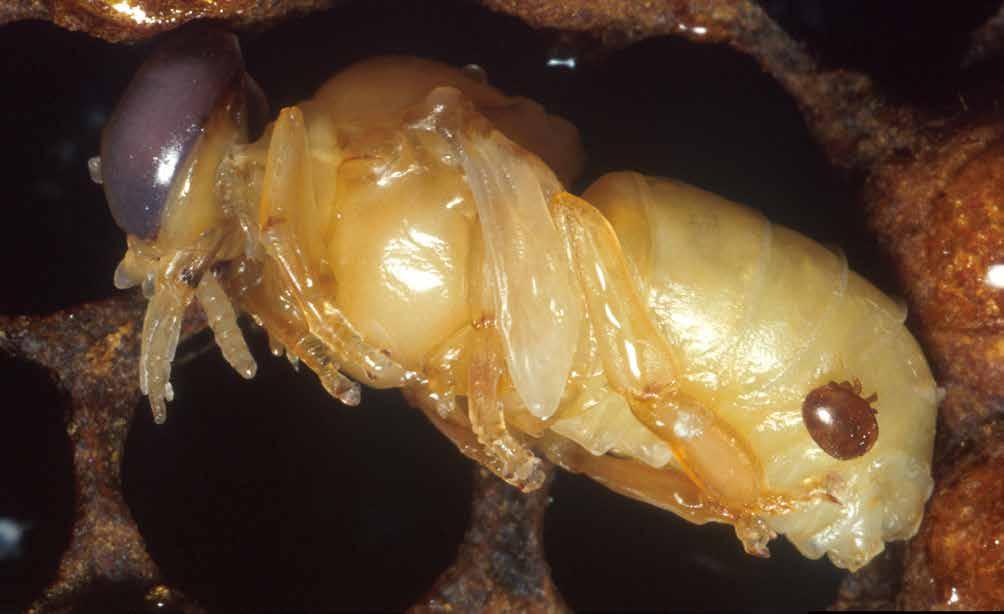
Completion of the activities planned under Response Plan Version 3
All activities associated with eradication were completed by March 2024, including tracing and surveillance for infested premises, opt-in hive euthanasia for beekeepers who were in previous eradication zones, and wild European honey bee surveillance and baiting.
The NSW DPI compliance team are continuing to investigate complaints and progress prosecutions relating to offences under the Eradication phase of the response.
Building industry resilience
It was agreed by all industries involved that the most effective way to prepare for the impact of Varroa mites is to train beekeepers and provide them with the skills they need to manage Varroa mite and maintain healthy hives.
Over 70% of the budget is allocated to delivery of training and extension services to achieve this. Under the T2M plan, tailored resources are being developed to provide accessible, current and consistent information and training programs for best practice beekeeping in the Australian context.
Training will include nationally delivered online and face-to-face training for beekeepers, by state-based trainers who have completed a ‘Train the Trainer’ program delivered by Tocal College, NSW DPI technical specialists and Bee Biosecurity Officers.
The Australian Honey Bee Industry Biosecurity Code of Practice and the Bee Biosecurity Manual will also be updated as part of the T2M plan. The Code of Practice provides a framework for beekeepers to use best practice biosecurity measures to achieve pest and disease prevention and control.
Varroa Development Officers (VDOs) will be engaged in each state to work with commercial and recreational beekeepers to promote best management practice guidelines and resolve problems. The VDOs will also establish, coordinate and maintain a voluntary Varroa mite monitoring program, in collaboration with volunteer beekeepers and beekeeping clubs.
For pollination-dependent industries, a National Pollination Industry Coordinator (PIC) will work with industries to identify their concerns, knowledge gaps and future needs related to managing pollination.
19
An adult female Varroa mite feeds on a developing bee. Photo credit: Scott Bauer, USDA Agricultural Research Service, Bugwood.org
The PIC will coordinate the development of resources specific to the needs of pollination-dependent industries and will work with existing IDO networks to support delivery of resources to growers. The PIC will act as a key point of contact for IDOs to clarify information or raise concerns about industry needs. The VDOs may also work with plant industries, where a beekeeping perspective is required for engagement with growers. While diagnostic capability and capacity within NSW have been well established through the emergency response, more work is required to bolster this on a national scale to support ongoing surveillance and management needs. The T2M plan will share knowledge and expertise to enable interstate diagnostic laboratories to detect Varroa mite and associated exotic viruses quickly.
Slowing the spread of Varroa mite
After the decision that Varroa mite was no longer technically feasible to eradicate, NSW introduced biosecurity zones aimed at preventing the movement of heavily infested colonies throughout NSW. These zones will be kept in place for no longer than 12 months. Varroa mite will remain a notifiable pest in NSW.
Other states are considering options for consistent movement conditions for bees, queens, hives and other associated material across borders, that are practical, least restrictive to trade, technically justified and address the risks to support business continuity and pollination security.
Beekeepers in NSW will be audited to ensure they comply with monitoring and reporting requirements, and conditions of beekeeper registration. Compliance activities in Vic, SA and Qld will focus on interstate movement of risk material to ensure compliance with permitted movement. Activities may change if Varroa is detected in other states.
The VDOs will engage with beekeepers on a voluntary basis to help them undertake surveillance activities in their apiaries, to facilitate the collection of surveillance data from managed commercial and recreational hives. This data will support decisions around intra- and interstate regulation aimed at slowing the spread, and help to measure the success of the T2M program.
Future-ready industries
As part of the T2M plan, a survey similar to COLOSS will be initiated, to help understand the effects of Varroa mite and how it is being managed. COLOSS is a global initiative which conducts standardised colony loss surveys in 30 countries to better understand the risk factors of colony loss. This would be initiated for Australia as part of the T2M plan, with support beyond the plan being provided through alternative funding mechanisms.
A system will also be introduced to collate and analyse monitoring and surveillance data nationwide, in order to map the spread of Varroa mite over the next 3 to 5 years. Consistent data reporting is important, as the beekeeping industry is mobile, with hives moving across state borders to provide pollination services.
Upskilling of queen bee breeders will also help to futureproof the industry, to enable breeders to use advanced techniques for the selection of Varroa mite-resistant queens and improve breeding for Varroa mite tolerance.
Finally, the T2M plan will include a review of current research supporting greater pollination efficiency in a post-Varroa mite Australia, and provide recommendations for further work to support future ready industries.
The establishment of Varroa mite in Australia will radically change the way European honey bees are managed, and potentially the access to pollination for industries that rely on honey bees. The activities in the T2M plan have been developed to provide the knowledge and tools needed to minimise the impact of this pest to beekeepers, pollination-dependent industries and the community, and enable management of Varroa mite in the long term.
More Information
The Australian Honey Bee Industry Council (AHBIC), in collaboration with AgriFutures Honey Bee & Pollination program, is hosting a series of podcasts and interviews on Varroa mite which can be accessed at https://honeybee.org.au/varroa/ podcasts-webinars
For more information about the transition to management go to bit.ly/VM-NSW or honeybee.org.au
20 BERRY AUSTRALIAN JOURNAL WINTER 2024 EDITION 19
SIMODIS® insecticide: Emergency Use Permit for Chilli thrip in berries
Helen Newman, Berry Industry Development Officer, Agricultural Produce Commission, WA
Thrips are notorious for developing insecticide resistance so any control strategy must use a combination of methods including cultural and biological controls and a rotation of different chemistries.
SIMODIS® is classified as a Group 30 insecticide (active ingredient Isocycloseram). It is the first Group 30 insecticide to be permitted on berries and adds to the rotation of chemistries that can be used during the vegetative stage of the crop cycle.
This chemical is not permitted for use during flowering and fruiting
SIMODIS® is a foliar applied contact insecticide, with no translaminar (systemic) movement in the plant. The active ingredient is absorbed by insect pests either through contact or by ingestion while feeding. Within 13 hours of contact or ingestion, insect pests stop moving.
SIMODIS® suppresses Chilli thrips with the first application. The second application 7 to 10 days later controls the thrip.
To help manage resistance to this new chemistry, a maximum of two applications per season are permitted.
SIMODIS® is toxic to bees and beneficial arthropods. It cannot be used on flowering berry crops and any nearby managed hives must be moved away from sprayed areas and provided with a safe source of nectar and pollen. Bees and predators used in IPM programs can be released into the crop 28 days after the final application of SIMODIS®
Mode of Action
SIMODIS® insecticide works on the insect’s nervous system to block an important mechanism for controlling nerve to muscle communication. The target site in the nervous system is in the GABA (gamma-aminobutyric acid) receptor. These receptors control how electrical signals pass from one nerve cell to another. When the active ingredient in SIMODIS® insecticide stops the receptors from working, the nervous system goes into overload, resulting in muscular cramps and paralysis of the insect pest. Treated insects and mites are no longer able to move or feed properly, and eventually die from starvation. This novel mode of action has been classified as Group 30 as outlined in the Insecticide Resistance Action Committee guidelines.
INDUSTRY 21
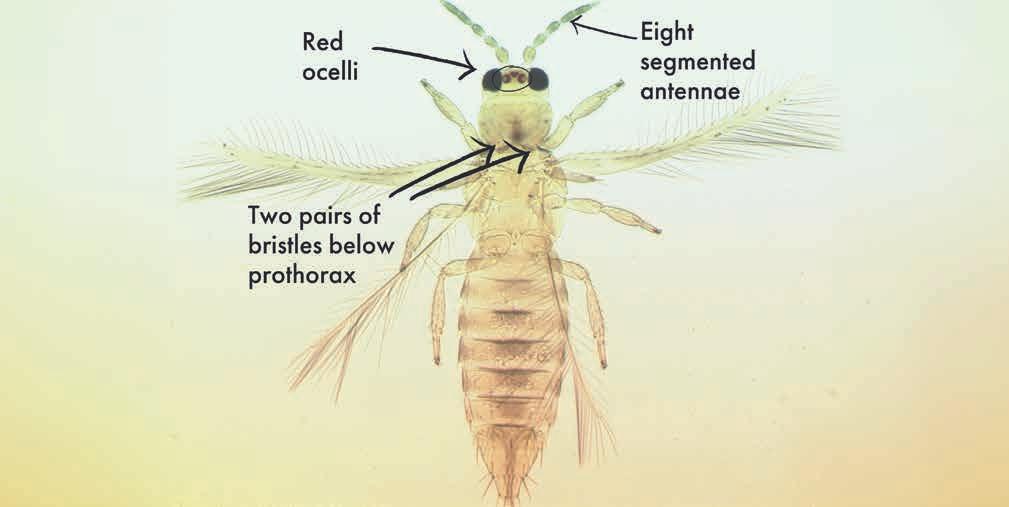
Figure 1. Chilli thrips are pale yellow in colour. They are very small (0.5-1.2mm long) and hard to distinguish from other thrips species without a microscope. Key distinguishing features are shown here.
How Simodis can be used under the Emergency Use Permit
SIMODIS® is registered for use in a variety of vegetable crops where it demonstrates excellent crop safety and helps growers manage resistance in a range of Lepidoptera species, mites, and thrips. Below is a guide to how the chemical can be used on berry crops under Emergency Use Permit PER94616.
Rubus: Only use after pruning/planting when Chilli thrips are present and new growth is developing throughout summer and before flowering. Apply 300mL/ha with a non-ionic surfactant using a vertical sprayer. Ensure thorough coverage of the crop using 500-1000 L/ha.
Blueberries: Only use in evergreen production, apply when Chilli thrips are present after pruning when new growth is developing throughout summer and before flowering. Apply 300mL/ha with a non-ionic surfactant using a vertical sprayer. Ensure thorough coverage of the crop using 600 L/ha.
Strawberries: Only use on second-year plants when Chilli thrips are present in the weeks before they are cut back for second-year production. Apply 300mL/ha with a non-ionic surfactant using a boomspray. Ensure thorough coverage of the crop using 1000 L/ha.
Other considerations
SIMODIS® must not be applied if heavy rains or storms that might cause runoff are forecast within 3 days. Overhead irrigation that wets foliage to the point of runoff must also be avoided for at least 3 days after application.
Spray drift restraints including mandatory downwind buffers between the sprayed crop and natural aquatic areas are also required:
• For second-year strawberry crops, a minimum buffer of 350m between the sprayed and natural aquatic areas is required. Boom sprayers must be set no more than 0.5m above the crop and spray droplets must be no smaller than the ‘COARSE’ spray droplet size category.
• For blueberry and Rubus crops, spray must not be directed above the target canopy and the outside of the sprayer must be turned off when turning at the end of rows and when spraying the outer row on each side of the application site. Where dilute water rates are used, a minimum buffer of 75m between the sprayed and natural aquatic areas is required.
22 BERRY AUSTRALIAN JOURNAL WINTER 2024 EDITION 19
Notes on the formulation
SIMODIS® is a liquid formulation, known as a dispersible concentrate (DC), similar to emulsifiable concentrates (EC). When added to water it completely mixes to give a uniform dispersion. It can be added directly to the spray tank, however, to ensure good compatibility with other tank-mix partners, the following tank-mix order is recommended: This tank mix information and chart, produced with information provided by Syngenta, is not intended to replace product labels. Always check product labels and manufacturer’s tank mix recommendations. If unsure of compatibility, perform a jar test. The physical and chemical properties of various manufacturer’s formulations may differ.

Download the 'Tank Mixing Chemicals' Factsheet from the website RESOURCE LIBRARY by visiting berries.net.au/resource-library and typing 'tank mixing chemicals' in the Search box.
More Information
If you would like to use SIMODIS® on your crop, speak to your local supplier for a detailed overview of the stewardship requirements associated with its use, and always follow the directions of the APVMA permit. Permit on APVMA website: https://permits.apvma.gov.au/PER94616.PDF
Syngenta Simodis web page: https://www.syngenta.com.au/simodis
IPM Notes: Chilli Thrips (Spring 2023 issue of the Australian Berry Journal): Find this article online at our website RESOURCE LIBRARY by visiting berries.net.au/resource-library and typing 'chilli thrip' in the Search box.
23
Reporting Chemical ‘Non-Performances’ or ‘Adverse Experiences’
Jane Richter, Communications Manager, Berries Australia
The Adverse Experience Reporting Program (AERP) is a post-registration program that assesses reports of adverse experiences associated with the use of a registered chemical product (or those on minor use permit). Reports of adverse experiences are closely monitored by the Australian Pesticides and Veterinary Medicines Authority (APVMA) and it is vital to record, assess and classify adverse experiences to detect uncommon events not evident during the initial registration process of a product.
Problems reported with chemical products may result in further regulatory action in accordance with the legislation, for instance, through compliance action or chemical review. If the issue reported is related to control of use, or is otherwise outside the jurisdiction of the APVMA, the information may be referred to the appropriate authority.
What is a ‘non-performance’?
A 'non-performance' or adverse experience is an unintended or unexpected effect on plants, plant products, animals, human beings or the environment, including injury, sensitivity reactions or lack of efficacy associated with the use of an agricultural chemical product(s) when used according to label (or permit) directions.
Why is it important to report nonperformances or adverse experiences with registered chemicals?
Before any agricultural chemical product can be legally supplied, sold, or used in Australia it must be registered by the APVMA. The process to register a chemical for use in Australia is a comprehensive one, with the application being supported by information that allows the APVMA to determine whether they are satisfied that the product meets the applicable ‘statutory criteria’; namely, safety, trade, efficacy and labelling criteria.
For a new agricultural or veterinary (agvet) chemical product that contains a new active constituent, the APVMA must approve the active constituent before it will register the product. Once approved, the active constituent may then be used in new agvet chemical products that are presented for registration.
The process to test the efficacy and safety of a new active constituent – particularly where that active ingredient will be applied to food crops – is a significant one and requires the applicant to provide scientific data to support the application. Despite this rigour, it is impossible for every chemical to be tested fully on every crop in every growing region and so from timeto-time adverse experiences will occur.
As an authorised and trained user of agvet chemicals, it is your responsibility to notice, record and report anything unexpected when using a registered chemical as directed on the label or minor use permit.
24 INDUSTRY BERRY AUSTRALIAN JOURNAL WINTER 2024 EDITION 19
How do I report a non-performance or adverse experience?
If you believe you have had a non-performance or an adverse experience following use of a registered chemical or under a minor use permit, please submit a report via the new online reporting process at bit.ly/APVMA-AE.
This replaces the paper document that previously would have been completed and returned via email.

Once you open the portal, you can submit a report by selecting the 'Start a report' option.
Complete all the required fields (*) and provide as much detail as possible (including details of agronomists reports, test reports etc., where appropriate).
Please note that the information you supply should be accurate and correct.
Partially completed reports can also be saved and resumed at a later time by selecting the 'Resume report' button.
Once you have completed the form, the APVMA will provide a reference number for you to record and quote in any further correspondence about your report.
Further details about the APVMA’s Adverse Experience Reporting Program for Agricultural Chemicals may be found at: http://apvma.gov.au/node/311 or https://portal.apvma.gov.au
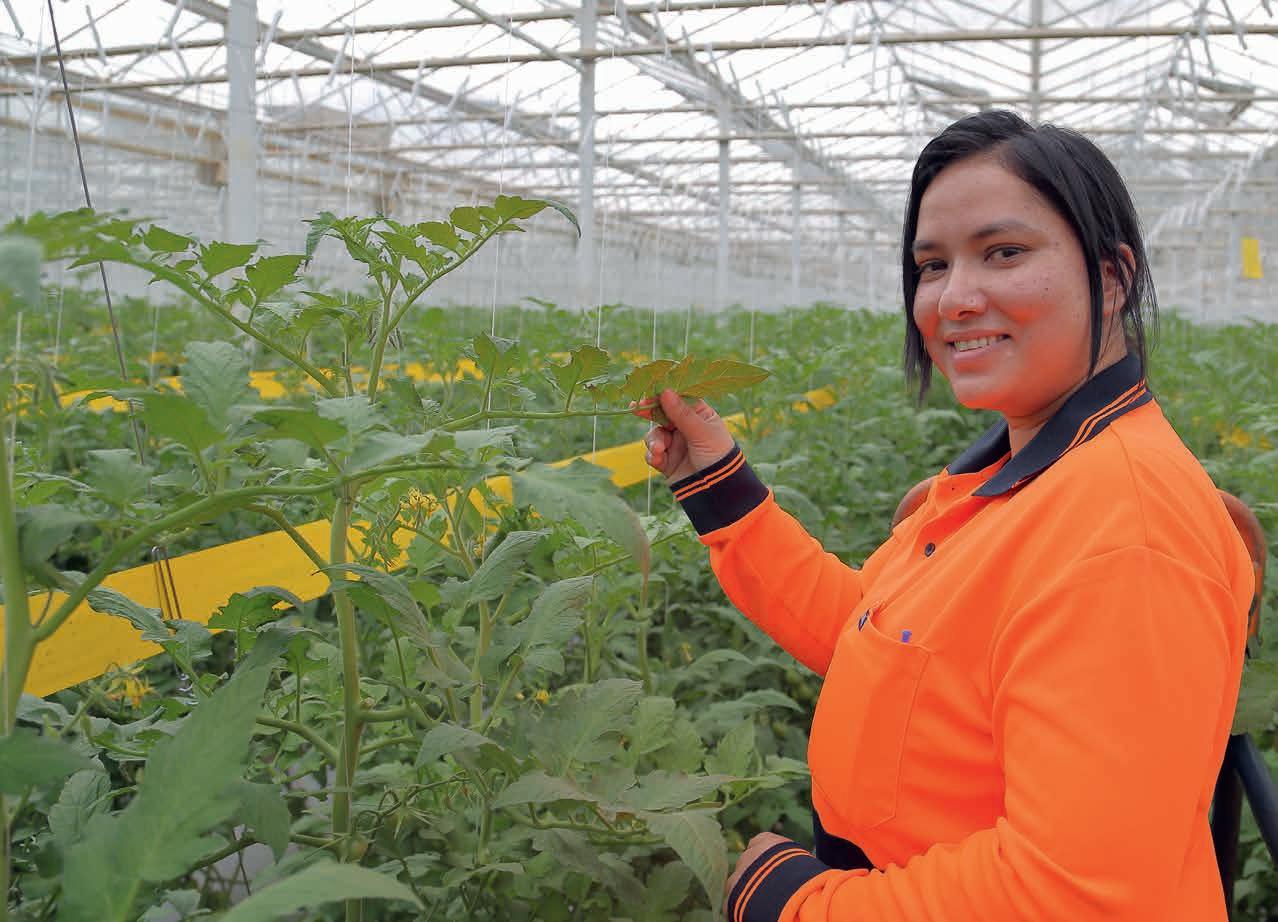
IDO & Communications Project Update: Year 1 Achievements
Jen Rowling, Project Manager, Berries Australia
They say time flies when you’re having fun…well our Industry Development and Communications project team must be having lots of fun because the first year of the new project has absolutely flown by!
The new project – Facilitating the development of the Australian Berry Industry (MT22010) - which kicked off in July 2023 is in full swing and the team got together recently in Melbourne to review the first year of the project and put plans in place for year 2.
This project has been funded by Hort Innovation, using the Blueberry, Strawberry, Raspberry and Blackberry research and development levies and contributions from the Australian Government.
Industry Development
A key aspect of the new project is the flexibility around delivery of information-sharing activities, which allows the Industry Development Officers (IDOs) to coordinate events and resources to suit the grower demographics in each of their regions. There are noticeable differences in how growers like to receive information from state to state and also by commodity and business type, and the flexibility of the project provides the IDOs with the ability to effectively reach a broader cross-section of growers. To date, a range of in-person and online activities have been delivered and have been well attended by growers and industry associates.
The team will continue to focus on the key priority areas that were highlighted from a survey carried out early last year, but again, the project provides the flexibility to address important issues as they arise. The four key areas of priority are:
• Irrigation & nutrient management
• Pest & disease management
• Business & labour management
• New technologies & robotics
Each of the IDOs has a berry specialty and this matrix approach means the team has expertise across the berry categories and can work together to ensure that growers also have access to relevant technical knowledge and experience.
In April, Gaius Leong (blueberry specialist) travelled to Tasmania to visit blueberry growers and participate in a field day coordinated by Mark Salter, presenting on nutrition for blueberries. Attendees also heard from other industry experts covering pest and disease management, blueberry rust and blueberry export for Tasmania and the event attracted over 30 growers and industry associates.
As our Rubus specialist, Mark also travelled to Queensland in April to meet with Rubus growers in both the South East Queensland and Stanthorpe growing regions. The tour was coordinated by Queensland IDO Wendy Morris and gave Rubus growers in the state an opportunity to tap into Mark’s knowledge and experience on Rubus production.
Our Victorian IDO, Angela Atkinson, is the team’s biosecurity specialist and as such has been heavily involved in the national Varroa mite response. Her representation of the berry industry at the countless meetings held since the incursion has helped to ensure that the industry is considered in the response, and provides our team with a thorough understanding of how and why the response has progressed as it has, which can then be communicated with growers and industry.
In WA, Helen Newman has developed a range of translated resources such as fact sheets and articles for the Australian Berry Journal and delivered events with translation for the local Vietnamese strawberry growing community. This has significantly expanded the scope of growers in the state receiving important news and information through the project.
The project team have also worked together on nationally coordinated activities such as a webinar held in February on strawberry nursery plug plant quality and establishment with international expert Klaas Plas as guest speaker. This important topic for the strawberry industry attracted over 150 growers, propagators and industry associates and is a perfect example of how the team were able to respond to a particular issue based on grower feedback. The webinar was recorded and is available to view from our website Resource Library.
With BerryQuest International on the near horizon, a significant part of the IDO workplans for the coming
26 INDUSTRY BERRY AUSTRALIAN JOURNAL WINTER 2024 EDITION 19
year will be focussed on development of the program and farm tours. The end goal is a highly informative, relevant and inspiring suite of speakers and topics for the biannual conference of the Australian Berry Industry taking place in February 2025 in Tasmania. The first year of the project has seen the IDO team work exceptionally well together but there are changes ahead, with Mark (Tas) heading into retirement and Angela Atkinson (Vic) moving into the newly created role of R&D Manager with Berries Australia. Whilst we will miss having them as part of the IDO team, we look forward to welcoming two new IDOs into the fold. Stay tuned for further developments!
Communications
Our Communications Manager, Jane Richter, has continued to compile and produce both print and digital resources for the industry. The first year of the project has delivered:
4 editions of the Australian Berry Journal (Spring 23, Summer 23, Autumn 24 and this edition Winter 24) with a printed copy of each edition distributed to over 850 recipients
12 editions of The Burst e-Newsletter, with 1,775 subscribers and an above average open rate compared to industry average (Agriculture and Food Services)
9 additional news alerts delivered via email to e-News subscribers containing time-sensitive information
A significant increase in the amount of information shared on our social media channels. This is an additional method being utilised to reach growers and stakeholders
The Project Team
with timely messaging and can be quantified with the following stats for the period 1 Jan to 30 Apr 2024:
@berriesaus
948
berries-australia
1,613 page followers with +727 this year 60 posts | 37,560 impressions
2,903 link clicks | 8.4% Engagement Rate
(Note: A 2% LinkedIn engagement rate is
Jane has also worked tirelessly on the development of the new Resource Library which is housed within the Berries Australia website. The library now contains almost 600 documents and resources including factsheets, posters, case studies, research reports, videos and links to resources hosted on other websites. All journal articles since the very first edition of the Australian Berry Journal (2019) are now included in the Library in downloadable PDF format, providing our industry with access to a plethora of information and resources. You can filter by Category, Author or simply type a search term into the ‘Search’ box. This Resource Library will continue to be expanded on an ongoing basis.
Seventeen news articles have also been published to the News section of the website, and industry events are regularly added with the ability to register for events where this is a requirement.
Communications
R&D
Project
Project Manager Jennifer Rowling
Project
Qld
Qld
considered good, and an above 2% engagement rate means you are doing great!)
us: linkedin.com/company/berries-australia
Follow
followers | 83 posts | 3,654 post reach Follow us: facebook.com/berriesaus
Position (Expertise) Name Organisation Location IDO — NSW (Blueberries/Pollination/Chemical/ Next Gen) Gaius Leong NSW DPI Coffs Harbour, NSW IDO — VIC & SA (Strawberries) Vacant VSIDC TBC IDO — QLD (Strawberries) Wendy Morris Berries Australia Brisbane, Qld IDO — TAS (Rubus) Ella Roper* Fruit Growers Tasmania Inc (FGT) Hobart, Tas IDO — WA (Strawberries) Helen Newman APC Perth, WA
Manager Jane Richter Teres Communication Sunshine Coast, Qld
Atkinson Berries Australia Wandin,
and Biosecurity Manager Angela
Vic
Berries
Brisbane,
Leader Rachel Mackenzie
Australia
Berries
Brisbane,
Australia
Berries
Hobart,
Coordinator Claire McCrory
Australia
Tas
*Ella starts her role on 24 June. 27
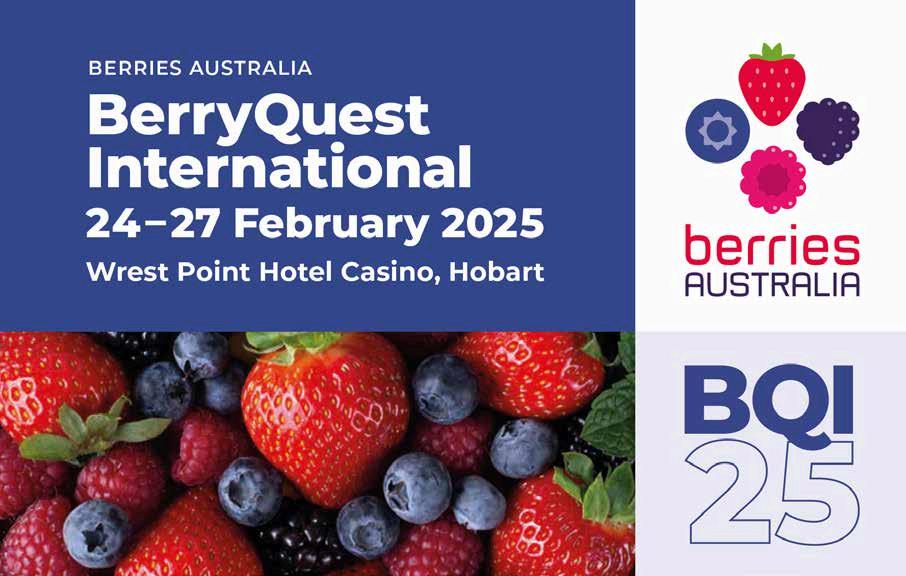

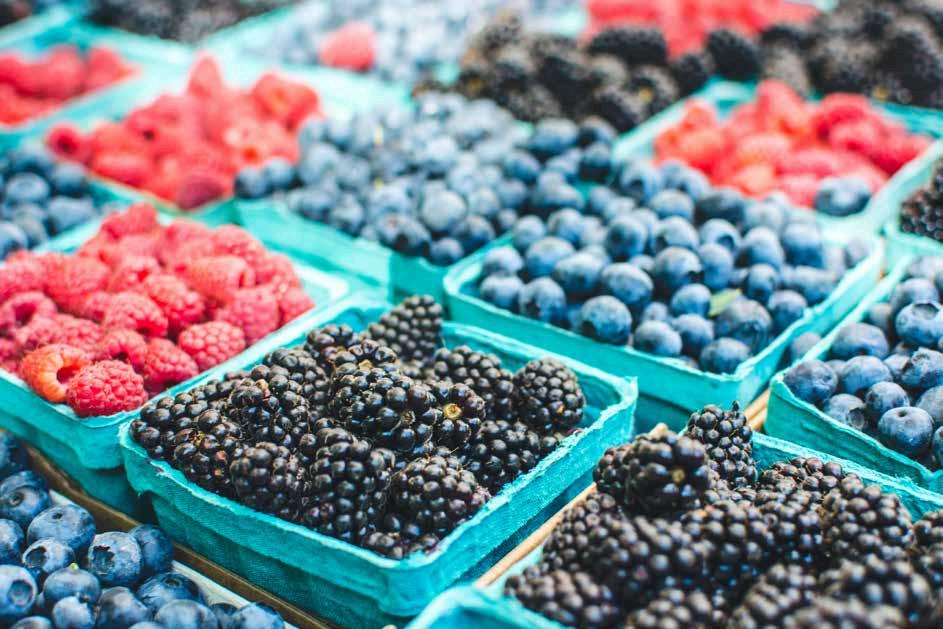
BerryQuest International 2025 aims to bring together our community in a four-day event showcasing the latest innovations including growing techniques, research, packaging, export development, biosecurity, labour and marketing.
I would like to thank you for supporting our conference and I look forward to meeting you in February 2025.
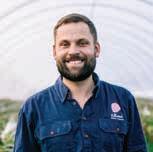 Simon Dornauf CONFERENCE COMMITTEE CHAIR
Simon Dornauf CONFERENCE COMMITTEE CHAIR


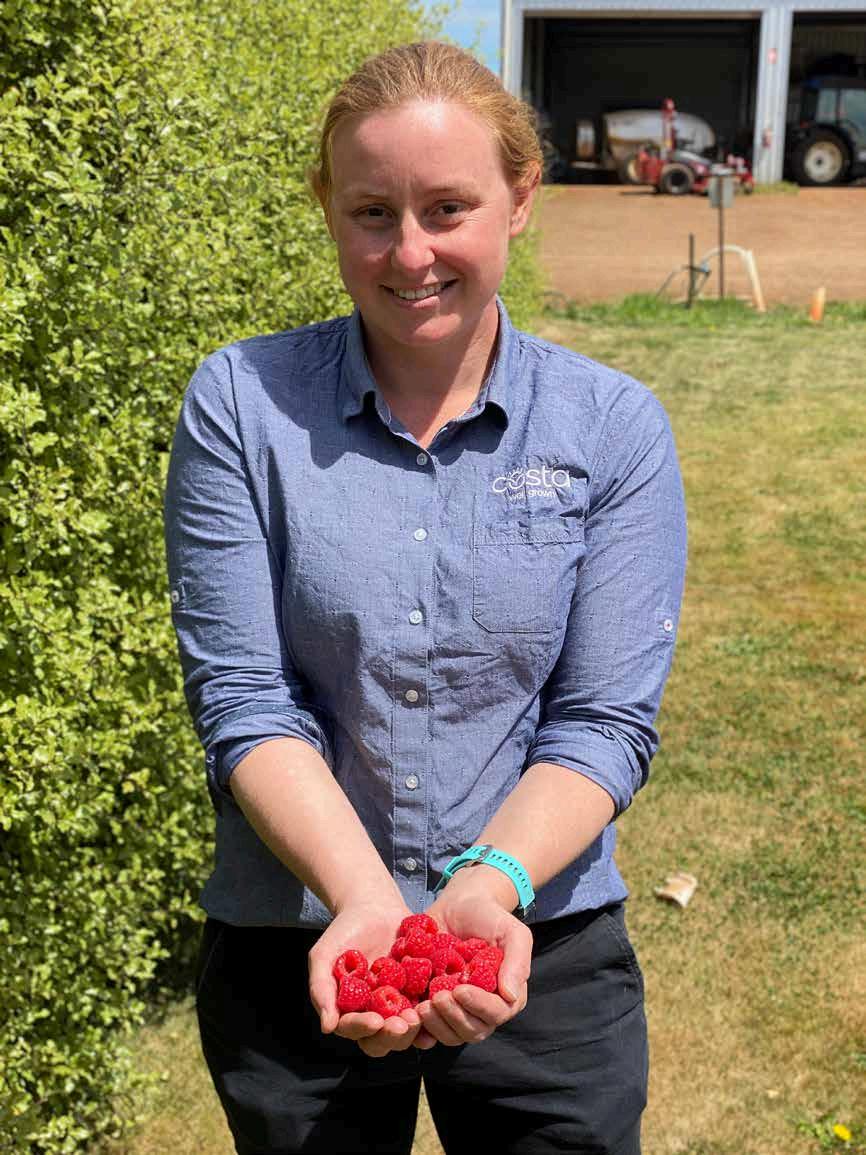

Sponsorship options
The conference offers a unique opportunity to promote your company and market your products and services to growers, wholesalers, marketers, retailers, researchers, nursery, and allied trade suppliers across the Australian berry industries.

PLEASE NOTE ALL PRICES EXCLUDE GST AT 10%
Conference Support
Delivers the highest level of exposure both in the lead up to and during the conference. These packages include the following general benefits:
• One complimentary full conference registration (includes all sessions, morning & afternoon) tea breaks, lunches, access to trade show and welcome reception)
Insertion of one Promotional item in the Conference Bag
Acknowledgement on all Conference Materials
Option to utilise delegate Lead Capture & Appointment technology via Conference App
PLATINUM PACKAGE x 2
ALL GENERAL CONFERENCE SUPPORT BENEFITS PLUS:
Joint naming rights of Welcome Reception
• 1 x Complimentary double trade booth 6m x 3m in a premium location
$30,000
1 x Full page advert or advertorial in the Australian Berry Journal in the lead up to the conference (content provided by you for a quarterly edition of your choice)
• �A 5-minute speaking opportunity as part of both the Welcome Reception and the official conference opening
• 3 x Additional complimentary full conference registrations (includes all sessions, morning and afternoon tea breaks, lunches, access to trade show and welcome reception) – total of 4 full registrations
• 2 x Complimentary tickets for the Australian Berry Industry Gala Dinner & Awards evening
4 x Complimentary tickets for the Farm Tour
Insertion of an additional Promotional Item in the Conference bag (total of two)
Display company signage at entrance to main plenary session room (Sponsor to provide content)
GOLD
PACKAGE x 8 $15,000
ALL GENERAL CONFERENCE SUPPORT BENEFITS PLUS:
1 x Complimentary trade booth 3m x 3m
1 x half page advert in the Australian Berry Journal in the lead up to the conference (content provided by you for a quarterly edition of your choice)
• 1 x Additional complimentary full conference registration (includes all sessions, morning and afternoon tea breaks, lunches, access to trade show and welcome reception) – total of 2 full registrations
• 2 x Complimentary tickets for the Australian Berry Industry Gala Dinner & Awards evening
• 2 x Complimentary tickets for the Farm Tour
FARM TOUR PARTNERS x 2 $6,000
ALL GENERAL CONFERENCE SUPPORT BENEFITS PLUS:
Naming rights of your chosen farm tour
2 x Complimentary farm tour registrations
Opportunity for your Company Representative/s to give a 15-minute verbal presentation and/or demonstrate product during farm tour.
SESSION PARTNER x 5
$4,000
As a session partner, your company name will be associated with one of the main plenary sessions within the conference program. The sponsor may choose their own session (on release of program) or be allocated a session at the Conference Committee’s discretion.
ALL GENERAL CONFERENCE SUPPORT BENEFITS PLUS:
Naming rights of your session with acknowledgement by MC during session
Opportunity to place signage in appropriate position within Plenary hall
• Placement of company logo on session holding slide
SHOUT
A GROWER x UNLIMITED
$1,500
Give a berry grower the opportunity to attend this important and highly informative event on the Australian Berry Industry calendar. Not only will they receive the benefit of hearing from experts in all aspects of farming, research and technology from across Australia and beyond, but you will receive acknowledgement for supporting your chosen grower’s continued development in berry production.
ALL GENERAL CONFERENCE SUPPORT BENEFITS (with complimentary full conference registration being allocated to a grower of your choice) PLUS:
1 x Complimentary ticket for the Australian Berry Industry Gala Dinner and Awards evening for your grower of choice
• 1 x Complimentary ticket for the Farm Tour for your grower of choice
Trade Show
As an Exhibitor at the BerryQuest 2025 Trade Show, your organisation will have the opportunity to connect directly with delegates. All breaks for food will be held in the Trade Show Hall, together with the Welcome Reception on Tuesday evening.
THE TRADE SHOW PACKAGES ALL INCLUDE THE FOLLOWING BENEFITS:
Insertion of one Promotional item in the Conference Bag
• Acknowledgement on all Conference Materials
Option to utilise delegate Lead Capture & Appointment technology via Conference App
TRADE SHOW EXHIBITOR (3
m X 3m) x 24
ALL GENERAL TRADE SHOW BENEFITS PLUS:
$6,000
TWO exhibitor passes (includes access to trade show, morning and afternoon tea breaks, lunches and welcome reception)
TWO Complimentary tickets for the Australian Berry Industry Gala Dinner & Awards evening
• Access to power, signage & lighting
Trade Show booths can be purchased in multiples to create a larger display area.
For 6m x 3m purchase 2 booths, for example. There is no discount for multiple purchases.
MINI TRADE SHOW EXHIBITOR
ALL GENERAL TRADE SHOW BENEFITS PLUS:
(3m X 1m) x 4 $4,000
TWO exhibitor passes (includes access to trade show, morning and afternoon tea breaks, lunches and welcome reception)
TWO Complimentary tickets for the Australian Berry Industry Gala Dinner & Awards evening
• Access to power, signage & lighting
TRADE SHOW BUSINESS LOUNGE
WITH CHARGING STATION
$10,000
Business Lounges are a focal point for delegates needing to catch up on emails, recharge their devices, network, and discuss business. The Business Lounge will have a mix of furniture options and charging stations offering delegates a comfortable space to work and network. The location of Business Lounge will be in the main trade show area (Tasman Room).
ALL GENERAL TRADE SHOW BENEFITS PLUS:
NAMING RIGHTS of Trade Show Business Lounge and Charging Station (6m x 3m)
• TWO pull-up banners (up to 1m wide) at the Business Lounge (sponsor to supply)
Opportunity to provide promotional items/brochures at the Business Lounge
• ONE full conference registration (includes all sessions, morning and afternoon tea breaks, lunches, access to the trade show and Welcome Reception)
• ONE exhibitor pass (includes access to Trade Show Area, morning and afternoon tea breaks, lunches and Welcome Reception)
• TWO tickets for the Australian Berry Industry Gala Dinner & Awards night
Networking Support
Our Networking Support packages provide your organisation with the opportunity to support one of the most important aspects of any conference, the social activities!
THESE PACKAGES INCLUDE THE FOLLOWING GENERAL BENEFITS:
• One complimentary full conference registration (includes all sessions, morning and afternoon tea breaks, lunches, access to trade show & welcome reception)
• Insertion of one Promotional Item in the Conference Bag
• Acknowledgement on all Conference materials
• Option to utilise delegate Lead Capture technology via conference app
GALA DINNER SPONSOR X 1
$20,000
As the sponsor of the Australian Berry Industry Gala Dinner and Awards evening on Day 2 of the conference program, your organisation will be host of the final event. Your entitlements will include all general networking support benefits plus:
1 x Additional complimentary full conference registration (includes all sessions, morning and afternoon tea breaks, lunches, access to trade show and welcome reception) – total of 2 full registrations
• Naming rights of the Australian Berry Industry Gala Dinner and Awards evening
Opportunity for your company representative to deliver a 5-min presentation including welcome, introduction and overview of your products & services
• Opportunity to place signage in appropriate areas & utilise digital signage if available
Your company logo on all menus for the evening
8 x tickets to Gala Dinner and Awards evening
AWARD SPONSOR X 6
$5,000
The Inaugural Australian Berry Industry Awards will be launched at the Gala Dinner of BerryQuest International 2025. Your business has the opportunity to sponsor one of the following categories: Grower of the Year Supply Chain Champion
• Agronomy Champion
• Next Generation Industry Impact
Researcher of the Year
YOUR ENTITLEMENTS WILL INCLUDE ALL GENERAL NETWORKING SUPPORT BENEFITS PLUS:
• Naming rights sponsorship of allocated category award
• 2 x tickets to Gala Dinner and Awards evening
• Award presentation during gala dinner
• Photo opportunity with award recipient
• Your logo featured next to your sponsored category in dinner program
Your logo and business name featured on the category’s slide during the award’s presentation
Merchandise & Materials
Our Merchandise & Materials packages provide your organisation with the opportunity to connect your brand with quality pieces of merchandise provided to all delegates. These packages include the following general benefits:
One complimentary full conference registration (includes all sessions, morning and afternoon tea breaks, lunches, access to trade show & welcome reception)
• Insertion of one Promotional Item in the Conference Bag Acknowledgement on all Conference materials
• Option to utilise delegate Lead Capture technology via conference app
CONFERENCE APP PARTNER x 1
$10,000
BerryQuest is going high tech with the introduction of the Conference App! The app will provide our delegates with access to the program, exhibitor listings, the opportunity to liaise with other delegates and speaker information plus much more. It also gives our exhibitors the option to utilise Lead Capture technology. As the sole Conference App partner, you will receive all general package benefits PLUS:
Exclusive branding of conference app including prominent logo placement (sponsor to provide logo)
• 1 x Complimentary trade booth 3m x 3m
1 x Complimentary ticket for the Gala Dinner and Awards evening
CONFERENCE BAG PARTNER x 1
$10,000
As the sole Conference Bag partner, you will receive all general package benefits PLUS:
Sole naming rights to conference bag including placement of your logo on bag (sponsor to provide logo)
1 x Complimentary trade booth 3m x 3m
• 1 x Complimentary ticket for the Gala Dinner and Awards evening
COFFEE CART PARTNER x 2
As a Coffee Cart partner, you will receive all general package benefits PLUS:
One complimentary single trade booth 3m x 3m with coffee cart
• Acknowledgement by the Master of Ceremonies/Chair prior to and after each Session break
• 1 x Complimentary ticket for the Gala Dinner and Awards evening
NOTEPAD & PEN PARTNER
$5,000
As the sole Notebook & Pen partner, you will receive all general package benefits
PLUS:
Sole naming rights with logo printed on notebook and pen for each delegate.
Sponsor to provide logo

WATER BOTTLE PARTNER
$5,000
As the sole Water Bottle partner, you will receive all general package benefits PLUS:
Sole naming rights with logo printed on notebook and pen for each delegate.
Sponsor to provide logo
$7,000
LANYARD PARTNER
$5,000
As the sole Lanyard partner, you will receive all general package benefits PLUS:
Sole naming rights with logo printed on notebook and pen for each delegate.
Sponsor to provide logo
TO SECURE YOUR CHOSEN SPONSORSHIP OR EXHIBITOR PACKAGE PLEASE VISIT: bit.ly/BQI25-Website SPONSORSHIP Jen Rowling | jenrowling@berries.net.au | 0448 322 389 TRADE SHOW Wendy Morris | qldberryido@berries.net.au | 0484 272 963
Berry Basket Burst One
MT23500 FY24 Berry Basket Marketing Campaign
Jane Richter, Communications Manager, Berries Australia
• Late last year in an industry first, berry growers across the country joined forces to create a year-long consumer marketing campaign to encourage Aussie shoppers to put more berries in their baskets
• Delivered through Hort Innovation and led by Berries Australia, the collaboration sees blueberries, raspberries, blackberries and strawberries all promoted under a ‘berry basket’ banner
• Burst one of the planned activities has now been completed and a review conducted to enable the team managing the activity – guided by the Marketing Sub-Committee – to recommend changes to the remaining bursts planned for later in the year
To sell more berries, we are trying to persuade existing buyers who buy berries relatively infrequently to buy berries more often when they are shopping for groceries. And we are looking to achieve this by building their love of the taste of berries and their emotional connection with berries, whilst educating them about the specific health benefits that only berries can deliver.
The target audience we are ‘talking’ to with all of our marketing activity has been identified through market research as quite broad; main grocery buyers who are typically 25-34 years old and interested in fresh food. Many are in the ‘young family’ life stage and are facing pressures on the family budget, but like to choose ‘healthy’ where possible. The activity has been planned to take place across the year until the end of January 2025 and the first burst was live in the market from February to May (Figure 1).

33 INDUSTRY
Figure 1. Activity is planned across the 12 months from February 2024 to January 2025
How did the campaign perform in burst one?
30 Second TV Commercial featured on Broadcast Video on Demand (BVOD) channels
If you watch Married at First Sight or Australian Survivor on one of the BVOD channels then you will definitely have seen our TV commercial during February and March. The advertising placement was optimised to reach main grocery buyers (MGB) in both city and regional locations across the country and delivered 832,817 impressions.
Impressions: Indicate the number of customers who could have seen the advert



To see how the TV commercial was made and watch the finished product visit bit.ly/BBM-BTS or scan this QR code
Out of Home digital advertising panels in shopping centres and outside grocery stores
Berries Australia has a partnership with Val Morgan Outdoor (VMO) which incorporates a 70% Metro and 30% Regional buying program for the advertising placements. VMO’s mix of Retail screens, Large Format and Large Format Platinum screens in retail centres were used to generate awareness and VMO’s Shop Reach screens directly outside grocery stores were used to target consumers on their immediate path to purchase.
After the first burst of activity, VMO Metro reached 23% (1,584,746) of MGB audiences, beating the KPI benchmark by +9%. This activity saw 17,690,962 impressions at a 11.2x frequency. The VMO regional panels reached 19% (640,789) of the MGB audience also beating the KPI benchmark. This activity saw 9,417,562 impressions at a 14.7x frequency. During Burst One of the campaign, VMO delivered an additional 77 bonus (free) digital panels across both Metro and Regional areas which help to drive further reach to boost the first burst of activity for this campaign.

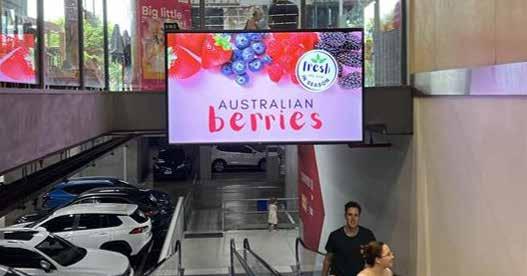
 The Berry Basket creative on the digital advertising screens across the country.
The Berry Basket creative on the digital advertising screens across the country.
34 BERRY AUSTRALIAN JOURNAL WINTER 2024 EDITION 19
Photo credit: VMO & Wavemaker
Harnessing the power of influencers to spread the berry basket message
Through the GOAT influencer platform, we worked with four prominent influencers to build a range of content showing berries being a part of all the moments that matter, for special occasions and everything in between. The content was created to a strict brief to ensure that all berries were represented equally and the content was designed to inspire consumers to take berries into meal occasions that they would not necessarily have considered before. Broadening the usage of berries is a key long-term strategy to increase consumption and grow the category.
The material created by the influencers was broadcast on their owned channels on Instagram and TikTok, and then boosted to extend the reach to even larger audiences using paid advertising spend.

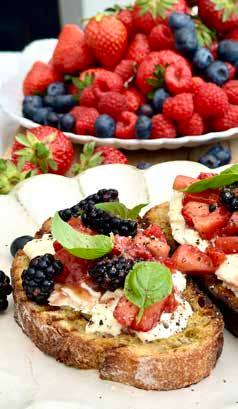

Organic social media with paid boosting across our Facebook and Instagram channels
Using the ‘Fresh Aussie Berries’ social media accounts in Facebook and Instagram we have been sharing a range of engaging content with the 18,000 existing followers, whilst using paid boosting of posts to expand the reach even further.
We are efficiently reaching Aussies on Facebook and Instagram to build awareness and prompt the purchase of fresh berries at their next shopping trip. Boosted advertising is targeting those users interested in Australian Supermarkets like Woolworths, Coles, Harris Farm Market, IGA, and Costco. In the campaign to date, a reach of 3.3m unique users has been achieved for a relatively low investment of $1.84 per thousand users.
@freshaussieberries facebook.com/freshaussieberries
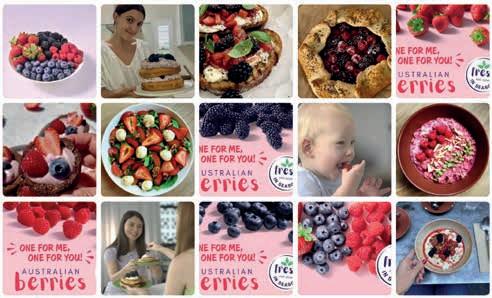
@freshaussieberries instagram.com/freshaussieberries
18,293 followers
1214 followers
 Our influencers created berry interesting uses for fresh berries from dressing up the everyday muffin to exciting brunch burrata toast and crunchy weekend salads.
Our influencers created berry interesting uses for fresh berries from dressing up the everyday muffin to exciting brunch burrata toast and crunchy weekend salads.
35
Photo credits: Jack Rock, Tori Falzon and Amanda Cordony
Influencing the purchase of berries on Coles and Woolworths online shopping portals
In burst one, we invested with online shopping platforms Citrus (Coles) and Cartology (Woolworths) to reach consumers whilst they were in a purchase mindset to help drive online sales of berries. The campaign delivered a strong return on ad spend (ROAS) achieving up to $11.39 return for each dollar invested against a KPI of $5.84 (Citrus) and $5.54 (Cartology).
What is planned for bursts two and three?
The team managing this activity has reviewed the campaign results from burst one and is recommending some small changes to the forward plan including a reallocation of budget within the different activities to focus on our out of home advertising. There is also the potential for some additional funds to be available to boost activity further and a full update on the revised plan and budget will be provided in the Spring edition of this journal. The out of home advertising and boosted social media activities will run again in late July and throughout August and September to support the peak of the strawberry and blueberry seasons.
For more information please contact: rachelmackenzie@berries.net.au or jane@teres.com.au


PRODUCT RECALL

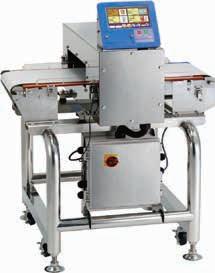
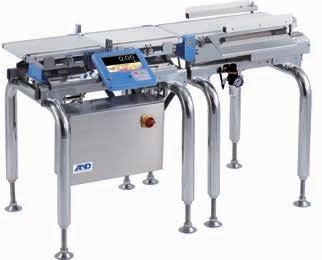
36 AUSTRALIAN WINTER 2024 EDITION 19 Talk to A&D today about how to reduce giveaway and improve product quality. Locally Stocked and Supported in Australia. Inspection Systems | Metal Detectors | Checkweighers | Data Capture
REDUCE PRODUCT GIVEAWAY or visit: www.andinspection.com.au 1800 241 434
The project 'MT23500 FY24 Berry Basket Marketing Campaign' is funded by industry levies through Hort Innovation and contributions from the Australian Blueberry Growers Association voluntary levy.
PREVENT
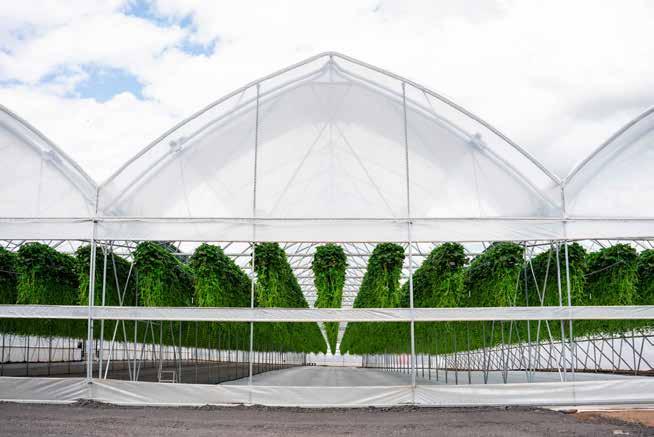


37 Mark Woodhead Sales Manager Asia Pacific +44 (0)7808 674506 mark.woodhead@haygrove.com GET IN TOUCH Follow us on LinkedIn
Enhancing Health Professional Engagement
Insights from ‘Health and Nutrition Information for the Berry Industry (MT21000)’
Jutta Wright, FOODiQ Global
The FOODiQ Global (formerly Nutrition Research Australia) team have concluded their appointment to the 2-year strategic levy investment project, Health and Nutrition Information for the Berry Industry (MT21000), part of the Blueberry, Raspberry and Blackberry Funds.
Successfully meeting project outcomes, some of the key outputs from the project has included the development of seven health professional (HP) resources including evidence summary fact sheet, consumer friendly fact sheet, infographics, social tiles and an educational animation, all housed on the FOODiQ Health Professional Berries Hub.
Additionally, the team developed and executed three educational activities including a key opinion leader (KOL) online event, Dietitians’ Conference and dedicated FOODiQ HP webinar.
In January 2024, a final digital outreach campaign effectively disseminated the resources and hub to HPs through targeted social media campaigns, email outreach communications to HP organisations, and engagement with key opinion leaders (KOLs). The project successfully met all intermediate and end-of- project outcomes, with educational events receiving high ratings for information, usefulness, and engagement. Over the past year the project has amassed a sizeable HP database of nearly 1200 engaged subscribers.
As a result of these efforts, the project significantly increased HP knowledge of the nutrition and health benefits of berries, leading to a notable rise in their intent to recommend berries to clients. Specifically, at project end, over two-thirds of HCPs report that are aware of nutrition and health benefits of berries which increased by over a third during the project, and three in every four HPs reporting they recommend berries ‘always or often’ to their clients compared to just over half (58%) at baseline.
All HP who accessed the resources reported them to be useful. The resources played a pivotal role in enhancing HP familiarity and confidence, with those accessing the resources demonstrating nearly twice the confidence in discussing berry nutrition and health benefits compared to those who did not.
The impact of the project is evident in the substantial increase in HP recommendation rates for berries to clients, indicating a clear correlation between resource access and recommendation behaviour. However, despite the resources' perceived usefulness, the proportion of participants accessing them was lower than anticipated, highlighting the need for further awareness campaigns to maximise resource utilisation.
These findings underscore the importance of driving awareness among HPs as a crucial strategy for promoting berry consumption and driving industry growth. While the project has made significant strides in educating this influential stakeholder group, continued investment is recommended to sustain and expand these efforts.
Post-project recommendations to Hort Innovation include short-, medium-, and long-term strategic investment opportunities. Short to medium-term strategies focus on maintaining engagement with the existing HP database while expanding communication efforts to reach a broader spectrum of HPs, including fitness professionals.
Medium to longer-term strategies involve investing in research to strengthen the evidence base supporting berries, particularly lesser-researched varieties such as raspberries and blackberries. Additionally, a targeted campaign highlighting the journey from 'Paddock to Plate' aims to address concerns surrounding pesticide usage, further promoting berry consumption.

38 INDUSTRY BERRY AUSTRALIAN JOURNAL WINTER 2024 EDITION 19
✓ Removes biofilm
✓ Prevents the build-up of scale from iron & calcium
✓ Increases Water Use Efficiency (WUE)
✓ Increases dissolved oxygen of water, aerating soils/mediums
✓ Enhances the microbial health of soils & mediums
✓ Supports optimum plant growth, through improving the nutrient and water uptake
✓ Completely Safe for people, plants, soils, and animals
✓ Non-corrosive, non-hazardous to irrigation systems
Irrigation Line
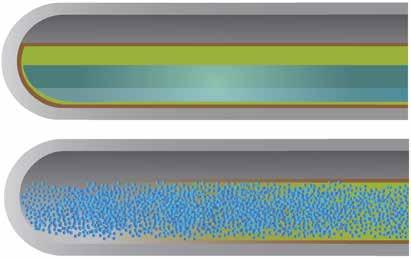

Bacteria forms inside irrigation lines due to organics --- (fertilisers. recycled water) in the water.
_____ A layer of biological film builds up over the bacteria. This biological film build up causes blockages in emitters.
AquaMate® initiates an immediate catalytic breakdown of the polysaccharide linkages, which bacteria have secreted _____ for adhesion to surfaces through the formation of ultra fine microbubbles.


AquaMate® maintains free flowing lines, clear emitters, and ---- higher oxygen transfer within the water line.
Aqua Mate® is delivered at very high dilutions through any type of watering system, including hydroponics, pivots, laterals, sprinkler, and drip irrigation systems.
Application Rate:
Packaging:

3ppm (0.003ml/Litre)
4L, 20L & 1 OOOL
Scan the QR code to watch a video showing and explaining the cleaning process and the secondary benefits Aqua Mate ® offers your irrigation system and overall farm production.

Advanced Nutrients Pty Ltd
Phone: 1800 244 009
Email: service@advancednutrients.com.au
Web: www.aquamate.farm I www.advancednutrients.com.au

CB
ADVANCED NUTRIENTS" Your Sustainability Partner
HONG KONG
KEY STATISTICS
LAND AREA
1,115 km2
CAPITAL CITY HONG KONG
LANGUAGES
CURRENCY HONG KONG $ (HKD)
• The Australia-Hong Kong Free Trade Agreement (A-HKFTA) was enacted in 2020, launching a new chapter in economic relations between Australia and Hong Kong
• Hong Kong is an import-dependent market with over 95% of food and beverage products imported from around the world with Zero tariff charged on most imports
• Australia is extremely well placed as an exporter to Hong Kong due to its proximity, connectivity & time zone
• Hong Kong is ranked no. 3 on “Ease of Doing Business Index” globally
ECONOMY
• Characterised by free trade, low taxation and minimum government intervention
• 10th largest trading economy globally, with the mainland of China as its most significant trading partner
• Also a major service economy, with particularly strong links to mainland China and the rest of the Asia-Pacific region
POLITICAL ENVIRONMENT
• Hong Kong is a Special Administrative Region of the People's Republic of China
• The region is governed by the Basic Law of the Hong Kong Special Administrative Region of the People’s Republic of China (the Basic Law), passed by China’s National People’s Congress (NPC) in 1990
• The Basic Law serves as Hong Kong's “mini constitution”
2024 CULTURAL HOLIDAYS

CONNECTIVITY
• Hong Kong is in the world’s largest cluster of seaports and airports
• Hong Kong International Airport handles the most cargo in the world, and the shipping routes around Hong Kong are some of the busiest in the world
• �Direct flights to Hong Kong currently operate from all Australian major cities
Gift-giving is a significant tradition within the Chinese psyche & premium fruit is often used as a gift.
1 Jan - New Year’s Day • 10 Feb – 13 Feb – Lunar New Year • 29 Mar - 1 Apr - Easter • 4 Apr - Ching
15 May – Buddha’s Birthday
18 Sep - Day after Mid-Autumn Festival • 1 Oct - National Day
SPECIAL ADMINISTRATIVE REGION
Ming Festival • 1 May - Labour Day •
•
Jul - Hong Kong Special Administrative Region Establishment Day
Dec
Christmas Day
MEDIAN
100% URBAN ETHNICITY: CHINESE 91.6% | OTHER 8.4%
• 10 Jun - Tuen Ng Festival
1
• 11 Oct - Double Ninth Festival • 25
-
• 26 Dec - Boxing Day TOTAL POPULATION 7.5m POPULATION DENSITY RANKED #4 IN WORLD AT 7,135 PER km ²
AGE 45.9 YEARS AND AGEING RAPIDLY
EXPORT MARKET PROFILE | HONG KONG
CANTONESE & ENGLISH
249 000 USUAL RESIDENTS
MOBILE RESIDENTS
7 223 600
THE HONG KONG CUSTOMER
• Hong Kong consumers focus on value and quality over sticker price
• One in three Hong Kong shoppers say they’ve switched to more premium brands or spent more on high quality products
• Reliability and trustworthiness are among the top three reasons why consumer choose to purchase



KEY INSIGHTS
Hong Kong’s food culture brings together Cantonese, European, Japanese, Korean, Southeast Asian, and a variety of non-Cantonese Chinese influences in a unique and open sector
A thriving restaurant industry complements home cooking that relies on locally purchased produce from both independent and larger grocery stores
High-density living, long working hours, and interest in exploring new tastes and flavours, means residents in Hong Kong are open to new food experiences both in and out of the home
Hong Kong is one of the top 15 wealthiest countries globally based on GDP per capita which means a relatively sophisticated consumer base with high spending power and an eagerness to try new products
Wealthy consumers are driving rising demand for luxury food and beverage products, especially those from Western markets
Mirroring global trends, consumers in Hong Kong are becoming more and more environmentally conscious
70% choose to buy from brands that do without extra packaging
The global shift towards health and wellness is also evident, with products labelled as sugar-free and organic experiencing growth, as well as product categories such as nutritional supplements
49% of consumers say that they’re expecting to increase their spending on health and wellness products in coming years
BERRY TRADE 2023
In 2023, Australia was the 9th largest supplier of berries to Hong Kong in volume with 640 tonnes of total berries supplied
SUPPLY CHAINS
Hong Kong is situated in an ideal location in Asia, which allows businesses to tap into a world of opportunities in both Hong Kong and beyond.
It houses a superb logistics network, which is ranked 12 globally, ensuring efficient export activity and in-country distribution saving both time and money for exporters
MAINSTREAM RETAIL
The 2 largest supermarket chains in Hong Kong are:

(owned by Dairy Farm Company)

(owned by A.S. Watsons)
Major supermarket chains source a variety of fresh produce through direct importation and/or local importers/agents
They prefer to trade direct when dealing with large volumes of fresh produce and have their own warehousing facilities
Exporter Country 2023 Share % 5yr avg Share % Total Volume Imported Japan 40.9 25.4 5,490 tonnes HS081010 Rep. of Korea 25.6 29.0 USA 23.3 28.8 Mexico 2.5 3.3 China 2.4 1.3 USA 59.2 28.6 240 tonnes HS081020 Mexico 30.0 10.7 UK 5.0 2.1 Australia 3.8 3.2 China 2.1 0.9 Peru 63.8 52.5 15,388 tonnes HS081040 Chile 12.8 32.7 Zimbabwe 5.8 2.3 Morocco 4.8 2.0 South Africa 4.4 2.0
EXPORT MARKET PROFILE | HONG KONG
MAINSTREAM RETAIL
Some upscale supermarkets chains may source new products—typically smaller-volume, niche products—from consolidators in Australia. These supermarket chains include:



Smaller supermarket chains and local convenience stores without warehousing facilities generally source overseas fruit products from importers incountry or via the Yau Ma Tei wholesale fruit market
Great Food Hall (owned by A.S. Watson) Market Place by Jason (owned by Dairy Farm Company) FOOD SERVICES
• The food services industry plays a vital role in Hong Kong's food scene with dining out a key part of the culture for locals, the expat community and visiting tourists
• The Hong Kong HRI food service market is made up of hotels, restaurants, and institutions, with most food and beverage sales at restaurants
• There are over 14,000 restaurants in Hong Kong
• 74% of Hong Kongers eat out several times per week and 23% eat out every single day
• About 6,000 Hong Kong hawkers still operate selling cheap food from stalls and street carts
OPPORTUNITIES
Hong Kong is one of Asia's richest markets with consumers expecting access to a range of foods
The market relies heavily on imported foods as there is only very limited local production
It's an ideal launching pad for new exporters to enter the region or expand their existing businesses
Supermarkets, fast food stores and themed restaurants have become more popular in recent times, providing an opportunity for Australian businesses to showcase their premium products
When choosing produce, consumers consider:
• nutritional value
• details about ingredients
• food safety
There is driving a trend towards healthy, sustainable and organic produce
TIPS FOR SUCCESS
ECOMMERCE
Online retail is a growing channel in Hong Kong. The leading supermarket chains have online stores and mobile apps, with online shopping platforms such as HKTV Mall, Ztore and Neigbuy gaining market share.



The never-ending pursuit of convenience has boosted the growth of e-commerce platforms
CHALLENGES
Strong competition – with minimal trade barriers, the horticulture market is very competitive so quality products often compete on price
Ongoing support – importers, retailers and food service operators often expect ongoing financial and marketing support from suppliers to promote their products
Prioritising the market – some importers are concerned that suppliers treat Hong Kong as a back-up market so to build partnerships in Hong Kong you will need to show your commitment to this market
Pricing concerns – changes in price quotations and currency fluctuation are potential barriers to Hong Kong companies partnering with Australian suppliers
Personal relationships in Hong Kong are key to doing business meaning companies that visit Hong Kong tend to be more successful at securing new distributors
Securing a channel or distributor is only the first step as it’s important to get back out to market to build a relationship with your importer, retailers, hotels and restaurants, media and trade bodies
It is common to bring the local partners to Australia to meet with company executives, look at production and learn more about the stories and history of the companies
Hong Kongers are very discerning in business; they know the efficiency of their economy, and are therefore only interested in judging the bottom line of a deal
You will gain their trust and respect by being straightforward and clear about your fundamental goals
Hong Kongers prefer to take a long-term approach to business relationships and therefore often want to know a great deal about their partners in order to build the trust and loyalty needed to support business in the future
Introductions by a trusted third-party are almost a necessity to beginning any business relationship
Introductions by a trusted third-party are almost a necessity to beginning any business relationship
EXPORT MARKET PROFILE | HONG KONG
Certified soil biodegradable mulches
Jane Richter, Communications Manager, Berries Australia
• Plastic mulch is an environmental issue as there is no viable or sustainable option for disposal and it is usually highly contaminated with plant matter and soil
• Certified soil biodegradable mulches (CSBM) are a potential solution which break down naturally in the soil, leaving organic material and no microplastics, and no removal or disposal costs
• Instead of taking up valuable growing space through stockpiling or contaminating farmland, CSBM products enhance soil by adding carbon and do not lead to topsoil loss because they decompose in the field
• Strawberries are well suited to this alternative to single use plastic
It is estimated that around 12,400 tonnes of conventional mulch films enter the Australian horticulture industry each year. A very small proportion is managed using best practice.
Management costs for plastic mulch are significant including the labour, equipment and fuel use for removal at the end of each crop cycle, space for aggregation, transport for disposal and landfill fees.
The opportunity exists to move away from plastics to certified soil biodegradable mulch (CSBM). These products meet the international standard ISO 23517:2021 and will biodegrade into the soil leaving microbial mass and no microplastics.
These mulch films are distinct from conventional polyethylene films. This includes ‘oxo-degradable’ or ‘oxo-biodegradable’ mulch films, which are made from fossil fuels derived using non-biodegradable polyethylene and additives that enhance the product’s physical disintegration into small plastic fragments which persist in the environment (i.e. microplastics).
The upfront cost of CSBM is significantly higher than conventional plastic mulches. However, there are future savings in terms of disposal as there is no need to collect, transport and landfill the material.
Table 1 presents a summary of the key benefits and risks of CSBM products
43 INDUSTRY
BENEFITS
Reduced plastic:
Reduces the amount of field plastics that are stockpiled/buried/burnt or sent to landfill, with reduced microplastic pollution
Reduced environmental impacts:
Avoids the generation of microplastics that contaminate the environment (soil, vegetation and waterways)
Production benefits:
Increases soil carbon and reduces the loss of topsoil associated with the removal of conventional plastic film
Mitigating future risk:
Reduces the risk of soil and crop growth issues due to microplastics and increased prices of plastic mulch due to changing oil prices
Reduced emissions and transport costs:
As transport to landfill is not required, transport emissions and costs are avoided
Significant labour/time savings for the grower:
Installing and removing plastic mulch is estimated to take an additional 6 hours per hectare
RISKS
Upfront cost of CSBM:
The upfront cost for this product can range between 50% and 200% more than the cost of conventional plastic mulch
Misaligned expectations on performance throughout the crop cycle:
There can be unrealistic expectations on how long the CSBM product retains its full structural integrity, with the product potentially biodegrading before the end of the crop cycle. However, the timing of the biodegradation can be adjusted in manufacturing to meet grower requirements. Some certified soil biodegradable mulch suppliers have ‘questionnaires’ they provide to growers before a trial, so expectations are met from the beginning. The life of the product will depend on climate, crop, soil type and other management factors
Less flexibility in timing:
Timing of installation is an important consideration, as sometimes growers prefer to install all mulch before consecutive plantings. In this situation, CSBM may degrade slightly before the crop is planted and be more susceptible to tearing
Adjusting to the product’s structural integrity:
CSBM requires slightly more care to avoid tearing when planting, using machinery or walking around the crop. This is particularly the case if planting occurs after laying the mulch. Growers need to slightly adjust how they treat and use the product to minimise these issues
Fumigation limitations:
Some fumigation products may accelerate the degradation of the CSBM and in these cases, the product will not work as required. Suitability of CSBM for fumigation will need to be checked before use
the key
CSBM
44 BERRY AUSTRALIAN JOURNAL WINTER 2024 EDITION 19
Table 1. A summary of
benefits and risks of
products
Case Study
VegNET biodegradable mulch trials in Bowen, Queensland
With reef regulations coming into force in early 2024, growers in northern Queensland have a limited window to ensure solutions are in place to remove single use plastics from farms. To facilitate the move to alternatives, Bowen Gumlu Growers Association (BGGA) and the VegNET Regional Development Officer have prioritised the removal of single use plastics from horticulture farms and the uptake of biodegradable mulch.
The horticultural area of Bowen in Queensland produces tomatoes, watermelons, zucchinis and other cucurbits which all use plastic mulch in production. The BGGA conducted a trial of CSBM in September 2022 to assess its performance, particularly how quickly the mulch started to break down and if integrity was maintained throughout the crop cycle in the warmer months where day temperatures tend to exceed 30°C.
The black BioAgri CSBM product from Biobag was used with watermelon, rockmelons and zucchinis. The mulch supressed weeds and the integrity of the mulch was still good after harvesting. The melons shading the mulch provided protection of the product from UV radiation. At the end of the crop cycle, some holes were evident where microbes had started breaking down the product.
The mulch was ploughed into the soil and by late October 2023 had completely broken down. The yield of the produce was in line with expectations and the performance of the mulch achieved the exact results desired.
It is important to note that the timing of the biodegradation can be adjusted in manufacturing to meet grower needs, making it a potential option for the shorter crop cycle typically found in single cycle winter strawberry production.
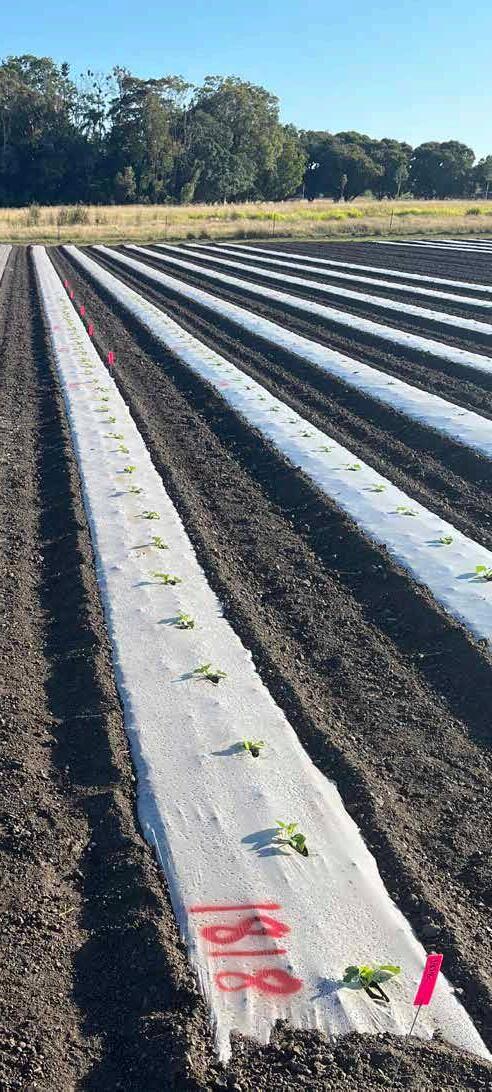 Figure 1. Plastic mulch trial at Bowen, Queensland
Figure 1. Plastic mulch trial at Bowen, Queensland
45
Photo credit: VegNET
What to look out for: Certified soil biodegradable mulch
Products must be certified to ISO 23517. This certification means it will fully biodegrade and is beneficial for soil
Many products claim to be biodegradable but are actually single use plastics which fragment easily into microplastics and not carbon, such as photodegradable (broken down by light) and oxodegradable (broken down by air) products. This false advertising is an example of ‘greenwashing’
Talk to your agronomist or product supplier and ensure that any alternative biodegradable mulch you purchase is certified to the standard ISO 23517
Look for this certification label:
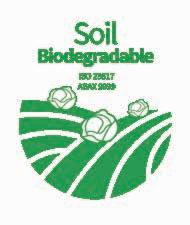
Acknowledgements
Further resources and references
• More information about the terms used can be found on the original Fact Sheet Soil Biodegradable Mulch Films available at https://farmwaste.com.au/ wp-content/uploads/2024/03/Soil-mulch-factsheet-V2.pdf
• AgriFutures 2023: Pre-farm gate waste management – Baseline waste data for the agricultural, fisheries and forestry sector available from agrifutures.com.au/product/pre-farm-gatewaste-management-baseline-waste-data-for-theagriculture-fisheries-and-forestry-sector
• Australian Standard 4454-2012: Composts, soil conditioners and mulches available from store. standards.org.au/product/as-4454-2012
• Australasian Bioplastics Association (n.d.), Certification bioplastics.org.au/certification
• Australasian Bioplastics Association (n.d.), Per- and Polyfluoroalkyl Substances (PFAS) and Certified Compostable Bioplastics Fact Sheet available at bioplastics.org.au/wp-content/uploads/2022/11/ ABA-Statement-PFAS-2022.pdf
• Soil Wealth ICP: Plastics recycling and alternatives to plastic mulch Fact Sheet available at berries.net. au/wp-content/uploads/2024/05/Plastic-mulchfactsheet-SWICP_20240212.pdf
• Landline video: Australia’s first certified soil biodegradable plastic mulch available at youtu.be/ f3iytVthDnU?si=zz_09j79Up_VHPat
• In-depth options analysis and costings for certified biodegradable plastic mulch available at agrifutures. com.au/wp-content/uploads/2023/04/23-009.pdf
• BioBag biobagworld.com/products/agriculture
This summary has been produced from information contained in a Fact Sheet published by RMCG in January 2024 with funding from AgriFutures Australia. We offer our thanks to those research partners and the funding bodies for granting permission to share this information in the Australian Berry Journal.
46 BERRY AUSTRALIAN JOURNAL WINTER 2024 EDITION 19
Profile: Blue Hills Berries & Cherries, Victoria
Jane Richter & Angela Atkinson, Berries Australia
There are not many farms in Australia that can say they are about to celebrate their 130-year anniversary this year but that is the case here at Blue Hills Berries & Cherries nestled on the outskirts of the Yarra Valley in Silvan, Victoria. The Chapman family were one of the first berry growers in the area starting out in 1894 having come from England to find a new life in the ‘colonies’. William Chapman came from Charlotte Plains (later called Carisbrook), near Maryborough Victoria with his brother Walter in 1892. Both worked for another farmer in Wandin for two years and lived on his land before each purchasing their own properties. The land bought by William all those years ago has been continuously farmed by members of the same family ever since and is run today by Kevin and Tracey Chapman.
This part of the original farm now covers about 50 acres growing cherries, boysenberries, raspberries, blueberries and strawberries across three separate blocks in the area. If you go back three generations, the farm was apparently the largest strawberry grower in the southern hemisphere, but the land has been divided up as it has passed down resulting in three sets of Chapmans all farming today along Parker Road.
The farm is unusual in that all sales are made from the onsite farm shop or as ‘Upick’ – also known as ‘pick your own’ or ‘PYO’. The Chapmans don’t package and send any of their fruit to the wholesale markets at all.
“For us, Upick is the only way we can work as a small farm business. We like the lifestyle, and we enjoy the work, but to grow and pack berries commercially I think you need to be a big operation these days,” says Kevin.
“We’ve created our own little niche market as we can’t compete with the big growers in the wholesale markets. You know the berry prices in the supermarket - the $3 a punnet – that hasn’t changed in 20 years and all the costs have quadrupled in the same time,” says Tracey.
Berries are a very labour-intensive crop both in the maintenance and harvesting parts of the growing cycle, and so operating as 100% Upick makes sense economically for the couple and allows them to have some portions of the year when they can literally step away from the farm to have a proper break.
“If you can reduce your workload and have some kind of work-life balance, its much better,” says Tracey.
The farm offers Upick cherries from mid-November to early January, and berries from mid-October until June.
The strawberry patches produce fruit across this full berry harvest window, but the raspberries fit into two separate windows; usually November and a second crop in February each year
The Chapmans grow the publicly-available Sandford raspberry variety, and the patch has been established now for 15 years. As a floricane variety, each year the canes re-sprout and they dig the new canes out and replant them back in the row line to reinvigorate the patch.
47 RUBUS
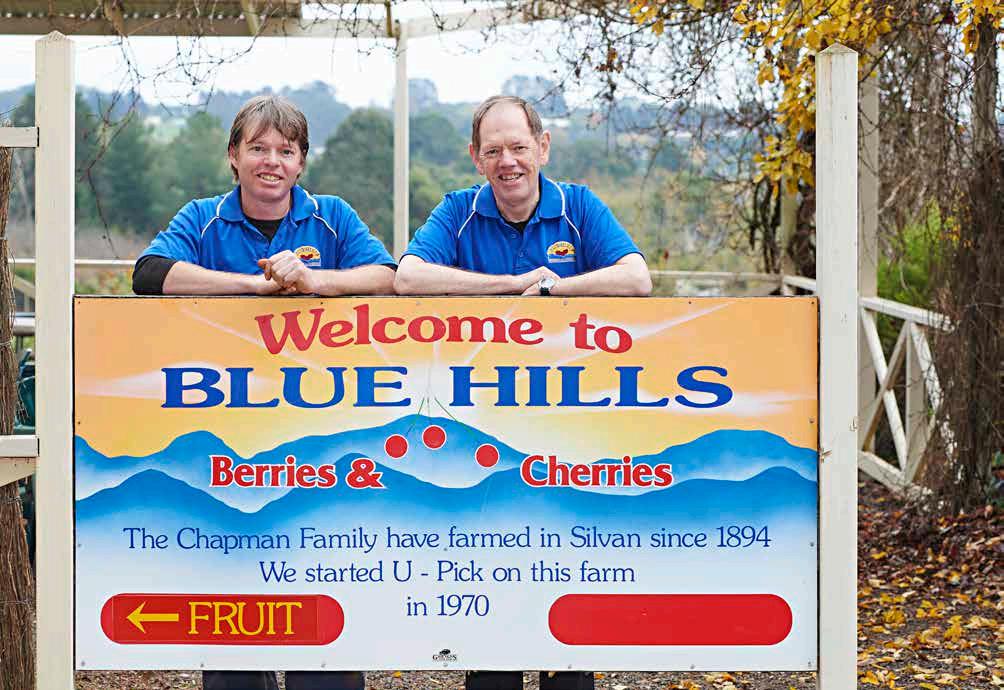

 L-R: Kevin Chapman and Murray Chapman. Photo credit: VSICA
The Sandford raspberry canes loaded with flowers and new fruit ready for the February harvest
L-R: Kevin Chapman and Murray Chapman. Photo credit: VSICA
The Sandford raspberry canes loaded with flowers and new fruit ready for the February harvest
48 BERRY AUSTRALIAN JOURNAL WINTER 2024 EDITION 19
Photo credit: Jane Richter
Sandford is not a variety that is found frequently these days as it produces a small berry that is no good for the commercial markets, but their customers really like the flavour and the canes have never let them down. The berries are a deep red, medium sized fruit with full fruity flavour. A high yielding variety that are also one of the earliest raspberry varieties available from the Yarra region and produce fruit in time for Christmas each year!
Over the 130-year history, the farm has made a significant impact in people’s lives. Tracey told us the story of the Wellman family that have been visiting the farm every single year for the last 30 years to pick raspberries. The family members are spread all over Victoria, but each year they all come together to spend the day picking raspberries and enjoying time together, often twice in the season to line up with the peak of the two raspberry crops. It’s become a family tradition that means Tracey and Kevin have seen the current generation of the family grow up and start bringing their own children.
Even a 100% Upick business model has its challenges and labour is top of the list. As the farm cannot offer year-round employment getting the right people to support the growing, maintenance and customer service components is tricky. Blue Hills has chosen to employ mostly local people which they top up as needed with Working Holiday Makers.
“We try and get as many local people as we can because most of our work is really customer service - we’re not picking and packing fruit. Good English and local knowledge are valuable, but on the other hand, the backpackers can be much more willing to work long days as they are looking to maximise their earnings,” explains Tracey.
Unfortunately, the farm sits just on the wrong side of the postcode boundary which means that they are not able to offer work which qualifies for the 88 days for the Working Holiday Visa.
The weather has played havoc with the harvest this year with extreme temperature fluctuations and rain at completely the wrong time. Despite forecasts for a long dry summer this has been a particularly wet year. Like many other fruit growers, native pests like birds, bats and rabbits are a problem and the Chapmans use a combination of table-top growing, fencing and netting to combat the pest threat.
It's definitely not all doom and gloom for this pair though. Their adult children are now showing an interest in taking over the farm in the medium-term, providing Kevin and Tracey with a much-needed succession plan for this family heirloom.
Despite the hard work and long hours during the harvest season, both Kevin and Tracey express how much they enjoy the work. “There’s always something to do. It’s like any small business owner, you’re always thinking about work, but it is a lifestyle, and we get our winters to ourselves and then we can go away on holidays which many farms don’t get the luxury of doing. It’s also a beautifully peaceful lifestyle,” explains Tracey.
Outside of cherry season (which is short but operates 7 days a week), the Upick is open for 3 days spread across the week; currently Tuesday, Thursday and Saturday. This structure allows for the fruit supply to recover after a big pick and makes sure that customers aren’t disappointed by the fruit available.
The Chapmans have harnessed the power of technology and for the cherry season they sell tickets online with a fixed picking time slot. This allows them to balance the number of people on the property safely with ensuring everyone has the best quality of fruit to pick and all the cherries actually get picked.
For berries, a customer buys a ticket at the farm shop ($15 for adults, under 5’s are free, $7.50 for schoolaged children) and they are supplied with a take home container which holds approximately 500g of fruit or a bucket lined with a clean plastic bag for the big pickers. Guests can stay as long as they like on the farm and importantly can eat as much as they like as they are picking. If they want to take fruit home in the container provided the charge is currently $10 per kg for strawberries and $16 per kg for blueberries. The raspberry patch was between-crops when we visited, but the per kg price is set based on market prices at the time of harvest.
Guests really enjoy the farm experience and are welcome to bring a picnic blanket and enjoy time on the rolling hillsides of the farm. Customers are very happy with these arrangements, and its particularly popular with city-based families giving a full experience for kids and adults alike and only 1 hour from Melbourne CBD. The couple also throw in special events like live music, an on-site café and farm shop selling fresh and frozen berries and local gourmet food products to enhance the customer experience during the peak of the season.
49
Helpful tips for running a U-Pick operation
Harness technology to help the process run smoothly
You need a good digital presence to communicate with potential customers so ensure that you have a clear website that is easy to find and navigate, displays up-to-date information about your location, where to park, opening hours and what you offer, and use social media channels like Facebook and Instagram as ways to provide realtime updates to customers.
Check with your workers as often you’ll have someone working in your team that has the skills to assist you with social media even if you’re not a whizz yourself!
Make sure you include a good Frequently Asked Questions (FAQ) section on your website to help manage visitors’ expectations about their experience with your farm
Consider providing a daily Fruit Report each evening which summarises what fruit is available for the next Upick day
Consider setting up an online ticketing system where people book and pay for a picking timeslot in advance
Helps you to control visitor numbers at peak times
If people cancel at the last minute, you can choose whether to issue a refund or not
It shows your professionalism
Allows you to only sell as many tickets as you think you’ll have fruit for
Leverage the help that is available to promote your business
Connect with all the local tourism bodies, tourist information centres and other agritourism operations in your area to raise the profile of your business offer
Get involved with food trails and other marketing initiatives that will help to attract customers to your business
Connect with local industry associations too to help promote your business
Consider creating a simple flyer that can be shared at tourism venues, local cafes and other businesses to help generate awareness and a professional perception of your offer
Do the right thing to manage your risks
Ensure you have plenty of off-street designated car parking that is clearly signposted
Make friends with your local council as you need to know what you can and can’t do, and what they will be focused on like traffic control or food safety
Make friends with your neighbours and talk to them in advance about what you want to do, if you are adding a Upick component to your business and this will impact them in some way. Keep really open channels of communication with them so they can come to you with any concerns about traffic, noise and litter for example. It’s far better that you sort any issues out together than they take their complaints to the council or other authorities that may result in you being penalised or your operation being shut down
Minimise your liability insurance costs by keeping on top of all the small maintenance tasks around the farm, identifying and fixing trip hazards, and keeping your safety signage clear and relevant
Ensure you have good quality signage – in relevant languages or using images - to guide people around the farm and communicate how they need to behave
Have the right facilities to support a good customer experience
You will need toilets, hand washing and potentially accessible toilets for disabled guests
It doesn’t have to be a permanent facility as even a well-maintained port-a-potty loo will suffice for a short period
Consider providing some seating areas where customers can relax and enjoy your farm surroundings safely
Think about adding café offers like coffee, simple food or ice cream to enhance the experience
Visit other agritourism businesses to see what works
50 BERRY AUSTRALIAN JOURNAL WINTER 2024 EDITION 19
Profile: Henry Scott, Harvest Manager, Costa Group Berry Category
Mark Salter, Berry Industry Development Officer, Fruit Growers Tasmania
Henry Scott is Harvest Manager for Costa Group's berry category, where he oversees harvest and support for Costa’s berry farms, including blackberries at the Dunorlan farm in Tasmania. I was able to catch up with him in Tasmania, and during my visit to Queensland where he is based most of the time.
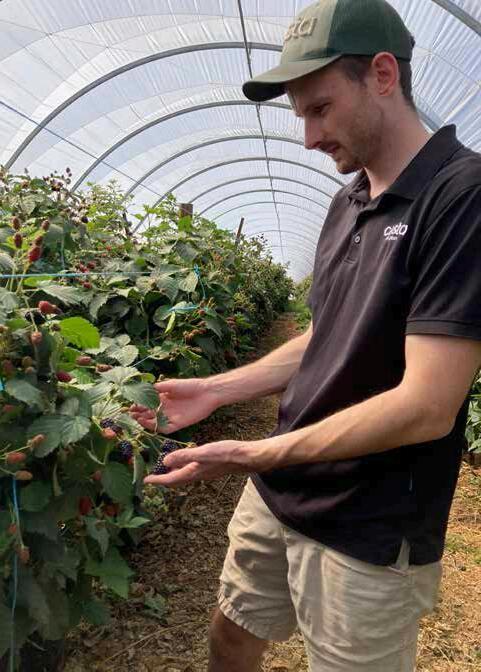
Henry’s career with Costa began in Tasmania during his senior secondary school, where he would work with the company’s maintenance team during his summer holidays. After a brief stint studying science at Swinburne University of Technology in 2015, Henry transferred to Monash University where he graduated in 2020 with honours as an engineer. During this period of study, Henry continued to spend his summers working for Costa Group in several casual harvest coordination roles.
In 2020 Henry signed on as a full-time member of the Costa team, first as a Harvest Lead and as part of Costa’s continuous improvement team. In 2021 he began a new full-time role as the workforce planning and analytics lead to help the operational team with their decision-making during harvest. In 2022, Henry was appointed Harvest Manager for Costa’s Berry Operations in Queensland.
Labour requirements
Costa have berry production sites in four states, which each have the following seasonal labour needs:
• Tasmania – 1500 employees
• New South Wales – 2000 employees
• Western Australia – 150 employees
• Queensland – 150-200 employees
Henry Scott examining the blackberry crop at Costa Berries in Tasmania
51
Photo credit: Mark Salter, Fruit Growers Tasmania
RUBUS
To meet the workforce needs of these farms, Costa Group recruit through three different labour streams, which include two labour hire companies and their own recruiting program. Costa source the majority of their harvest labour through the Pacific Australia Labour Mobility (PALM) Scheme, as well as a smaller proportion of backpackers and local workers.
Henry concedes the greatest challenge is having the optimal number of pickers at any given time and place during the harvest period. He also likes to get a feel for the various stages the crop is sitting at any given time, which helps with the harvest labour forecasting and decision-making process.
Forecasting plays a big role in having the right amount of people in the right places at the right time, which is particularly challenging given fruit volumes vary greatly throughout the peaks and troughs of the harvest season, and can be impacted at very short notice by adverse weather events.
Building leaders
Costa have a big focus on training to help new harvest workers to be as productive as possible, and a major part of Henry’s role is developing training programs for harvest labour, harvest leaders and supervisors. He believes having good supervisors and harvest systems and providing a long harvest season helps make Costa a more attractive option compared to the many other horticultural harvest opportunities.
With limited people willing to take up seasonal work opportunities, one of Henry’s challenges is making sure Costa remains an ‘employer of choice’, particularly for the transient labour sector. To achieve this, Henry takes a very hands-on approach and spends a great deal of time in the field helping with training delivery and seeking continuous feedback from everyone within the operation.
Harvest supervisor selection and training focuses on those workers that have prior harvest experience and who have demonstrated a strong connection, rapport, and respect for their team. Supervisors are trained in team leadership and to have a good understanding of the harvest KPI’s, the mechanics of harvest, and be skilled at easily explaining daily messages to their team members. This is particularly important as the dynamics in the field change constantly during the harvest period.
Workforce training
For the wider workforce, Costa Tasmania split their labour into two groups, including a harvest group and an operational group. Henry explains that approximately 60% of Costa’s harvest workforce are returning workers, with some returning back to Costa for over 8 years. Returning workers make up an important part of their harvest team, as these workers have previously been through the company’s training programs and are more experienced, more productive and require less supervisory time to manage. It’s also rewarding to see their development within the operation.
Training for new harvest workers begins in their country of origin where the program will focus on the selection process and preparing workers for picking prior to their departure. Once they reach the farm, the focus of training shifts to teaching workers the correct picking techniques and helping them to develop speed and efficiency. For new pickers Henry has developed a harvest training program that focuses on working in small picking groups, and once pickers are more confident, they will progress to become part of a larger picking team.
The operational team play a supportive role in the business, focusing on tunnel construction, maintenance, tractor work and driving the harvest chariots, and can also assist with the harvest if needed. At the end of the season these workers stay on to prune, mow down the canes, and plant new plants in preparation for the next season.
Having farms in multiple regions and states also gives some of Costa’s harvest team the opportunity for more work, with PALM scheme workers able to take up a variety of visa timing options. This strategy helps to maintain the optimal number of people during harvest period, and rewards good workers with opportunities for longer term employment.
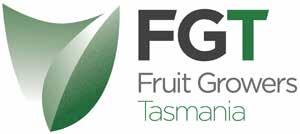
52 BERRY AUSTRALIAN JOURNAL WINTER 2024 EDITION 19
Mark Salter visits Queensland
Berry Industry Development Officers: Wendy Morris (Queensland) & Mark Salter (Fruit Growers Tasmania)
With Rubus IDO, Mark Salter, approaching retirement it was time for him to make one last tour of Queensland raspberry farms. This article gives an overview of Mark’s visit cramming in seven farms, two regions and two dinners in just three short days.
Joining Queensland Berry Industry Development Officer Wendy Morris, the tour started at the Wamuran site of Piñata Farms where outgoing farm manager Liam Riedy was busy with strawberry planting. Piñata currently grow strawberries across a mix of in-ground and tabletop production areas, and like many growers in the region this year planting was delayed due to extended periods of wet weather. Piñata also grow Rubus in Wamuran, and to extend the season of their crop Pinata implement various techniques including staggered planting and pruning timing. This ensures the crop is spread throughout the season which also helps with managing harvest labour.
The next stop was to visit Angelo Pinna from Athea who grows a couple of hectares of ‘Kwanza’ raspberries under tunnels. This Perfection Fresh variety was selected because it produces large volumes of excellent eating fruit. An experienced berry grower, Angelo knows his plants and uses their appearance and growth pattern to identify water and nutritional needs – a skill that was confirmed later in the week by Frank Scherpenseel from Perfection Fresh! Angelo has also created his own trellising system with a distinctive v-shape that allows for more effective pest and disease management.
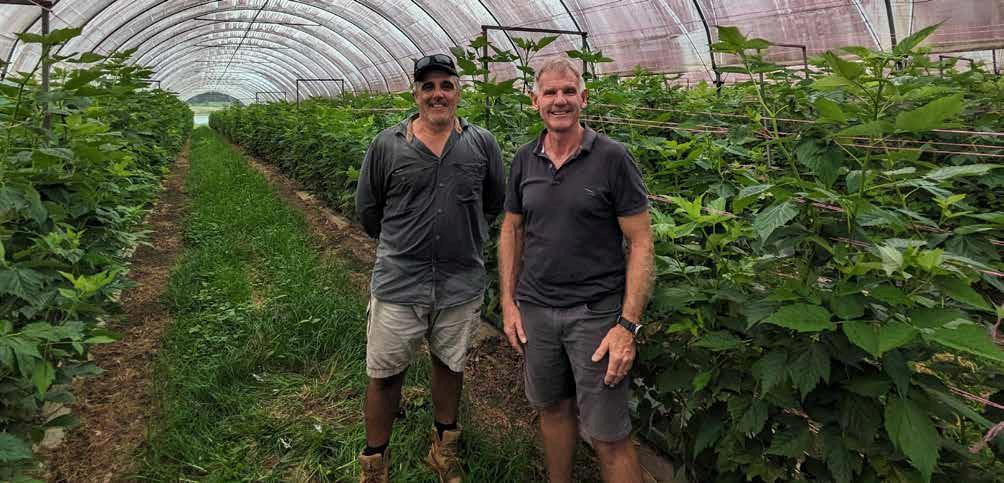
53 RUBUS
Angelo Pinna (L) and Mark Salter (R) in the tunnels at Athea where the Perfection Fresh ‘Kwanza’ variety of raspberries are grown. Photo credit: Wendy Morris
Innovations in trellising were also seen at the next stop, Queensland Berries at Caboolture, where Richard McGruddy took Wendy and Mark on a comprehensive tour of the farm. Some of the raspberry blocks were close to harvest while other blocks were just breaking bud where the canes have recently been transferred from the cool store and released into the tunnels.
Richard has a green cane storage facility where the raspberry canes are stored at below zero until they are ready to go into the tunnels. The canes are placed in the cool store to accumulate chill hours and then are gradually released into the tunnels at regular intervals which helps to lengthen the total harvest window.
Blackberries and strawberries are also grown on the Queensland Berries Caboolture site. The blackberry crops were approaching harvest, while strawberries were being planted ready for the winter production window. Interestingly, to ensure the delicate strawberries are
planted with proper care and attention, the planting shift length is shortened to around six hours which prevents workers from becoming overtired and careless.
Meanwhile, expansions at the farm were well underway. A new style worker’s accommodation prototype was in place. The ‘donga’ comes complete with two bathrooms and a private kitchen and is designed to house four people. This will reduce the pressure on communal kitchens for the hundreds of staff required at peak harvesting times. In the strawberry production areas, new open air tabletop infrastructure was being installed in fields that were previously used for in-ground planting only.
After a busy day, it was time to hold the first of the two grower dinners. Approximately sixty growers and members of industry attended, and the evening featured presentations from the Queensland Department of Agriculture and Fisheries team and Growcom, as well as plenty of time for networking.
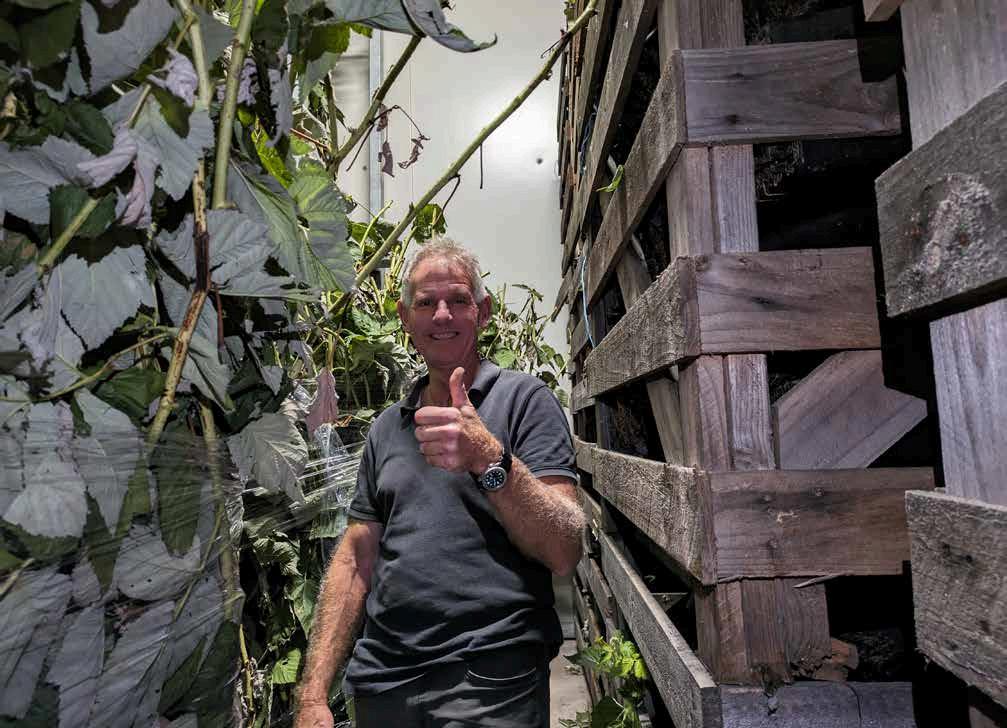
54 BERRY AUSTRALIAN JOURNAL WINTER 2024 EDITION 19
Mark Salter inspecting the canes being held in the cool store at Queensland Berries Photo credit: Wendy Morris

Dr Jodi Neal, Principal Plant Breeder and lead of the Australian Strawberry Breeding Program (ASBP), talked to growers about new varieties under trial, and there was open discussion about establishing a clearer understanding of the nutritional requirements for new varieties. my Nash, the new Queensland Agriculture Workforce Network (QAWN) Officer for south east Queensland also spoke to growers about the grants that are available to assist with training existing staff.
The next day the pair commenced the long trip from Caboolture to Stanthorpe where the first stop was Nathan Baronio from Eastern Colour, a farm which grows both strawberries and apples. The strawberries are grown on tabletops in polytunnels, and Nathan explained they have just moved their last block of in-ground strawberries to tabletops for improved production and harvest efficiencies.
Nathan has been proactive with improving irrigation efficiencies and has developed extra water storage to future-proof the farm in the event of another drought. He also mentioned that the very hot weather during the summer season had an adverse effect on fruit size, a fact which has been highlighted by some of the research reported on by Christopher Menzel in this journal previously. Due to a strong relationship with retail partner Woolworths, Nathan was able to agree a variation in the fruit size specification for smaller strawberries helping the business to sell the smaller fruit which would otherwise have been wasted.
A second grower dinner was held at the Stanthorpe Central Hotel, with similar topics to the previous night being discussed amongst the twenty growers and industry stakeholders who attended.
55
Richard McGruddy (R) showing Wendy Morris (L) the new tabletops in the final stages of installation at Queensland Berries. Photo credit: Mark Salter

 Richard McGruddy inspecting the blackberry canes at Queensland Berries
Photo credit: Wendy Morris
New long cane raspberry plants in tunnels at Queensland Berries
Richard McGruddy inspecting the blackberry canes at Queensland Berries
Photo credit: Wendy Morris
New long cane raspberry plants in tunnels at Queensland Berries
56 BERRY AUSTRALIAN JOURNAL WINTER 2024 EDITION 19
Photo credit: Wendy Morris

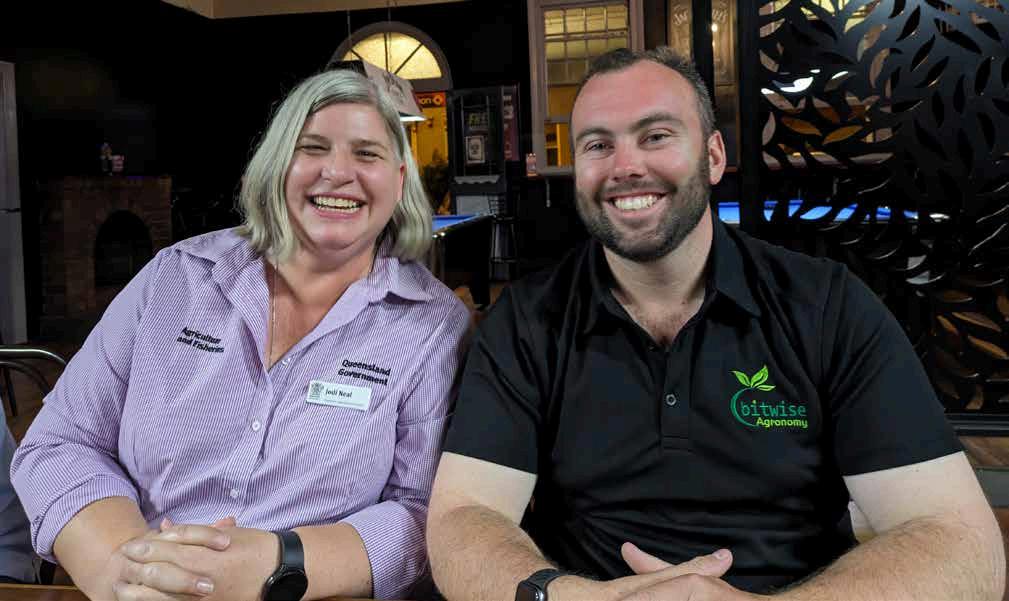 Attendees at the grower dinner held at the Sandstone Point Hotel on day one of Mark’s visit
Photo credit: Wendy Morris
Jodi Neal from QDAF (L) and Dylan Bellchambers from Bitwise Agronomy (R) at the Stanthorpe dinner
Attendees at the grower dinner held at the Sandstone Point Hotel on day one of Mark’s visit
Photo credit: Wendy Morris
Jodi Neal from QDAF (L) and Dylan Bellchambers from Bitwise Agronomy (R) at the Stanthorpe dinner
57
Photo credit: Wendy Morris
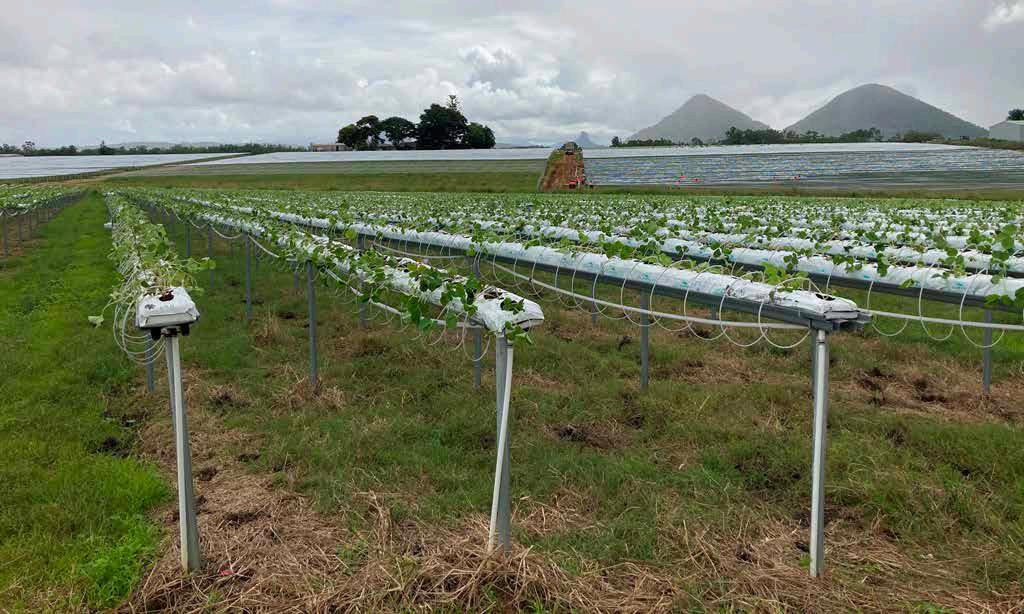
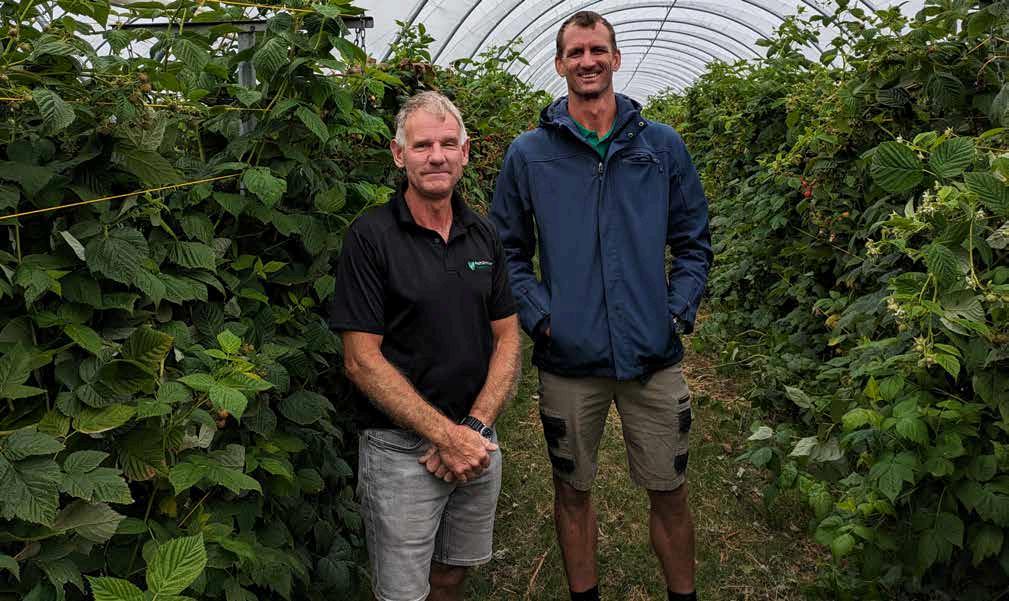 Strawberry plugs recently planted in tabletops at Pinata Farms in Wamuran
Photo credit: Wendy Morris
Mark Salter (L) and the new General Manager for Berries at Piñata Farms Johan Oosthuizen (R)
Strawberry plugs recently planted in tabletops at Pinata Farms in Wamuran
Photo credit: Wendy Morris
Mark Salter (L) and the new General Manager for Berries at Piñata Farms Johan Oosthuizen (R)
58 BERRY AUSTRALIAN JOURNAL WINTER 2024 EDITION 19
Photo credit: Wendy Morris
On Mark’s final morning, the pair met Johann Oosthuizen from Piñata Farms, where Johann has just started as General Manager – Berries, taking over from Liam Riedy who is leaving the business soon. ‘Diamond Jubilee’ raspberries are successfully grown under polytunnels on the farm, as well as tabletop strawberries. As with Eastern Colour, they had found the hot weather had impacted on the size of their strawberries, with fruit size well below average yet at the same time maintaining a good quality taste profile.
Later that day, it was time to head back to Caboolture for two last grower visits. Frank Scherpenseel at Perfection Fresh and one of his graduate students, Lin, made time in their busy schedule. Frank is working closely with strawberry growers this season to ensure that their plants establish quickly and with minimal pest and disease issues. The discussion covered several issues including the outlook for the season, minor use permit access to chemicals and seasonal labour availability.
Lastly, Wendy and Mark met with Paul Dydula from Paradise Berry Propagators. This newly established plant propagator supplied their first strawberry plugs to the market this year, with the plan of increasing the number of plugs available next year. Interestingly, the business is using mostly local labour on their farm. Paul says the advantage of employing locals is that most of them return to work on the farm year after year and so have valuable experience.
The trip was an excellent opportunity to see raspberry varieties being grown from BerryWorld, Driscoll’s and Perfection Fresh. The value of the different breeding programs was evident, with fruit offering excellent taste and colour, and having greater longevity than earlier varieties. It was also interesting to see how important it was to trial different trellising systems, and the impact that the different styles can have on pest and disease management.
The impact of the extreme weather fluctuations in the south east Queensland truly can’t be understated. The hot summer resulted in smaller fruit across the board, and necessitated careful adjustments to watering to protect plants from stress. The wet start to the winter season has delayed planting and many growers have not had sufficient time to properly prepare their fields.
Thank you to all of the growers who gave up their valuable time to meet with us, and everyone who attended the dinners, and a big thank-you to Mark Salter for sharing his expertise with the Queensland growers. Mark, we hope that you enjoy your well-earned retirement.
 Mark Salter (L) and Brock McDonald from Growcom (R) at the Stanthorpe dinner
Mark Salter (L) and Brock McDonald from Growcom (R) at the Stanthorpe dinner
59
Photo credit: Wendy Morris





Covering You
Cultivate success with Elite Tunnels , a premier manufacturer and global supplier of premium field-scale multispan polytunnels, innovative substrate gutter systems, and a comprehensive range of ancillary parts.
Our valuable expertise, versatile polytunnel solutions and personalised guidance, available from small family farms to large commercial operations, can unlock your farm’s full potential.
Optimise your polytunnels for peak yields and profitability with our comprehensive stock of replacement plastic and other essential polytunnel maintenance supplies .
Browse our diverse range of multispan polytunnel models and essential
ancillary parts on our website. Plus, explore eye-catching drone footage showcasing our polytunnel projects on Australian farms.
Visit www.elitetunnels.com
Let’s talk tunnels...
Global Sales Manager
Ross Watt ross@elitetunnels.co.uk
Mobile: +44 (0) 7841 532 652
Office: +44 (0) 1356 648 598
Australia
Tapex Group – Sales enquires
sales@greenlifegro.com.au
Telephone: +61 2 9502 6000


Proud associated members of:
sourced.
Our materials are proudly UK and EU
What yield pattern are you aiming for?
Helen Newman, Berry Industry Development Officer, Agricultural Produce Commission
This article provides a summary of the information presented by strawberry expert Klaas Plas at the Fruit Growers Tasmania & Berries Australia webinar for strawberry growers and propagators held on 28 February 2024.
You can access a recording of the webinar at bit.ly/BA-Klaas-Plas or scan this QR code.
Thank you to Fruit Growers Tasmania for hosting and sharing this Webinar recording
Strawberry expert Klaas Plas explains the basics of strawberry tray plant production and techniques that can be used to achieve different target yields and harvest timings.
Before you decide what type of planting material you need, you must first determine what fruit production window you are aiming for. Do you want long, stable production? Or do you want a high yield in a short window? Or do you want a big first flush followed by a gap then a second flush?
There is a direct relationship between the diameter of the crown and the number of flower trusses on a strawberry plant. Plants with more developed flower trusses will yield earlier after planting but will have a shorter production period. Plants with less developed crowns will yield later but will keep fruiting for a longer period. Fruiting patterns can also be manipulated in the nursery with temperature treatments (such as cold treatment/Frigo) and in the field with alterations to growing conditions.
The different yielding patterns produced by the different plant types can be used to smooth out the fluctuations in harvest volumes. They can also be used to produce big volumes in short target windows.
Classes of strawberry planting material
In Europe, there are three main classes of bare-rooted plants and three classes of tray plants. Each class varies in crown diameter and expected yielding pattern.
Bare-rooted plants
These are traditionally grown in the soil and are sold with bare roots. The process of harvesting strawberry runners from the soil strips the tiny hairs from their roots, so the plants must put energy into regrowing their root system before they can produce leaves and then quality flowers and fruit. This makes them later fruiting than plug and tray plants with similar-sized crowns.
There are three main classes of bare-root plants:
B: 10-14mm crown diameter, little crown development, no flower trusses, later longer production period expected. These plants need to develop leaf trusses and then later flower trusses in the field. Flower induction must happen in the field.
A: 14-16mm crown diameter, with one or two flower trusses.
A+: >16mm crown diameter, flower trusses present, strong early production expected. These plants can be cold stored (Frigo), so they are available to the grower when needed.
61 STRAWBERRIES
SCAN ME

1. A class (14-16mm crown diameter, with one or two flower trusses). Photo credit:
Plug plants (~80 cm3)
Plugs are the smallest category of tray plants and are normally 2.5 to 3.5 weeks old when they are supplied to a strawberry grower.
Plugs do not have flower trusses so flower induction must happen in the field.
Plug plants do not have an early first flush, but produce fruit for a longer period than more advanced planting materials.
Nursery tip: In the nursery, trays of plug plants can be placed side by side to maximise space efficiency without causing problems with shading (overshadowing from adjacent plants).
 Figure
Klaas Plas
Figure
Klaas Plas
62 BERRY AUSTRALIAN JOURNAL WINTER 2024 EDITION 19
Plug plant (80cm3). Photo credit: Klaas Plas
Mini tray plants (~135cm3)
Mini tray plants are normally between 5 weeks and 5 months old when they are supplied to a strawberry grower. These plants can be cold stored (Frigo), so they are available to the grower when needed.
Mini tray plants should have at least two crowns and three to five flower trusses (in the case of 5-month-old plants). With a larger crown and developed trusses, earlier fruiting, and higher early yields can be expected from these plants.
Nursery tip: In the nursery, Mini tray plants need to be laid out so there is one tray space between each tray to minimise overshadowing (10% shading in the nursery = 10% first flush loss, 20% shading = 20% first flush loss). Flowers that develop in the nursery must be removed so that energy is conserved and used to build the crown.
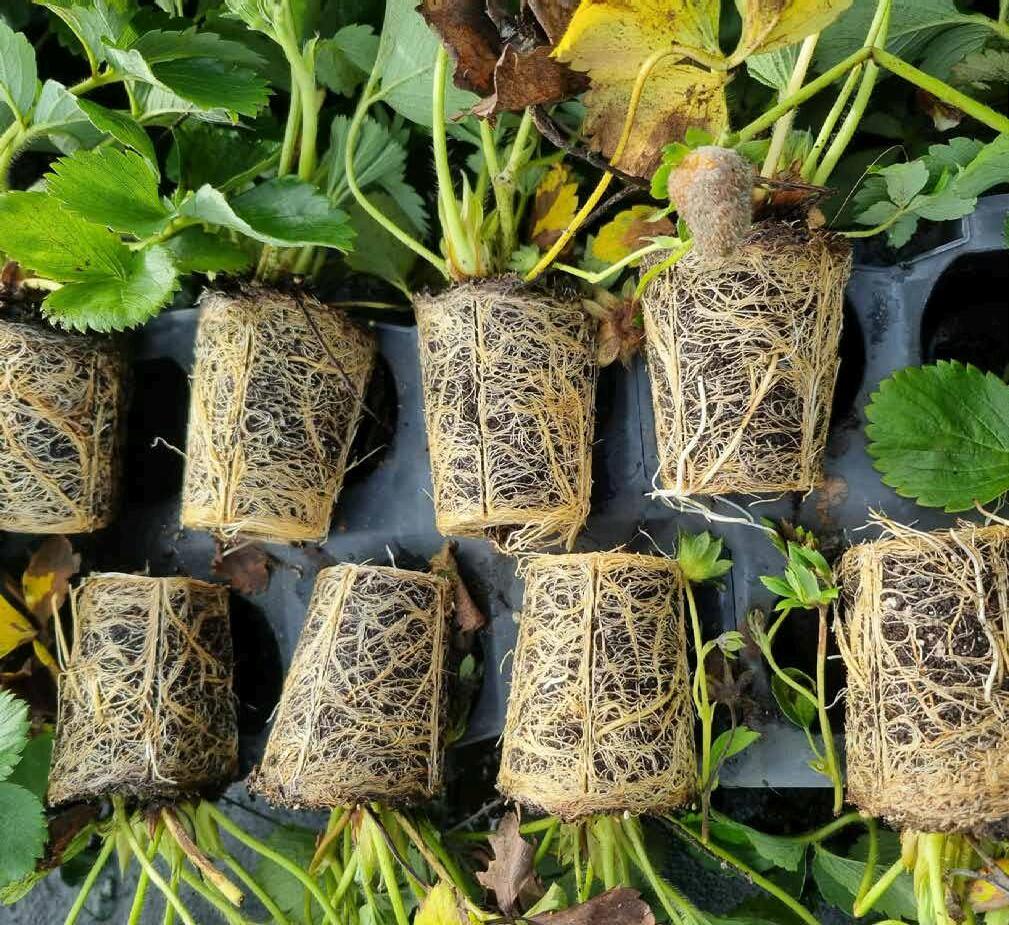
63
Tray plants (~135cm3). Photo credit: Klaas Plas
Tray plants (~250cm3)
Tray plants are the largest category of plant grown by European propagators and are normally up to 5 months old when they are supplied to a strawberry grower. Tray plants are also used in Canada where they are supplied to the strawberry grower at about 2 months old as a ‘fresh’ plant.
These plants can be cold stored (Frigo), so they are available to the grower when needed.
These plants should have at least three crowns and four to seven flower trusses.
With an even larger crown and more developed trusses, early fruiting and higher early yields can be expected from these plants. Strong fruiting is also expected after the first flush with already well-developed crowns and leaves.
Nursery tip: In the nursery, tray plants need to be laid out so there is one tray space between each tray to minimise overshadowing. Some nurseries make the spaces smaller (50-75% of the tray width) depending on economics and considering the yield penalty of shading.
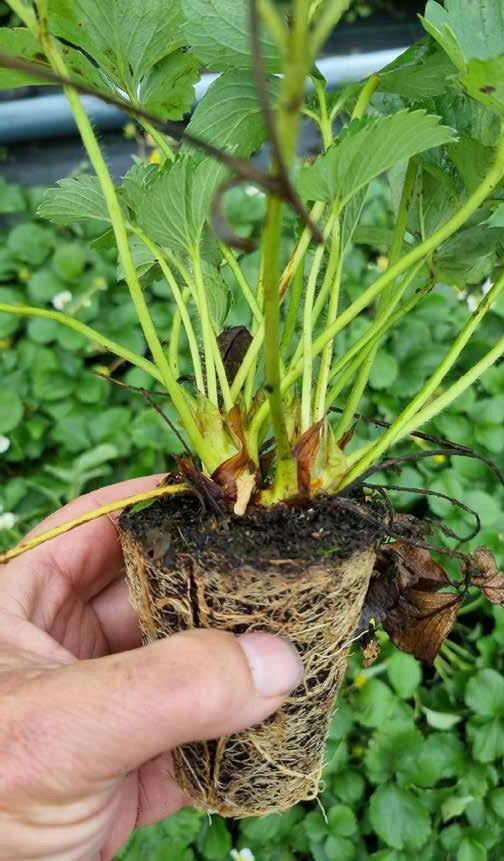
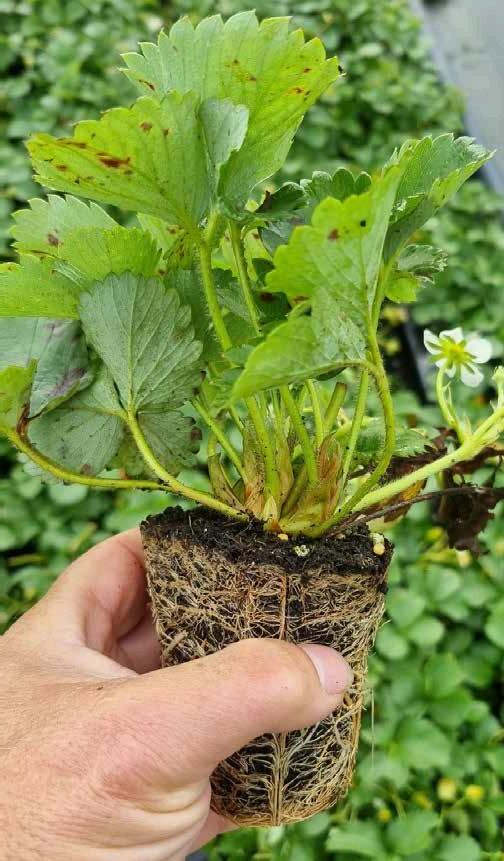
64 BERRY AUSTRALIAN JOURNAL WINTER 2024 EDITION 19
Tray plants (~250cm3). Photo credit: Klaas Plas
Yield patterns for different plant types
Figure 2 shows how each type of nursery plant is expected to yield after planting.
The largest size category of plant (Tray plants) is represented by the blue line. These plants produce a large first flush followed by a big dip in production. They then have a smaller second flush before they run out of energy and stop producing.
The second largest size category of plant (Mini tray) is represented by the green line. They have a smaller first flush and a smaller gap between the first and second flush. These plants will produce for a longer period than the larger tray plants.
Plug plants and Class A runners are represented by the red line. These plants do not have a first flush as flower induction must happen in the field. In the case of Class A runners, the first flower trusses need to be removed to get a well-balanced plant. These plants slowly build up their fruit production and will continue to produce fruit for a much longer period.
Tray plants = More trusses, big first flush, big gap after first flush, slightly shorter production period
Mini tray plants = Less trusses, smaller first flush, smaller gap after first flush, longer production period
Plug plants and Class A runners = No trusses, no first flush, longer production period
Plug/Class A runner
Mini Tray
Time
Pre-planting temperature treatments
Frigo/frozen
Frigo is the most well-known pre-planting temperature treatment. It involves storing plants (mainly A+ runners, mini tray, and tray plants) at -1.7°C and almost 100% humidity for up to 11 months.
Frigo is often used on larger plants to achieve large volumes of fruit in a short production window. These plants produce more runners and have big peaks and troughs in production.
Fruit production Tray
65
Figure 2. Expected fruit-yielding patterns of the different nursery plants
Nursery tip: Growing media must be kept moist (but not saturated), and temperatures must stay above -1.7°C to avoid frost damage.
Ambient
These are summer-producing plants that are propagated in autumn and overwintered in a greenhouse for planting in spring. Storing plants at ambient temperatures (10-12ºC with some natural chill), as opposed to cold storage, results in more stable and longer production.
Yield patterns for different pre-plant treatments
Figure 3 shows the results of trials conducted by Flevo Berry, a breeder in the Netherlands, on the ‘Favori’ strawberry cultivar. Three different pre-planting treatments were tested:
1. ‘Fresh’ Mini tray plants, propagated in winter and planted two and a half months later in spring;
2. ‘Frigo’ Tray plants, planted in winter, two months earlier than the ‘Fresh’ plants.
3. ‘Ambient’ Tray plants, planted in winter, two months earlier than the ‘Fresh’ plants.
These trials have been repeated over several seasons and show that:
• Ambient plants produce the most stable production
• Frigo plants produce big fluctuations in production
• Fresh plants produce a big first flush of fruit, but may have a low leaf area index (not enough leaves to support the fruit (too generative)) so the fruit can be smaller and not as tasty. To remedy this, growers need to prune flower trusses to restore the balance of leaves and flowers in the plant
Weeks 200 180 160 140 100 40 0 17 23 29 19 25 31 36 21 27 33 38 18 24 30 35 20 26 32 37 22 28 34 39 80 120 60 20 Yield (g) 66 BERRY AUSTRALIAN JOURNAL WINTER 2024 EDITION 19
Figure 3. Comparison of yield patterns for Fresh (GREEN), Frigo (BLUE), and Ambient (RED) treatments in trials on cultivar ‘Favori’ conducted by Flevo Berry in the Netherlands.
Balancing vegetative and generative growth
Vegetative

Vegetative plants have a high leaf area index and few flowers. The first flush of fruit off a young vegetative strawberry plant will be less than that of a generative plant. This is countered by a second flush that comes soon after the first flush and produces large, tasty berries.
Generative

Generative plants have few leaves and a lot of flowers. The first flush of fruit off these plants is larger but fruit are generally smaller and unpleasant tasting. These plants also take longer to recover from the first flush, so the second flush of fruit is delayed.
Balance is key! Leaves provide energy to the strawberry plant so that it can produce fruit. A balance between vegetative and generative growth is needed to achieve good yields of large flavoursome berries.
If you have a plant that is too generative, your aim will be to encourage more vegetative growth. If your plant has become too vegetative your aim will be to move it towards more generative growth. You can do this by changing the plants growing conditions (Table 1).
Note: if a plant becomes too vegetative it is quite difficult to shift it back to a generative state. Also, there is quite a bit of variation between varieties; there are generative varieties, vegetative varieties, and varieties that are somewhere in between.
The quickest and easiest way to move plants between vegetative and generative growth is to change the nitrogen applications. Applying more ammonium (NH4) will encourage vegetative growth. If there is too much vegetative growth, removing ammonium from the fertiliser program will make the plant more generative. Irrigation practices can also be used to change the growth phase but can be a little riskier. Other climatic factors that influence the growth phase, such as the difference between day/night temperatures, are more difficult to manipulate.
67
Photo credit: Klaas Plas
Table 1. How to move plants between vegetative and generative growth phases
* If a plant has too many flower trusses and the prevailing climatic conditions are generative (e.g. high temperature and radiation levels in summer), some flower trusses can be removed to get the plant back into balance and promote larger, better-tasting fruit. This technique should be used with caution at other times of the year.
vegetative growth Encouraging generative growth
temperature difference Small Big Winter heating (greenhouse) Daily start time Earlier Later Evening temperature decline Slower Faster Afternoon temperature rise Low High Average temperature Low High Relative Humidity (RH%) Higher Lower Screening (shading the crop) More Less Irrigation & fertiliser Drip pH 4.8 to 5.3 5.3 to 5.7 EC substrate Lower Higher Drip EC Lower Higher Substrate moisture Wetter Dryer Irrigation pulses Shorter Longer Drip frequency More frequent Less frequent Nitrogen High Low NH4 High Low – none Mechanical work Removing flower trusses With caution* No Removing leaves Seldom Often Removing runners Often Seldom Ease of applying the change: Easy to change Can change Difficult to change 68 BERRY AUSTRALIAN JOURNAL WINTER 2024 EDITION 19
Encouraging
Climate Day/Night
Tips for nursery growers
Klaas provided some specific information on how to produce plug and tray plants and examples of production techniques used throughout Europe.
Propagation = vegetative growing
In propagation, the aim is to get runners and tips, rather than flowers and fruit, so the plants need to be maintained in the vegetative growth state. Big strong leaves with a high leaf index and few flowers are what’s needed. In the vegetative growth phase, you don’t need to remove as many flower trusses and instead of flower trusses, your plants produce runners.
In practice, the easiest way to maintain a vegetative plant is with high nitrogen applications (27-32mg/L NH4 and 682-806mg/L NO3) and high substrate moisture content – relatively wet substrate but not waterlogged. If there are high levels of radiation, shading will also help.
Mother plants also need to have enough cold hours to develop runners. Cold hours are measured as the number of hours below 7ºC. The number of cold hours needed depends on the variety and is generally in the range of 1000-1500 hours. Tissue culture plants don’t require cold hours as the hormones that stimulate runner production are already stimulated by the tissue culture process – they are already vegetative and will produce runners without cold hours.
Tip: When planting mother plants into the coir slab, base the spacing on the number of crowns per lineal metre, not the number of plants per lineal metre. More crowns = more potential runners. Aim for 15-20 crowns per lineal metre. Remove any flower trusses on the mother plants and maintain a vegetative growing environment.
Nutrient MillimolesMilligrams per litre (mg/L) Ammonium (NH4) 1.5 – 1.75 27-32 Nitrate (NO3) 11 – 13 682-806 Potassium (K) 4.25 166 Calcium (Ca) 4.25 170 Magnesium (Mg) 1.5 36.5 Phosphate (PO4) 1 95 Sulphate (SO4) 1.5 144
Iron (Fe) 35 1.95 Manganese (Mn) 40 2.2 Zinc (Zn) 12.5 0.82 Boron (B) 15 0.16 Copper (Cu) 0.75 0.048 Molybdenum (Mo) 1 0.096 69
Table 2. Fertiliser recipe recommended for maintaining growth in mother plants
Micromoles
Coir the substrate of choice
Coir is the substrate Klaas recommended for plug and tray production because of its stability and structure which provides a good balance and distribution of air, water, and nutrients around the roots. Other products frequently contain a fine/dust fraction that washes down the profile with frequent irrigations. This creates a layer that blocks drainage and causes waterlogging in the cells.
Tip: Frequent irrigations are essential as moisture levels in the trays must be maintained at all timesplants must not dry out at any stage.
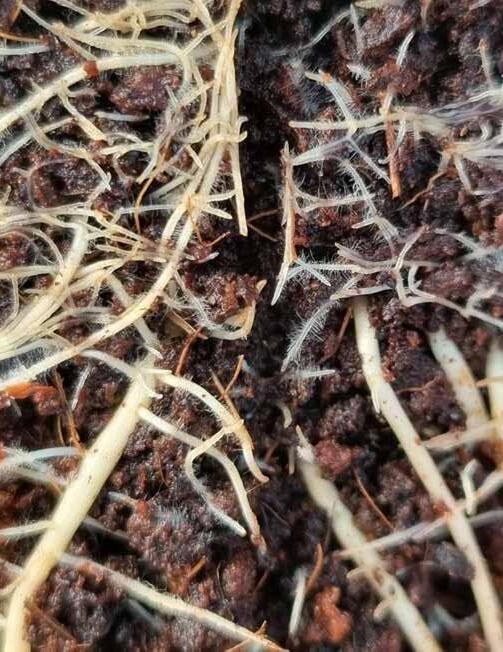

Heat treatment
This is a relatively new technique that is being used by growers in Hungary. They propagate (stick) plants into their coir cells and place them in a closed tunnel where the humidity is maintained at 100% for the first week using misting sprinklers that turn on and off throughout the day.
During this time, temperatures in the tunnels are allowed to reach a maximum of 50ºC for an hour or so each day (temperatures above 50ºC will result in damage). This high temperature-100% humidity environment has been found to kill off pests, diseases, and viruses.
This concept is like the aerated steam technique reported in the article ‘The use of heat in horticulture for pest and disease control’ published in the Summer 2023 Edition of the Australian Berry Journal (PAGE 99-101) available at the Website Resource Library
70 BERRY AUSTRALIAN JOURNAL WINTER 2024 EDITION 19
Healthy root growth in coir substrate. Photo credit: Klaas Plas
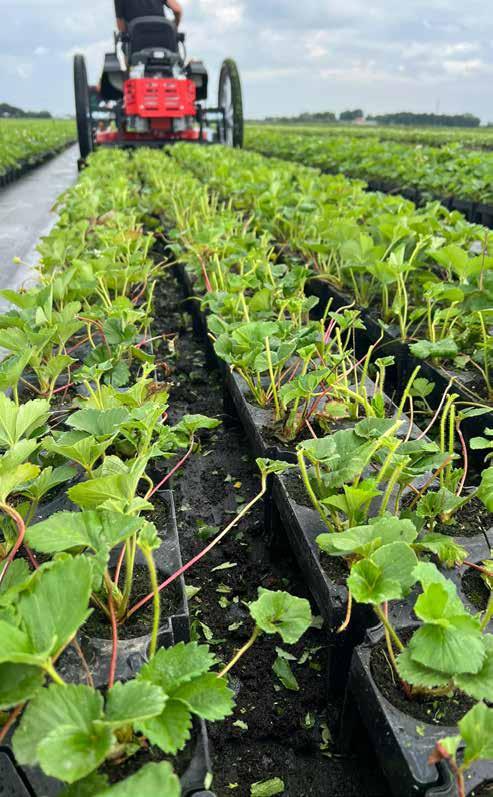
Under good circumstances, tray plants produce one leaf per week, so the plants are mown to keep them low. Mowing can only be used on pest and disease-free plants
Photo credit: Klaas Plas
More Resources
Klaas is very generous with the information he shares in his presentations and on his website. Links to these are provided below.
The more we learn about strawberry physiology, the more questions we have, so with this in mind we plan to have more sessions with Klaas in the future. If you haven’t already, please let your local IDO know what topics interest you the most.
Follow the links below or search “Klaas Plas” on the Website Resource Library at https://berries.net.au/ resource-library
• Webinar with Klaas Plas: Strawberry nursery tray plug plant quality, 28 February 2024 https://vimeo.com/917783235/7b43d082f7
• 2022 Webinar with Klaas Plas: Flower Mapping https://vimeo.com/751521288
• 2020 Webinar with Klaas Plas: Strawberries in Balance & Integrated Pest Management https://youtu.be/KhxHOXjsIps
• 2024 document: Irrigation strategies for vegetative/ generative growth https://berrykonsult.com/wpcontent/uploads/2024/03/Irrigation-Strawberry.pdf
• Klaas Plas Berry Konsult website: https://berrykonsult.com/en/author/klaasplas
• Beekenkamp Packaging website (to see the plastic trays referred to in this article) bit.ly/Beekenkamp
About Klaas Plas
Klaas Plas is a strawberry expert from the Netherlands with over 30 years’ experience in all aspects of strawberry production. Through his company Berry Konsult, he works with growers across Europe, Canada, and Australia. He specialises in current and future integrated pest management practices in strawberries and has extensive experience in strawberry nursery plant quality.
Find out more at berrykonsult.com
71
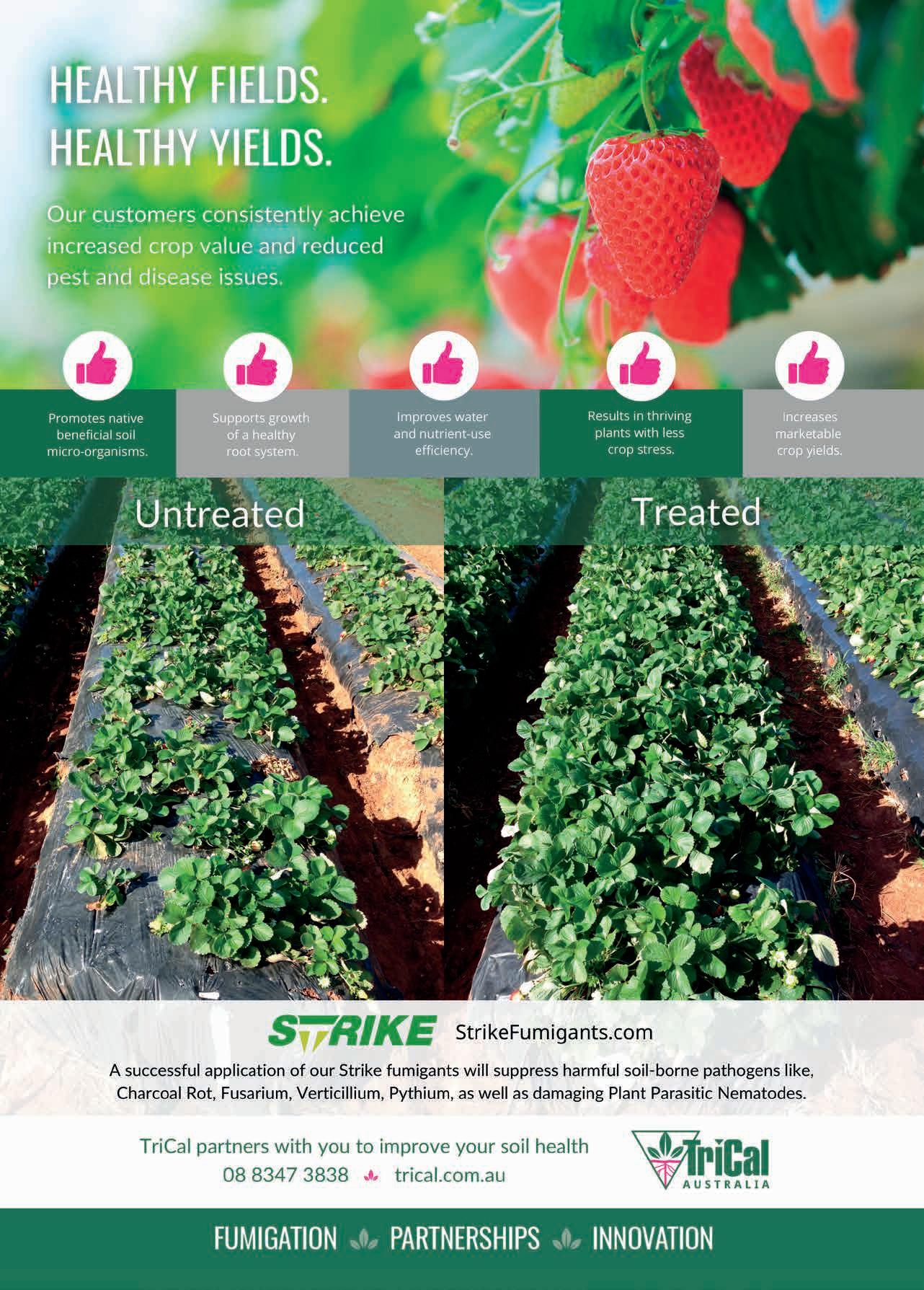
Yields of strawberry plants vary more with the season than with the cultivar
Christopher Menzel, Principal Horticulturist, Queensland Department of Agriculture and Fisheries
• Variations in yield were greater than variations in fruit weight or fruit chemistry across all years and cultivars
• Variations in yield between years (across all cultivars) were greater than the variations between individual cultivars(!)
• There was no correlation between yield and the weather during the study except for during extreme weather events
• Other factors, possibly related to variability in planting materials each season, had an overriding influence on yield
In south-east Queensland, strawberries are produced over winter and spring on the Sunshine Coast and in Bundaberg, and over summer and autumn on the Granite Belt. A wide range of cultivars are grown, including those that are adapted to cold winters and frosts in spring or heat in summer. Cultivars also vary in their need for chilling for flower initiation and the time of flowering and ripening.
The long-term sustainability of strawberry production in the region depends on high-yielding cultivars with acceptable fruit quality in the prevailing weather conditions.
This article reports on the productivity and quality of strawberry cultivars developed in Queensland and Florida. The plants were evaluated over winter and spring on the Sunshine Coast from 2020 to 2023.
Experimental design
Three or four cultivars were planted each year at Nambour in randomised blocks, with six replicates per cultivar (Table 1). Fruit was harvested every week for an assessment of marketable yield (fresh weight) and average fruit fresh weight from June to October. Mature fruit were classified as those that were at least three-quartered coloured. Marketable fruit weighed at least 12 g fresh weight and were not affected by rain and/or grey mould or were misshapen. Information was also collected on fruit total soluble solids content (SSC) and titratable acidity (TA) as citric acid measured at 20ºC in the first three experiments.
Table 1. Dates of planting and the cultivars used in each year of the research
Year Planting date Cultivars 2020 29 April Brilliance, Festival & Red Rhapsody 2021 19 April Brilliance, Festival, Fortuna & Red Rhapsody 2022 20 April Festival, Fortuna, & Red Rhapsody 2023 30 March Brilliance, Festival, Fortuna & Red Rhapsody 73 STRAWBERRIES
Weather conditions during the experiments
Figures 1 to 3 show weather conditions during the experiments. Day temperatures were generally average to slightly higher than average during the experiments (April to October) except for in 2022 which was up to 2ºC cooler than the long-term average.
Night temperatures were more than 3ºC above the long-term average in May 2022 (associated with very high rainfall) but cooler than average from June to August. May 2023 was also cooler than average by 2.5ºC. Other years were generally average.
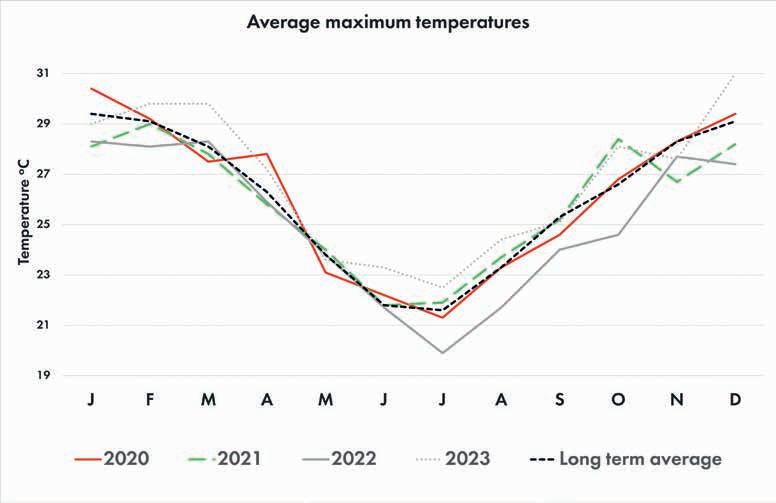
1. Average monthly maximum temperatures recorded at Nambour from 2020 to 2023. The long-term average is from 2007 to 2023.

Figure 2. Average monthly minimum temperatures recorded at Nambour from 2020 to 2023. The long-term average is from 2007 to 2023.
74 BERRY AUSTRALIAN JOURNAL WINTER 2024 EDITION 19
Figure

Overall results
Looking at all cultivars across all years, the variations in marketable yield were greater than the variations in fruit weight or fruit chemistry (Table 2).
When comparing the variation in yield across all the cultivars and years, the variation between years was greater than the variation between cultivars (Tables 2 and 3). In 2020, yields ranged 457 to 617 g/plant, whereas in 2023 they ranged from 330 to 339 g/plant. Figures 4 to 7 give a picture of the variation for each cultivar through each growing season.
There was no association between yield and the weather during the study, except for 2022, when heavy rainfall during May impacted plant establishment and growth.
This suggests that other factors, possibly the size of the transplants each season, had an overriding influence on productivity.
There were variations in fruit size across the cultivars, but the ranking of the cultivars changed with the year. Overall, ‘Festival’ had smaller fruit than the other cultivars.
There were small differences in mean berry chemistry across the cultivars, but no consistent trends. This reflects the low genetic diversity in the cultivars and common ancestors in the two breeding programs in Florida and Queensland. The uniform growing environment (fertiliser, irrigation, sunlight, etc.) may have also contributed to this pattern.
Combined means (averages) of all replicates for all years are presented with standard deviations (±) to show variability.
Cultivar Yield (g/plant) Fruit weight (g) Soluble solids content (%) Titratable acidity (%) Brilliance 412 ± 52 23.6 ± 0.7 7.2 ± 0.1 0.56 ± 0.02 Festival 457 ± 108 21.8 ± 1.5 8.2 ± 0.2 0.64 ± 0.01 Fortuna 392 ± 66 23.3 ± 1.2 7.4 ± 0.2 0.58 ± 0.01 Red Rhapsody 451 ± 118 24.5 ± 0.4 7.4 ± 0.1 0.64 ± 0.02
Table 2. Effect of cultivar on the performance of the strawberry plants across all years.
75
Figure 3. Monthly rainfall recorded at Nambour.
Table 3. Effect of year on the performance of the strawberry plants across all cultivars.
Combined means (averages) of all varieties for individual years are presented with standard deviations (±) to show variability.
Harvest and data collection stops each season when fruit size drops below 12g or fruit becomes too soft for market

76 BERRY AUSTRALIAN JOURNAL WINTER 2024 EDITION 19
Year Yield (g/plant) Fruit weight (g) Soluble solids content (%) Titratable acidity (%) 2020 563 ± 75 22.3 ± 1.5 7.6 ± 0.5 0.62 ± 0.03 2021 497 ± 25 23.0 ± 1.4 7.5 ± 0.3 0.59 ± 0.03 2022 365 ± 11 23.7 ± 1.7 7.7 ± 0.4 0.64 ± 0.04 2023 332 ± 5 23.1 ± 1.4
Figure 4. Average yield of ‘Brilliance’ plants reported weekly throughout the season.
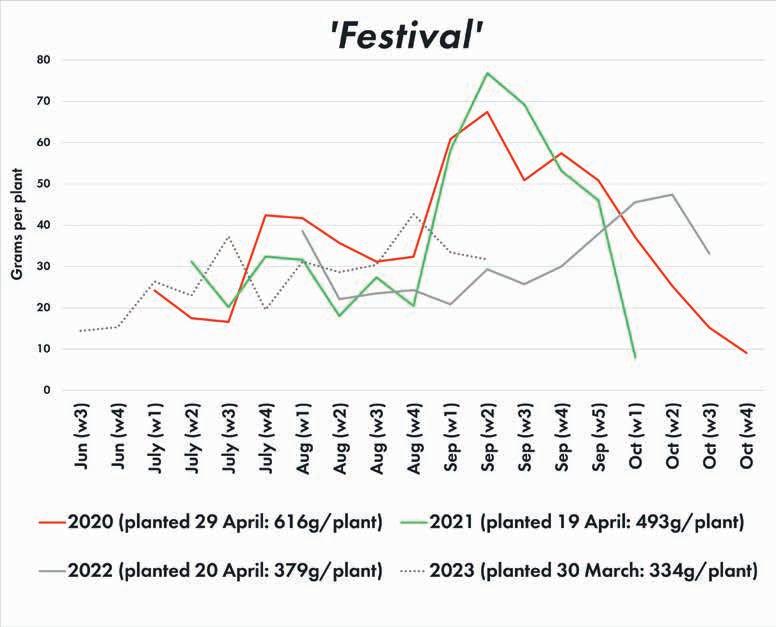
Figure 5. Average yield of ‘Festival’ plants reported weekly throughout the season.
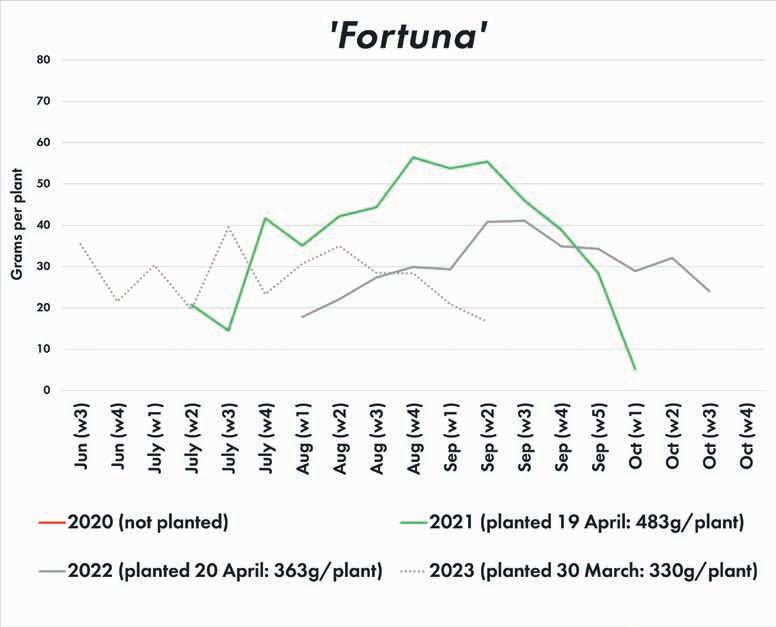
Figure 6. Average yield of ‘Fortuna’ plants reported weekly throughout the season.
77

Figure 7. Average yield of ‘Red Rhapsody’ plants reported weekly throughout the season.
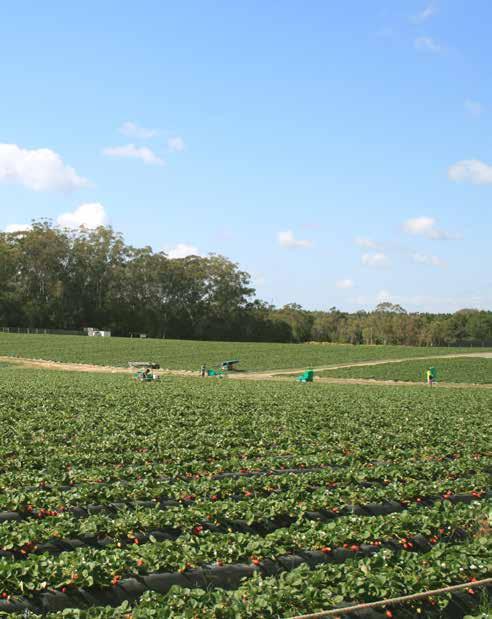
Implications for commercial production
Yields from year to year varied considerably across all varieties during the experiments. Apart from the impact of extreme conditions, there wasn’t a clear association between yield and the weather. Other factors such as the size and quality of transplants appear to have had a greater influence on productivity.
New technologies that provide more established plants and a mixture of plant types that yield in favourable patterns could stabilise overall seasonal yields. This may also allow for earlier planting times that extend the growing season or shift the production window to avoid the warmer temperatures in October.
Across the experiments, warming temperatures in October saw a decline in fruit size and quality which brought the season to an end. To extend the season, efforts need to be made to develop cultivars that continue to produce large, sweet fruit as conditions warm up.
Acknowledgements
The Queensland Government is funding the research through the Department of Agriculture and Fisheries. Many thanks to the Florida Strawberry Growers’ Association (FSGA) for financial support and to Vicki Lane and Helen Newman for your article review assistance.
Strawberry farm on the Sunshine Coast. Yield and fruit quality vary across cultivars and seasons.
Photo credit: Christopher Menzel
78 BERRY AUSTRALIAN JOURNAL WINTER 2024 EDITION 19
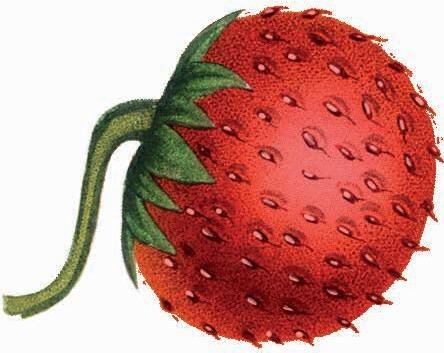
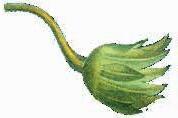

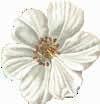
QS GA
INDUSTRY DINNER |
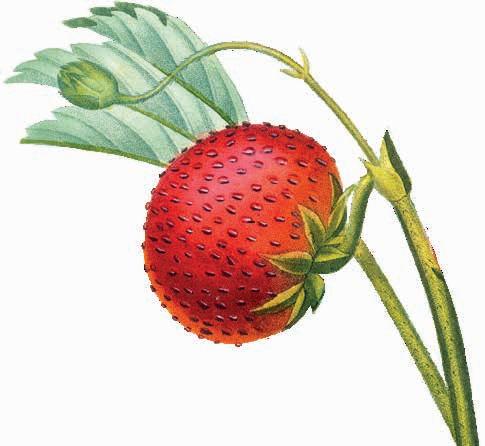


1 JUNE 2024
On behalf of the Queensland Strawberry Growers’ Association we wish to offer our heartfelt thanks to all of our generous supporters without which our annual industry get together would not be possible.
OUR SPONSORS THIS YEAR

PRE-DINNER DRINKS SPONSOR VIP TABLE SPONSORS

TABLE SPONSORS

INDUSTRY SUPPORTER

LUCKY DOOR PRIZES



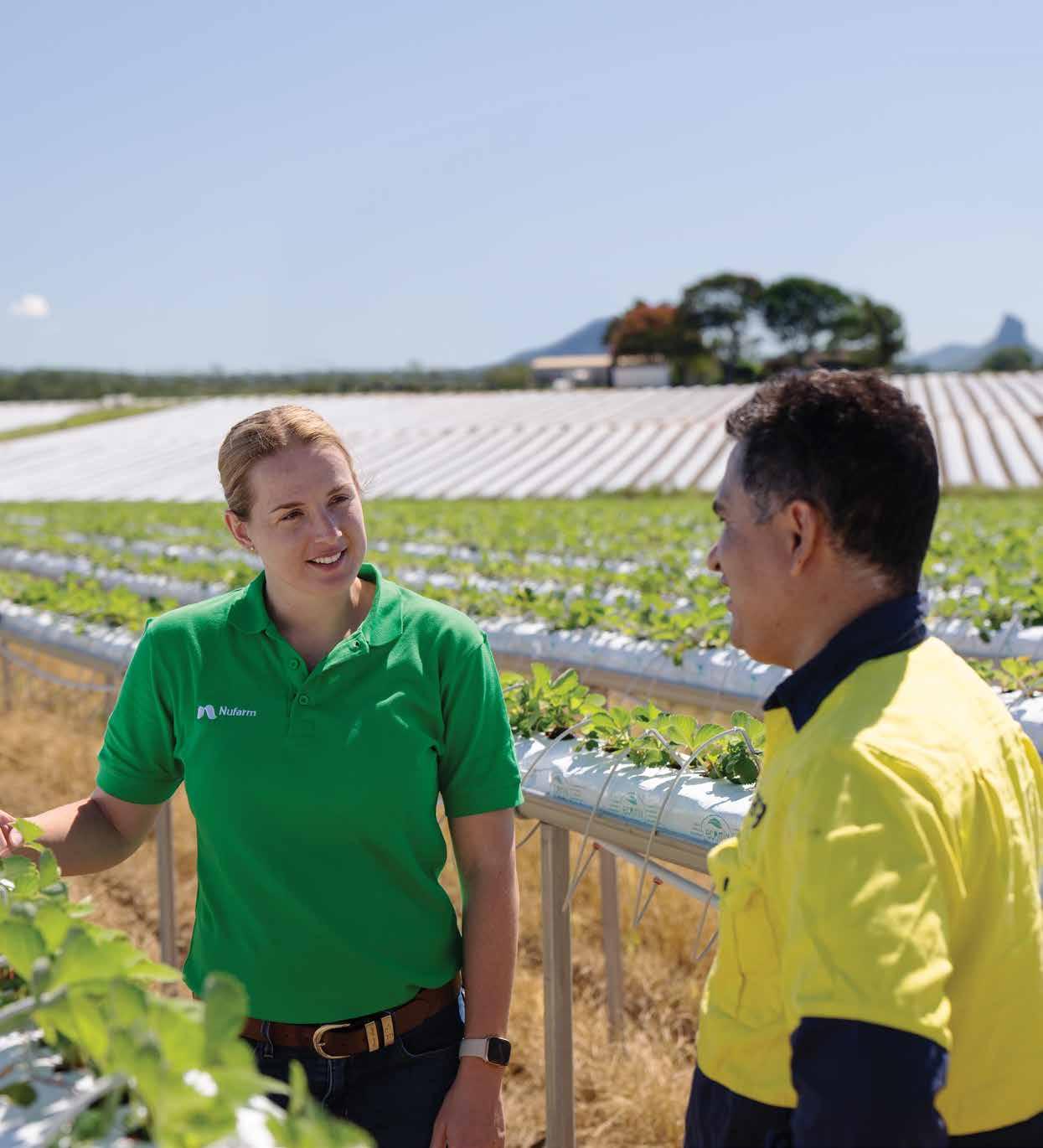
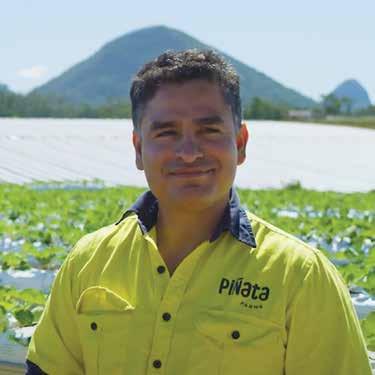
Learn about how Sergio Pérez and Piñata Farms have been using Nufarm Intervene to protect their strawberries.
INTERVEN E ®
056433r01
Management of fruit rot diseases & fungicide resistance: 2024 update
Apollo Gomez, Senior Plant Pathologist, Queensland Department of Agriculture & Fisheries
Fruit diseases, such as grey mould and powdery mildew, are an unfortunate part of strawberry production, in all areas and across all production systems. Use of fungicides is a vital aspect of managing strawberry diseases. In the last couple of years, several new fungicides have been registered for use in strawberry fruit production. It is important to be aware of these new products and their use in disease management. It is equally important is to ensure they are used correctly to avoid fungicide resistance developing. The effectiveness of any chemical programs is only good for as long as it takes for resistance to develop.
An updated list of registered fungicide products for strawberry production is listed on Table 1 and includes relevant information on product FRAC Code/Group, active ingredient, disease controlled. Fungicides with letters ‘M’ and ‘BM’ in their FRAC Code/Group indicates those products have a multi-site activity against the pathogen and are generally less likely to develop resistance. Fungicides with a FRAC Code/Group number only, including ‘U6’, are classified as singlesite fungicides, meaning that they target the pathogen at one specific site. This makes them more prone to developing resistance and why there are maximum limits to how many applications are allowed.

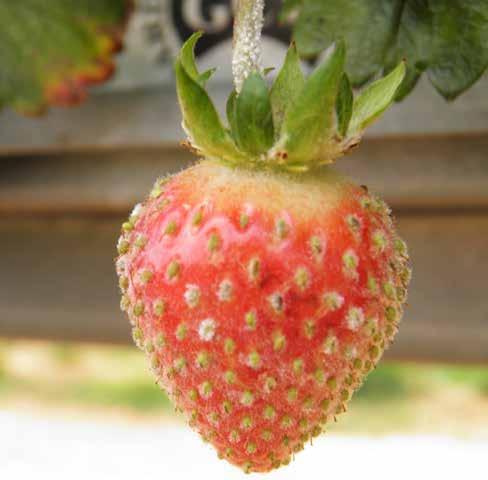 (Top) Grey mould (botrytis) and (Bottom) powdery mildew
(Top) Grey mould (botrytis) and (Bottom) powdery mildew
81 STRAWBERRIES
Photo credits: (Top) Queensland Department of Agriculture & Fisheries (Bottom) Tasmanian Institute of Agriculture
Managing grey mould and powdery mildew
A general strategy to manage grey mould is to rotate multi-site products to provide protection when plants have established after planting and flowers start to appear. Apply single-site fungicides when conditions that favour disease development (e.g. rainy periods) are imminent and rotate with other fungicide groups when disease symptoms persist. Removal of diseased fruits will help reduce the amount of inoculum and further spreading the disease. The severity of grey mould disease is generally dependent on wet periods. Rotation of multi-site products may be enough if disease pressure is low and combined with on-farm practices to minimise disease. In protected cropping systems,
the incidence of grey mould is generally lower than in plants grown outdoors.
Management of powdery mildew differs to that of grey mould. Different production systems (open-field, substrate/tabletops, tunnels, cloches) and the length of the season in different production areas must be considered. Crop consultants may be able to provide a specific and strategic approach for management of powdery mildew relevant to different production areas and systems. As with grey mould management, rotation of powdery mildew fungicides is recommended to manage the disease and minimise the risk of fungicide resistance.
What fungicides are currently available for strawberry fruit production?
Table 1. Fungicides for strawberry fruit production
M2 sulphur
M2 potassium bicarbonate
Various e.g. Thiovit Powdery mildew NSW and WA only
Various e.g. Ecocarb® Powdery mildew
M2 potassium bicarbonate + potassium silicate Ecocarb® PLUS Powdery mildew
M3 thiram
M4 captan
BM02
BM02
Bacillus amyloliquefaciens strain MBI600
Bacillus amyloliquefaciens strain QST 713
Various e.g. Thiram
Various e.g. Captan
Grey mould, black spot 2-day WHP
Grey mould, black spot, scorch, leaf blight, leather rot 1-day WHP
Serifel® Biofungicide Grey mould
Serenade® Opti Grey mould
NC Aureobasidium pollulans Botector®
Data Source: APVMA, CropLife Australia
Grey mould, anthracnose fruit rot, Phomopsis fruit rot, Rhizopus fruit rot
FRAC Code Active constituent Product name Registered for Conditions to note
82 BERRY AUSTRALIAN JOURNAL WINTER 2024 EDITION 19
3 myclobutanil Various e.g. Systhane® Powdery mildew 4 max. sprays of Group 3 per season
3 + 7 tebuconazole + fluopyram Luna® Experience Grey mould
7 penthiopyrad Fontelis®
1-day WHP; 2 max. sprays per season of product; also follow the sprays limits for Groups 3 and 7
Grey mould, powdery mildew 3 max. sprays of Group 7 per season
7 isofetamid Kenja® Grey mould 3 max. sprays of Group 7 per season
7 + 11 fluopyram + trifloxystrobin Luna® Sensation
7 + 12 pydiflumetofen + fludioxonil Miravis® Prime
Grey mould, powdery mildew
1-day WHP; 2 max. sprays per season of product; also follow the sprays limits for Groups 3 and 7
Grey mould, powdery mildew 3 max. sprays of Group 7 and 12 per season
9 pyrimethanil Various, e.g. Scala® Grey mould 1-day WHP; 3 max. sprays of Group 9 per season
9 + 12 cyprodinil + fludioxonil Switch®
11 trifloxystrobin
17 fenhexamid
Various, e.g. Flint®
Grey mould, Colletotrichum crown rot
3-day WHP, 3 max. sprays of Group 9 and 12 per season
Powdery mildew 1-day WHP; 3 max. sprays of Group 11 per season
Various, e.g. Teldor® Grey mould 1-day WHP
19 Polyoxin D zinc salt Intervene®
21 florylpicoxamid
52 ipflufenoquin
Verpixo® Adavelt® Active
Grey mould, powdery mildew 6 max. sprays per season
Grey mould, powdery mildew 3 max. sprays per season
Migiwa® Kinoprol® Active Grey mould 1-day WHP, 3 max. sprays per season
U6 cyflufenamid Flute® Powdery mildew 2 max. sprays per season
FRAC - Fungicide Resistance Action Committee; WHP - withholding period. Shaded area indicates fungicides with a multi-site activity.
FRAC Code Active constituent Product name Registered for Conditions to note
2 iprodione Various e.g Rovral® Grey mould 1-day WHP
83
Why is fungicide resistance a concern?
• Reliance or repeated use of a fungicide or products from the same fungicide group, particularly singlesite fungicides, increases the risk of pathogen populations becoming resistant
• There is genetic variability in pathogen populations and this variability gives protection and may allow populations with resistance to survive and multiply if the same fungicides are frequently used
• As a result, over-time, the effectiveness of a fungicide product or products within the same group will be reduced, or worse, will no longer be effective at all
• For strawberry production, fungicide resistance should be avoided as it will put significant pressure on other fungicide groups, potentially leading to significant yield losses
What can we do to avoid fungicide resistance from developing?
Only use products registered for strawberry and always follow the product label
Rotate fungicides with different FRAC Code/Group throughout the crop growing season
Manage the use of different fungicide products that are in the same group
Manage the use of co-formulated products - these are products that have two active ingredients; hence two fungicide groups are applied
Spray coverage is critical to control/manage both powdery mildew and grey mould, where infection occurs mainly on the lower side of the leaves and on fruit that may be within/under the plant canopy
Reduce the amount of disease inoculum through cultural and hygiene practices, such as regular disease monitoring, removal of diseased fruit or plant debris within the production area, and adequate plant spacings to reduce moisture and humidity around the plants
Early detection in pathogen populations for fungicide resistance is important to consider changes in fungicide practices and prevent yield losses
Coordination of fungicide groups between the nursery and fruit production sectors is vital. Fungicides specifically registered/permitted for non-fruiting strawberry (only) helps to reduce the risk of fungicide resistance developing for the whole-of-industry and extends the effectiveness of registered products used in fruit production
CropLife Australia promotes the responsible use of pesticides to ensure sustainable outcomes and is a good resource for more information on fungicide resistance management www.croplife.org.au
Disclaimer: While care has been taken to ensure the accuracy of the information provided in this document the APVMA registered label and/or where relevant the APVMA approved permit must always be followed. The strategy discussed in this article is only a guide. The Queensland Department of Agriculture & Fisheries do not specifically endorse any of the products mentioned and is not liable for any loss or damage suffered.
84 BERRY AUSTRALIAN JOURNAL WINTER 2024 EDITION 19


• Effective control of grey mould in berries
• Flexible use pattern
• Strong protectant action



• Highly effective on powdery mildew in strawberries
• Nil withholding period
• Translaminar and vapour action
• Excellent and reliable grey mould control in strawberries
• One day withholding period
• Group 52 – New mode of action

Rivulis specialises in drip irrigation systems for high-value crops such as, strawberries, ensuring precision, disease prevention, and water conservation. With a focus on reliability and quality, Rivulis helps maximise yields and profits, promoting the success and growth of berry farms in Australia.
To find out more visit rivulis.com/protected
FERTIGATION RIVULIS PROTECTED AGRICULTURE ULTIMATE IRRIGATION CONTROL GROW
YOND IRRIGATION
INSIDE TEMPERATURE RELATIVE HUMIDITY
BE
RATE
THE
FOR
BEST BERRIES
FUNGICIDE ® 50 EW
®Registered trademarks. 231019
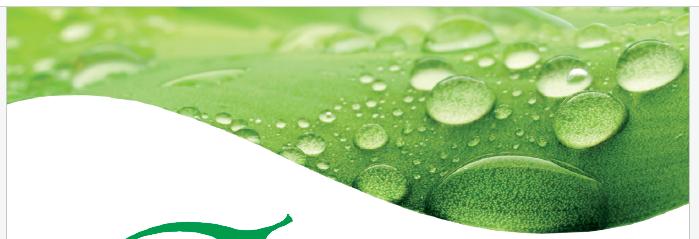


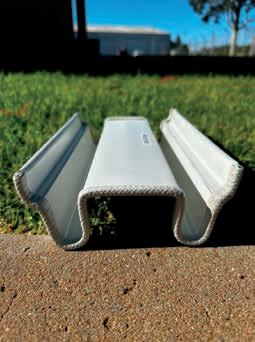







Steel Gutter Irrigation Fertigation Substrates Water Treatment Climate Control Trellising Accessories Australia-wide Sales, Service & Spare Parts Ph 1300 763 141 aisgreenworks.com.au
Growing Solutions
Planting at the right time after fumigation saves money
Dr Scott Mattner & Dr Dylan McFarlane, VSICA Research
• Planting runners or plugs too early into soil that still contains fumigant residues can kill or reduce the vigour and yield of strawberry plants
• Growers need an accurate and instantaneous method for measuring fumigants in soil to predict when it is safe to plant their crop
• VSICA Research has trialled a colorimetric test to measure fumigant levels in soils on 30 farms in the Yarra Valley
• Without the fumigant detection tests, growers at 55% of the trial sites would have planted into soils containing concentrations of fumigants with the potential to cause phytotoxicity in their crops
Summary
The Victorian Strawberry Industry Development Committee (VSIDC) have funded research by VSICA Research to develop tests for measuring fumigants in soil so that growers know when it is safe to plant their crops. Researchers field-tested colorimetric tubes that instantaneously detect fumigants in soil. Results showed a strong relationship where the greater the concentration of fumigants still in the soil at planting, the lower the strawberry fruit yield and revenue over the season. Planting into soil that contained low concentrations of fumigant residues in autumn/winter affected strawberry yields and revenue more than when planting in summer. Results showed there were only slight differences in the susceptibility of different strawberry varieties or planting material to the presence of low concentrations of fumigant residues at planting. The use of the colorimetric method has already prevented growers from planting into soil containing fumigant residues at over 30 sites across Victoria. The VSIDC and VSICA Research will work together to commercialise the test for growers.
Soil Fumigation and Crop Phytotoxicity
Soil fumigation is an effective practice used by many strawberry growers to control weeds and pathogens that cause disease, like charcoal rot and crown rot. In addition, fumigation causes an ‘increased growth response’ in strawberry crops that stimulates fruit yields by up to 30%, even when there are few weeds or pathogens in the soil. This response is due to the short-lived changes in soil biology and chemistry caused by fumigation that favour plant growth.
One of the challenges for growers with soil fumigation is knowing when they can safely plant after treatment. Planting runners or plugs too early into soil that still contains fumigant residues can kill or reduce the vigour and yield of strawberry plants (this condition is called fumigant phytotoxicity). Common non-lethal symptoms of fumigant phytotoxicity in strawberry are red margins and yellowing on the emerging leaves of plants, plant stunting (Figure 1), and new roots emerging from the crown of the plant above the soil level.
87 STRAWBERRIES
Part of the difficulty for growers is that fumigant labels usually indicate variable plant-back periods (the time between fumigation and planting) for strawberry, ranging from 7 days to longer than 35 days. This is because there are so many factors that influence how long fumigant residues remain in soil after treatment, including fumigant type and formulation, application rate, soil temperature and moisture, organic matter, clay content and others.
Compounding this, nearly all strawberry growers in Victoria that fumigate soils recently transitioned from the use of mulch made from traditional plastic (low density polyethylene, LDPE) to totally impermeable films (TIFs). LDPE mulches do not retain fumigant gases in the soil very well, whereas TIFs are impermeable and seal them in the soil for long periods. The adoption of TIF dramatically increased the control of soil-borne diseases, like charcoal rot, and minimised the emissions of gaseous fumigants to the atmosphere. However, the longer residual times of fumigants under TIF may have contributed to incidences of phytotoxicity in strawberry in Victoria because growers are unsure of how long to increase their plant-back times (Figure 1).
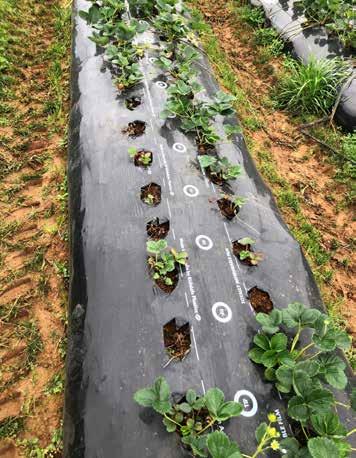
Shortfalls with traditional tests for predicting when it is safe to plant after fumigation
Most fumigant labels recommend that growers conduct a seed germination test before planting their crop to determine if there are phytotoxic levels of fumigants in the soil.
There are several versions of the test, but a common one involves collecting a small sample of treated soil in a gas-tight jar and then germinating lettuce or cress seed on the soil in the jar.
These seed species are chosen because they are highly susceptible to fumigant residues. A jar containing a similar soil that is not fumigated should be included in the test as a control.
The concept is that if the seeds in the treated soil germinate at the same rate as those in the control, then fumigant residues in the soil should be below phytotoxic levels, and it is safe to plant your crop (Figure 2).
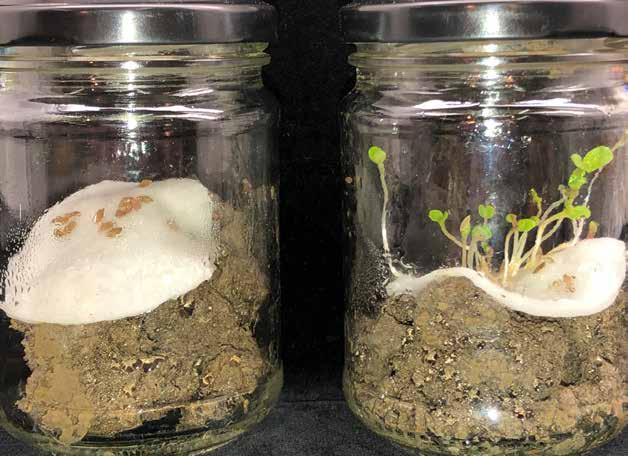 Figure 1. Stunting of strawberry plants in the field caused by fumigant phytotoxicity
Photo credit: VSICA Research
Figure 2. Set up of a seed germination test to predict when it is safe to plant after fumigation. Left jar contains fumigated soil and has suppressed the germination of lettuce, right jar contains untreated ‘control’ soil.
Figure 1. Stunting of strawberry plants in the field caused by fumigant phytotoxicity
Photo credit: VSICA Research
Figure 2. Set up of a seed germination test to predict when it is safe to plant after fumigation. Left jar contains fumigated soil and has suppressed the germination of lettuce, right jar contains untreated ‘control’ soil.
88 BERRY AUSTRALIAN JOURNAL WINTER 2024 EDITION 19
Photo credit VSICA Research
Although the method is simple, the test takes 2-7 days to complete to allow adequate time for seed germination and growth. Also, our research showed there are several variables that can influence the results of the test, including:
• How much soil is placed in the jar relative to its volume (too little soil and fumigant residues may be too low to affect germination; too much soil can cause anaerobic conditions in the jar and lower seed germination)
• The volume of water added to the jar to germinate seeds (too much water can cause anaerobic conditions in the jar and lower seed germination; too little can slow germination)
• When you measure germination (early germination is more sensitive to fumigant residues than later germination, Table 1)
We conducted a replicated field experiment in the Yarra Valley, Victoria in autumn where we fumigated strawberry beds with 1,3-dichloropropene / chloropicrin (1,3-D/Pic, 20:80) at 40 g/m2 under TIF film. We planted strawberry plugs (var. Albion) into the soil at regular intervals, starting at two weeks after treatment.
We conducted lettuce germination tests and measured the concentration of fumigants in the soil each time we planted the strawberry crop. The results from the seed germination test varied according to the parameter we used to measure lettuce growth (Table 1). For example, measuring the height of the germinated seedlings after 7 days, was much more sensitive to presence of fumigant residues in soil than seed germination. We found that another important symptom in lettuce seedlings that predicted phytotoxicity was burnt root tips, which can be seen by using a hand lens.
Starting from October, we picked fruit from the experiment 2-3 times per week through the season and calculated revenue using weekly wholesale prices from the Melbourne market (FreshLogic, Hawthorne). Unexpectedly, using the seed germination test to predict when it was safe to plant the strawberry crop resulted in a reduction in fruit yield of up to 30%, and loss in revenue of up to $1.66 per plant, depending on the parameter of lettuce growth we measured (Table 1).
Overall, our experiment showed that conducting and interpreting seed germination tests can be difficult and unreliable, and that getting it wrong can cause significant economic losses. Instead, growers need an accurate and instantaneous method for measuring fumigants in soil to predict when it is safe to plant their crop.
Table 1. The impact of using seed germination tests to predict when it is safe to plant after fumigation with 1,3-dichloropropene/chloropicrin on strawberry yield and revenue (var. Albion). Different parameters of seedling growth measured in the germination test predicted different safe threshold concentrations of 1,3-dichloropropene for planting. These results highlight the difficulty in interpreting seed germination tests for predicting when it is safe to plant after fumigation.
Parameter of lettuce growth measured in the germination test
Concentration (µg/ml) of 1,3-D in soil when germination test and parameter predicted it was safe to plant
Yield loss (%) of strawberry fruit when planted at the 1,3-D concentration predicted by the germination test
Revenue loss ($/plant) from strawberry fruit when planted at the 1,3-D concentration predicted by the germination test
Germination (7 days) 10 29.8 1.66 Germination (2 days) 7 15.1 0.85 Incidence (%) of roots with burnt tips (2 days) 5 8.8 0.49 Average height of 10 seedlings (7 days) 1 1.2 0.07 89
Real-time method for predicting when it is safe to plant strawberries after fumigation
We tested colorimetric tubes as a method for detecting fumigant residues in soil in the field. The tubes contain reagents bound on a particulate matrix that react with target fumigant gases to produce a colour change, proportional to the concentration in the sample (Figure 3). In the method we attached the tubes to a brass probe inserted into the soil and drew set volumes of soil air through the tubes. The method gave a concentration reading within 30 seconds and was highly specific to the fumigant being measured. There are different types of colorimetric tubes for different fumigants, including 1,3-dichloropropene (1,3-D), chloropicrin (Pic), methyl iodide, methyl isothiocyanate, and others.
It is important to note that all fumigants have the potential to cause phytotoxicity in strawberry crops if residual concentrations are too high at planting.
In the laboratory, we found that the concentration of fumigants measured in soil with the colorimetric tubes was highly correlated (r > 0.95) with those determined by sensitive laboratory methods (gas chromatography/ mass spectrometry).
We conducted two experiments in the Yarra Valley, Victoria to test the usefulness of the tubes for fumigant detection in the field. One experiment was set up in autumn with different varieties of freshly dug runners or plug plants (var. Albion, Cabrillo, Monterey), and the other was conducted in summer with different varieties of cold-stored (frigo) runners or plugs (var. Tamara, Albion, Cabrillo, Monterey).
Starting from 2 weeks after treatment with 1,3-D/Pic under TIF, we planted strawberries into plots at regular intervals and measured the concentration of fumigants in the soil using the colorimetric tubes at each planting. We had three replicates of each treatment and measured fruit yield and revenue through the season.
Results showed that strawberry yield declined as the concentration of fumigant in soil at planting increased (e.g., Figure 4). We modelled the data using logistic functions for each variety and planting material, which fitted the raw data well (r2 = 0.84 to 0.91). Using this data, we developed risk profiles for yield and revenue loss for planting into soil containing different concentrations of fumigants (e.g., Figure 5). Soils where no fumigant residues were detected represented the lowest risk for developing symptoms of phytotoxicity. However, results also showed that some varieties were slightly more tolerant of low concentrations of fumigant residues than others (e.g., Cabrillo was more tolerant of small concentrations of 1,3-D in the soil than Monterey). Also, transplants were more susceptible to phytotoxicity from low concentrations of fumigants in the soil when planted in autumn under cooler temperatures and higher soil moistures, than when planted in summer.

3.
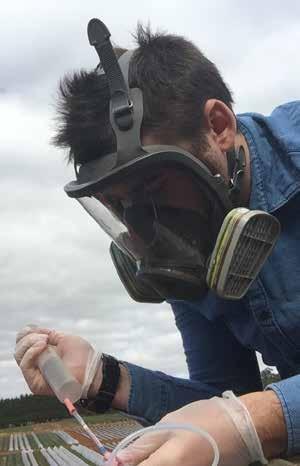
that change colour proportional to the amount of fumigant in the soil. (L) tubes for the fumigant 1,3-dichloropropene change from yellow to pink and (R) measuring fumigant residues in soil before planting using colorimetric tubes. Photo credit VSICA Research
90 BERRY AUSTRALIAN JOURNAL WINTER 2024 EDITION 19
Figure
Colorimetric tubes contain reagents
Monterey Fruit Yield
Figure 4. Yield response of strawberry (var. Monterey) to the presence of different concentrations of the fumigant 1,3-dichloropropene in soil at planting, in a field experiment conducted in the Yarra Valley, Victoria. Concentrations of 1,3-dichloropropene were measured using an in-field colorimetric method.
Monterey Revenue Loss
Loss of revenue from fruit ($/plant)
Risk of loss in fruit yield
1,3-D
Undetectable
Very low (0-5% loss)
Low (5-10% loss)
Moderate (10-20% loss)
High (20-50% loss)
Extreme (>50% loss)
Figure 5. Modelled loss in revenue from strawberry fruit (var. Monterey) and associated yield loss when planting into soil containing different concentrations of the fumigant 1,3-dichloropropene. The model is based on data from a field experiment conducted in the Yarra Valley, Victoria and using an in-field colorimetric method for measuring fumigant residues in soil.
planting
1,3-D in soil air at
(µg/ml)
400 0 800 600 200 2 6 10 14 4 8 12 16 Marketable Fruit Yield (g/plant) r2 = 0.87 Actual Yield Modelled Yield
0 2 4 3 1 2 6 10 14 4 8 12 16
in soil air at planting (µg/ml)
0 91
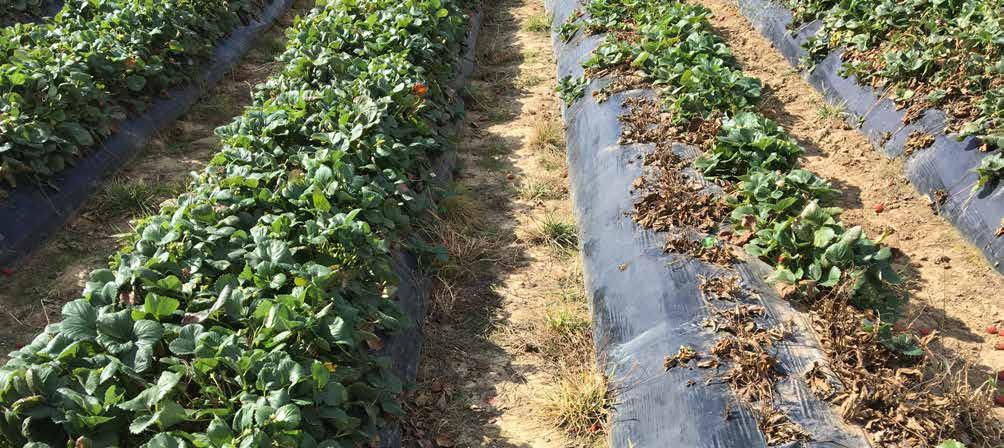
How will this project help strawberry growers?
We have already used the colorimetric tubes to measure the concentration of fumigant residues of 1,3-D and Pic in soil prior to planting at 30 strawberry farms across Victoria. We commenced the tests after the minimum plant-back period listed on the product labels. The sites were chosen to cover different growing regions, soil types, moisture and organic matter contents, and temperatures for strawberry production across Victoria.
Without the fumigant detection tests, growers at 55% of the sites we tested would have planted into soils containing concentrations of fumigants with the potential to cause phytotoxicity in their crops. Most of the growers at these sites decided to delay planting a further week based on the test and this resulted in no plant deaths.
Acknowledgements
At one of the sites, however, the grower decided to plant into soils where fumigant residues were detected and determined to be a moderate risk of phytotoxicity. A few months after planting the grower noticed signs of phytotoxicity (wilting and black roots followed by plant death) on 20% of their plants at the site. These results demonstrate the potential benefit of the test to growers.
Currently we are conducting further experiments with the use of the colorimetric tubes to understand the influence of soil type, and moisture on fumigant phytotoxicity with a greater range of fumigants. Ultimately, the VSIDC and VSICA Research plan to work together to commercialise the test for growers.
We acknowledge funds from the VSIDC, VSICA Research, and R&D Tax incentive for this research. We also thank the strawberry fruit growers in Victoria for their time, providing access to their farms and assisting us with trials.
Note: A list of registered products and permits for strawberry runner and fruit production are available on the Australian Pesticides and Veterinary Medicines Authority website (www.apvma.com.au). The product label is the official authority and should always be followed in relation to the use of a chemical.

 Figure 6. The adoption of TIF mulch used in conjunction with fumigants (L) has already drastically increased control of some soil-borne diseases compared with standard LDPE mulch (R) in the strawberry industry in Victoria.
Figure 6. The adoption of TIF mulch used in conjunction with fumigants (L) has already drastically increased control of some soil-borne diseases compared with standard LDPE mulch (R) in the strawberry industry in Victoria.
92 BERRY AUSTRALIAN JOURNAL WINTER 2024 EDITION 19
Photo credit VSICA Research
Discover unparalleled pre-grading technology for machine-harvested fresh blueberries with TOMRA Neon.
Experience smart pre-grading with the TOMRA Neon. It’s durable, easy to clean, and compact, making it a perfect fit for any existing blueberry processing line. The TOMRA Neon removes over 95% of clusters and over 90% of green and red berries, improving your optical grader efficiency. Bypass manual sorting and let the TOMRA Neon handle your machine-harvested blueberries for the fresh market.
Removes over 95% of clusters
Removes over 90% of red and green berries
Removes unwanted and undersized berries
Boosts your optical grader efficiency
Enhance your blueberry operations by talking to a TOMRA Neon expert today. Get started at tomra.com/neon

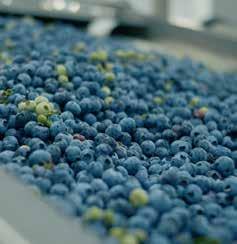


Operating expenses are on the rise, and every efficiency and cost-cutting advancement has a significant impact. Let the TOMRA Neon enhance your blueberry operations, by making sure Every Resource CountsTM
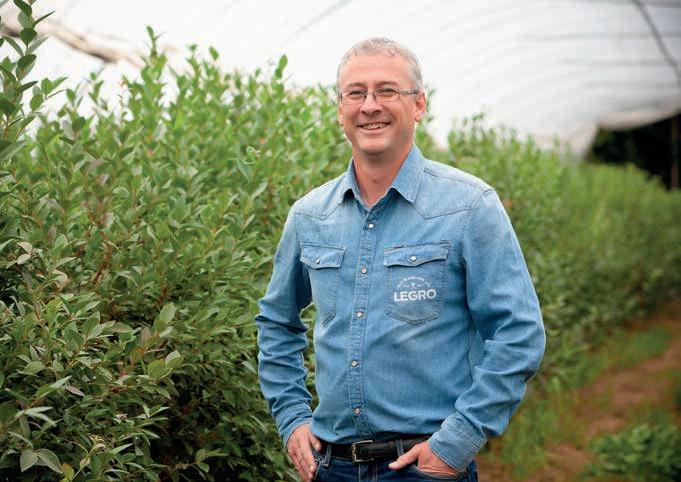
We believe it is important to really listen to our customers. We want to create the right longterm growth for both the customer and its crops. At Legro, we like to do it together. Want to know more about our substrates? Feel free to contact me or one of my colleagues.
Phil Badgery
Sales Manager Australia & New Zealand +61 (0) 3 95555267 info.aus@legrogroup.com
www.legrogroup.com your blend for life
Blueberry Growers Field Day, Tasmania
Mark Salter, Berry Industry Development Officer, Fruit Growers Tasmania
Fruit Growers Tasmania and Berries Australia held a Blueberry growers field day on the 18 April. Over 30 blueberry growers and industry participants attended the event held at Griggs Bros Farm at Castle Forbes Bay in southern Tasmania.
The morning session included four technical presentations followed by an orchard walk in the afternoon. Speakers included Stuart Doyle from AgVista, Kara Barry from the Tasmanian Institute of Agriculture (TIA), Kate Dickinson from Fruit Growers Tasmania and Gaius Leong who travelled to Tasmania from New South Wales to speak at the event and visit growers. Gaius is the Berry Industry Development Officer from New South Wales Department of Primary Industries (NSW DPI) specialising in blueberries and is based in Coffs Harbour. Stuart Doyle was first up with his presentation on blueberry pests and diseases. Stuart has a wealth of experience in blueberry pests and regularly travels interstate and internationally consulting to blueberry growers around the globe.
Stuart covered some of the most important pests for blueberries, including Lepidopteran pests, a group of pests that includes light brown apple moth, loopers, cluster caterpillar, cotton budworm and helicoverpa pests.
Stuart also covered some other pests including aphids, mirids, mealy bugs and thrips and provided information on how to identify them and the damage they can cause. Stuart explained that due to the limited amount of chemicals growers have access to, it is vitally important to use each registered chemical sparingly and be particularly careful not to overuse chemicals in the same chemical group as this will lead to resistance issues. Stuart finished up by detailing some of the serious pests he is seeing overseas, including Spotted Wing Drosophila which is hopefully a pest we won’t see here in Australia anytime soon.
You can read more about Spotted Wing Drosophila in previous articles from this journal which can all be found on the website Resource Library at berries.net.au/ resource-library by entering ‘drosophila’ into the Search box
As well as reinforcing the importance of rotating the use of registered chemicals from the same chemical group, Stuart also recommended that growers adopt an Integrated Pest Management (IPM) program to help control pests. He explained the importance of an effective scouting program to identify which pests are present in your crop and if pest thresholds are exceeded, intervention may be needed. In some cases, it might be necessary to apply a broad-spectrum insecticide to control a particular pest, but this may also impact beneficial insects, resulting in the need to reintroduce beneficial species.
Gaius Leong from NSW DPI presented next on nutrition for blueberries with his presentation focusing on common nutritional limitations experienced in blueberry production. He started off with soil pH and explained that the ideal range for blueberries is mildly acidic at pH 5.0 to 5.8 (H2O) and 4.5 – 5.0 (CaCl2). He explained that even though blueberry plants can tolerate lower pH situations there are fewer nutritional issues at this higher range. He also explained that calcium does not increase pH but the carbonate component of lime does (e.g. gypsum, calcium nitrate). He recommended using finer particle size lime for soils
94 94
BERRY AUSTRALIAN JOURNAL WINTER 2024 EDITION 19
BLUEBERRIES

with cation exchange capacity (CEC) >6 and ‘larger’ particles for soil CEC <6 and to preferably apply soil amendments post-harvest.
Gaius also highlighted the importance of the major elements, particularly Nitrogen. The amounts applied each year are dependent on crop load, pruning, soil supply and fertiliser efficiency. North American studies vary and indicate levels of between 73-186 kg N/ha, with some studies going as low as 30-40 kg N/ha to as high as 250 kg/N/ha, but 121 kg N/ha could be used as a guideline. He touched on the other major elements and their importance.
Gaius also covered salinity, compaction, and moisture infiltration. He explained high salinity can cause root burn, increase associated pathogens and can also affect moisture uptake and fruit size. Some recommendations to assist with mound compaction include to:
• maintain calcium and organic matter content;
• avoid massive fluctuations in soil moisture content; and
• use soil wetters and/or liquid gypsum to assist with infiltration especially after a ‘dry period’.
Kara Barry from TIA presented to growers with an update on the Blueberry Rust project her team is working on. The project is entitled “New on-farm strategies for the prevention and control of blueberry rust in Tasmania” and has several aspects to it including:
• Determine the temperature range of pathogen survival – particularly over winter
• Collect fine scale weather data from collaborating blueberry orchards
• Characterise blueberry foliage cycle and develop a growing degree days (GDD) model to predict leaf emergence
• Trial products which can result in complete defoliation of blueberry, with no or minimal consequence for yield and quality
The aim of this work is to better understand pathogen survival, infection risk timing, and also break the disease cycle in varieties that retain leaves over winter.
Kara shared the results of the latest defoliation trials that the research team have been conducting at Griggs Bros orchard with the semi-deciduous ‘Legacy’ variety.
95
Gaius Leong, NSW DPI presenting about blueberry nutritional needs. Photo credit: Fruit Growers Tasmania

The treatments being investigated include:
• Copper sulphate – Using high rates, trials have shown good defoliation results but negative impact on fruit buds resulting in poor yields the following season
• Ethephon – defoliation was not consistently achieved in preliminary trials
• Urea and Copper - trials have shown good defoliation results but negative impact on fruit buds resulting in poor yields the following season
• Protone – Preliminary trials have shown the most promise as less impact on yield has been detected. Timing of the application is temperature sensitive and new trials are testing a range of autumn application dates
The project concludes in 2026 and regular updates will be provided in this journal.
Kate Dickinson from Fruit Growers Tasmania gave an informative trade update. The presentation included an overview of national blueberry production per state, with Tasmania sitting at around 1,900 tonnes as the second largest producer, with NSW the largest producer at just over 17,300 tonnes.
Kate touched on blueberry exports and noted that there was a sharp increase in exports this year with a total of 1,088 tonnes + going to export. This equates to around 5% of the total Australian blueberry crop; an increase of 122% on the previous export season. The main exporting states are NSW with 983 tonnes followed by QLD with 50 tonnes, and Victoria with 31 tonnes.
The main export destinations were Hong Kong, Singapore, Indonesia and Thailand. Tasmania has access to a number of markets but there are still some for which an export pathway does not exist including China, Korea, Taiwan, and Vietnam.
Global demand for blueberries is increasing as a healthy snack food and Australia has good proximity to Asia with the opportunity for Tasmania being to leverage its reputation for other premium fruits. In terms of challenges, global production is also increasing dramatically, and we are a high-cost producer competing directly with other countries such as Peru and Chile. Success will be found by finding the market windows where we can profitably supply given we are unlikely to be able to reduce our cost base.
96 BERRY AUSTRALIAN JOURNAL WINTER 2024 EDITION 19
Kara Barry, TIA presenting an update from the Blueberry Rust project currently underway. Photo credit: Fruit Growers Tasmania

Kate also updated growers on the recent local blueberry promotional campaign which Fruit Growers Tasmania produced to help lift local sales during the postChristmas period.
The campaign featured grower stories and a video to help consumers feel a connection to the product. It was supported by IGA and Hill St Grocer in over 70 stores. The campaign rolled out using the ‘Tasmanian Grown’ Facebook page (@tasmaniangrown.au) which had over 8300 views and 1739 post engagement comments.
It was well supported by both the retail sector and the news media with three stories featured in the Mercury, Examiner and Pulse Tasmania newspapers.
The campaign was a great success with fruit sales holding up well during the post-Christmas period. The campaign also resulted in the IGA group of stores wanting to run it again next year.
The lunch break at midday provided a great opportunity for growers to network and mingle. After lunch everyone proceeded to the field to view the Blueberry Rust defoliation trials which Kara and her team have been conducting at Griggs Bros.
The group viewed various defoliation trials, including hand defoliation, applications of copper sulphate and Protone® which are aiding in the defoliation of some of the semi-deciduous varieties.
While in the field growers also took the opportunity to quiz Stuart and Gaius further on pest and disease and nutrition issues.
Berries Australia and Fruit Growers Tasmania would like to thank all of the presenters with a special thanks to Stuart Griggs for hosting the event on his farm. The feedback from all those in attendance indicated the day was a great success.


97
Field day attendees viewing the various defoliation trials taking place at Griggs Bros farm as part of the TIA Blueberry Rust project. Photo credit: Fruit Growers Tasmania
Blueberry Research Open Day, Wollongbar Agricultural Institute, NSW
Melinda Simpson, New South Wales Department of Primary Industries

On 11 April 2024, NSW Department of Primary Industries (NSW DPI) opened its doors for industry to explore the blueberry research being carried out at the Wollongbar Agricultural Institute, NSW.
This research is being conducted to develop better management practices for applying fertiliser and managing nutrient run-off.
The day started with Diana Unsworth (Technical Officer Clean Coastal Catchments) giving an overview of the fertigation control room and the experimental design that is being used to conduct the research.
The main research aims to find the optimum rate of nitrogen for blueberry growth and production. The experiment itself is looking at five rates of total Nitrogen (40ppm, 60ppm, 80ppm, 100ppm and 120ppm) and has been designed as a randomised block experiment to control differences that may occur due to spatial variation (Figure 2). The variety being used is the Southern Highbush cultivar 11-11
Figure 1. The blueberry facility at Wollongbar Agriculture Institute, Wollongbar, NSW
98 BLUEBERRIES BERRY AUSTRALIAN JOURNAL WINTER 2024 EDITION 19
Photo credit: Melinda Simpson, NSW DPI

Figure 2. Blueberry experiment set up at the NSW DPI facility. There are five total nitrogen treatments 40ppm (grey), 60ppm (red), 80 ppm (black), 100ppm (green) and 120ppm (purple). Each block contains 6 plants with a total of 300 plants. The two outer (black) rows are the buffer rows which are receiving the 80ppm treatment.
Sophie Parks (Plant Physiologist) presented on the results of this experiment to date, and these indicate that the fertigation rate of 120 mg N/L is excessive and could be reduced to 100 mg N/L, without reducing plant growth. Further to this, it has been determined that a blueberry plant in a substrate system about 1.5 years after planting takes up approximately 0.5 g of N per week during summer. This information will help to develop new fertiliser guidelines for blueberries. You can read the full article from Sophie Parks on this work on PAGE 102.
In other research that the team is conducting, Sophie Parks discussed how lightly pruned and heavily pruned plants had similar nitrogen demands for a period of 12 weeks following pruning. Further, that by 9 weeks after pruning, plants in both pruning treatments had similar demands for fertigation volume as their canopies had reached similar size by that stage.
From this work, the day then moved to Mark Bayley (Mark Bayley Consulting), who talked about on-farm solutions to reduce nitrogen leaving farms. Mark has been working with the DPI to design, construct and monitor the effectiveness of bioreactors and reedbeds to remove nitrogen from irrigation run-off water.
You can read further updates about this aspect of the CCC project in previous articles from this journal which can all be found on the website Resource Library at berries. net.au/resource-library by selecting ‘Mark Bayley’ from the Document Author dropdown list
99

Some key points from Mark’s talk were that both bioreactors and reedbeds work best if you can capture and direct the irrigation water directly to bioreactors and reedbeds. You need to have a good understanding of how much water flow will be passed through the treatment system as more water will require a bigger system. Bioreactors work quicker than wetlands for removing nitrate, but a wetland may be preferable if phosphorus, ammonia and/or pesticides are an issue in addition to nitrate.
Monitoring of the bioreactor showed that once the flow rates stabilised, nitrate removal across all three bioreactors was extremely high, with removal efficiencies exceeding 95% across this time series.
The day then wrapped up with a presentation from Harriet Brickhill, Local Land Services (LLS) who spoke about the Clean Coastal Catchments grant program. Harriet highlighted how a previous grant recipient made significant nutrient savings by capturing their greenhouse cucumber drain water for re-use.
The day showcased a holistic approach to nutrient management. Starting with fertigation system design, moving to plant irrigation and nutrient requirements and finishing with treatment options for irrigation run-off water, it demonstrated how growers can make changes to all of these practices to minimise nutrient run-off to the environment.
BERRY AUSTRALIAN JOURNAL WINTER 2024 EDITION 19 100
Figure 4. Mark Bayley talking about the trial looking at nitrogen removal from irrigation run-off water by using bioreactors and reed beds. Photo credit: Meg Strang, NSW DPI
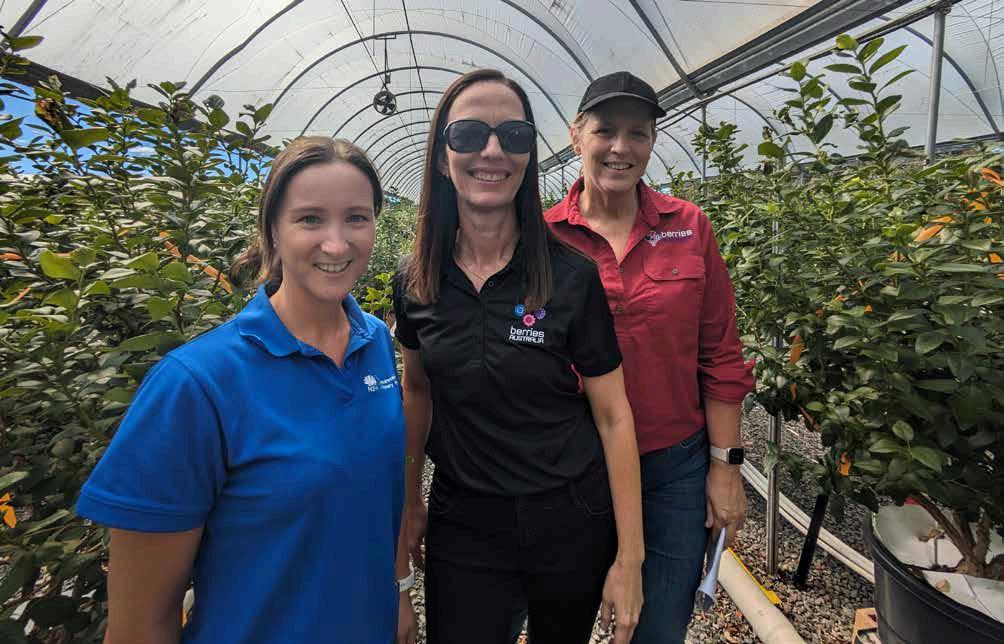
Acknowledgements
This research is part of the Clean Costal Catchments project which is being delivered by the NSW DPI and funded by the NSW Government under the Marine Estate Management Strategy.
The Clean Coastal Catchments (CCC) Research project works with growers to keep sediment and nutrients on farm and out of coastal waterways while supporting profitable and sustainable agriculture.
The CCC Research project is funded through the NSW Government’s Marine Estate Management Strategy to improve water quality for our ocean, estuaries, and coastal wetlands.
CCC are working with agricultural industries in key coastal areas to actively manage issues associated with production and land management that can damage the marine estate.
Better management of fertiliser and water on farm will assist industry to be more productive, profitable and environmentally sustainable, while reducing negative impacts on coastal creeks and rivers and sensitive marine areas.

To stay informed about the Clean Coastal Catchments (CCC) project, visit bit.ly/News-CCC or scan this QR code
101 101
Figure 5. L-R: Melinda Simpson (NSW DPI), Wendy Morris (Qld Berry IDO), Jen Rowling (Berries Australia Project Manager)
Photo credit: Wendy Morris, Berries Australia
Developing nitrogen fertiliser guidelines for blueberry: research update
Sophie Parks, Melinda Simpson & Gaius Leong, NSW DPI
• Managing the application of fertiliser to meet the nutrient needs of a crop is an efficient practice that assists in keeping nutrients on farm
• Additionally, this practice reduces the risk of excess nutrients being exported off farm affecting the water quality of creeks, rivers and the marine estate
• Currently, in northern NSW the Clean Coastal Catchments project is investigating the nitrogen (N) needs for Southern Highbush blueberry grown as an evergreen crop
• This article provides an update on the experiment being conducted at the Wollongbar Agricultural Institute (NSW Department of Primary Industries), in northern NSW, investigating the responses of a substrate blueberry crop to N supplied in fertigation
Experimental outline in brief
Fertigation treatments
Five rates of N (50% nitrate, 50% ammonium) supplied via drippers to pots in fertigation solution (14, 60, 80, 100, 120 mg /L), each made with the same concentration of total salts (electrical conductivity (EC) 0.92 dS/m) and pH of 5.7, and adjusted according to the weather conditions.
Plants and materials
Southern Highbush (Vaccinium corymbosum ‘11-11’), planted in May 2021 into 28 litre pots containing a commercial blend of coir, peat moss and perlite.
Key data collected
• Whole-plant dry weight and plant nitrogen concentration on 3 dates for all N rates (July 2022, January 2023, March 2023)
• Three plants per treatment
• Fruit production for 3 N rates (40, 60, 100 mg/L) during the 2023 season
Our findings to date
On average, whole plants (roots and shoots) contained 0.8g of N in July 2022, 3g in January 2023 and 5g in March 2023. From these results we calculated that between January and March 2023, the plants were taking up 0.5 g of N from the supplied fertigation, per week. This measured amount - 0.5g per week - is what the crop was using during summer, about 20 months after planting.
In general, the total dry weight (growth) of the plants and their N concentration was greater at the higher rates of N in fertigation, than at the lower rates. However, despite the total plant growth being greater at 100 mg N/L, compared with 40 mg N/L, their total fruit production, when we first measured it in 2023, was similar in count and total fresh weight (average of 1.4 kg per plant totalled from 12 harvests between mid-June to late October). The exception was that the average fresh weight of berries was greater for the 100 mg N/L treatment (2.41g), compared with the 40 mg N/L treatment (2.17g). Unfortunately, we were unable to take measurements of fruit production from all the treatments in 2023 but we are expanding our data collection to all 5 treatments for the current season.
102
BERRY AUSTRALIAN JOURNAL WINTER 2024 EDITION 19 102
BLUEBERRIES
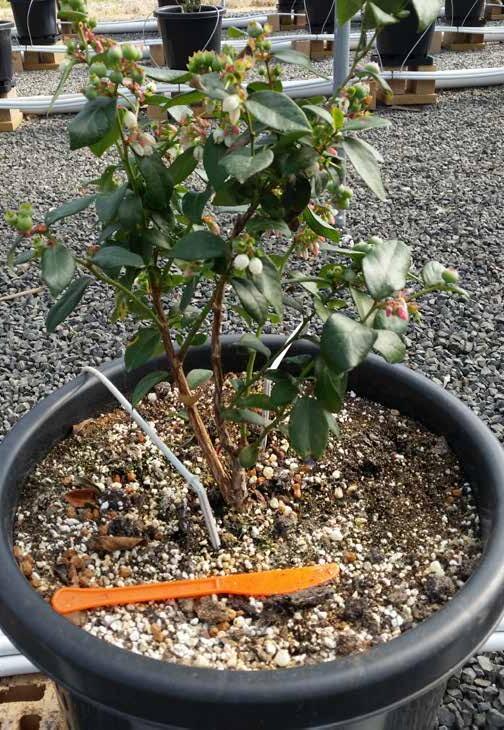
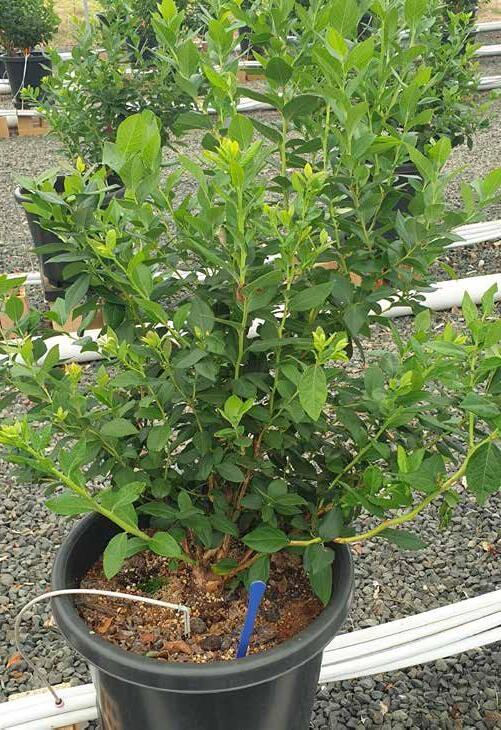
It is emerging from these data that the fertigation rate of 120 mg N/L is excessive and could be reduced to 100 mg N/L without reducing plant growth.
This is based on the finding that there was no difference in growth between these two treatments.
Again, we do not have production data for both treatments but will be looking forward to seeing if these treatments differ or not for the berry harvest this season.
Other information that we are investigating, and will be able to report on over the next year, includes:
• the role of plant canopy area and fruit number on fruit size
• the impact of pruning severity on plant demand for N
• the critical N concentrations in leaves associated with optimum growth for an establishing crop
Together, this experiment and our on-farm trials are gathering data on how N is taken up and lost from the growing system. This information will be used to develop new guidelines, such as the fertiliser N guidelines for blueberry as an establishing crop, to be released later this year.
Key Messages
• A blueberry plant in a substrate system about 1.5 years after planting takes up about 1.5g of N per week during summer
• In this study, the fertigation rate of 120 mg N/L was excessive and could be reduced to 100 mg N/L, without reducing plant growth
• The effect of fertigation N and plant N on berry production will be investigated for the 2024 season
103 103
Figure 1. A typical plant harvested in July 2022 (L) containing about a total of 0.8 grams of nitrogen and a plant prior to the harvest in January 2023 (R) containing a total of about 3 grams of nitrogen, and taking up about 0.5 grams of nitrogen per week during this time. Photo credit: NSW DPI
Dam Water Quality Workshop: How to manage algae, aquatic weed and iron issues in dams
Gaius Leong, Berry Industry Development Officer & Melinda Simpson, Horticulture Development Officer, NSW Department of Primary Industry
A workshop on dam water quality was organised on 20 March 2024 by Local Land Services (LLS), New South Wales Department of Primary Industries (NSW DPI), Berries Australia and Landcare. The workshop took place on John and Amrit Atwal’s farm in Sandy Beach, NSW where we had more than 30 growers and industry representatives attend the workshop.
Issues surrounding source water quality and potential rectifications were discussed in great depth. We also had the ‘Dam Doctor’ available to answer questions on rectifying water quality issues. In John and Amrit’s case, their dam had been taken over by Water hyacinth (Eichhornia crassipes), which is classified as an invasive weed. They had been struggling to control and remove the weed from their dam for some time, even with herbicide applications.
Weeds not only reduce the amount of dissolved oxygen (DO) in the water, but the breakdown of plant parts also leads to increased turbidity and blockages in the filter. Blocked filters are a common issue almost all growers face, which leads to poor fertigation pressure in the block, reduced distribution uniformity in fertiliser application, commonly resulting in reduced productivity and in extreme cases plant death.
The reduction of DO in irrigation water is also well documented to increase susceptibility to certain pathogens and reduce nutrient uptake efficiencies.
Due to the scale of the water hyacinth affecting the dams surface area, killing the weeds with herbicide would only increase plant decaying matter and turbidity, and would take a significant amount of time to self-rectify. Therefore, the best solution was to mechanically remove the majority of weeds before spot spraying the remaining weeds.
Poor water quality can be avoided by understanding and addressing individual issues. The following are common issues that affect water quality and ways to maintain or rectify the issues.

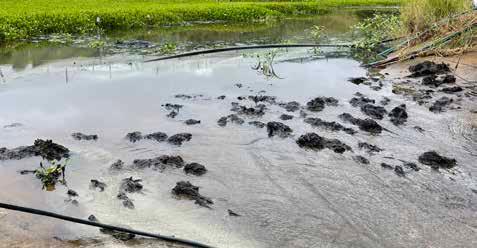 (Top) Workshop attendees viewing the dam where the dam doctor showcased some aeration technology (Bottom) Water hyacinth invasive weed has taken over a substantial surface area of the dam.
(Top) Workshop attendees viewing the dam where the dam doctor showcased some aeration technology (Bottom) Water hyacinth invasive weed has taken over a substantial surface area of the dam.
104 BLUEBERRIES BERRY AUSTRALIAN JOURNAL WINTER 2024 EDITION 19 104
Photo credits: Melinda Simpson & Gaius Leong, NSW DPI
Algae
Algae are small forms of plant life that exist in a wide range of habitats. In water sources, algae occur quite naturally in both fresh and brackish waters. Like all plant life, algae respond to sunlight and fertilisers, and when environmental conditions are right, excessive algal growth will occur.
When algae die, their decomposition depletes the oxygen levels in the water source. If too much oxygen is lost, further water quality problems can arise, including the release of iron and nutrient from sediments.
As little as 0.01 mg/L phosphate in freshwater sources stimulates the growth of algae and other aquatic life that may clog irrigation systems

How to PREVENT algal blooms in water sources
The best way to manage algal blooms is to prevent them from happening. A key long-term strategy is to improve nutrient management and erosion control on your farm.
Nutrient management
Algal blooms are often fuelled by excessive nutrient levels, particularly phosphorus and nitrogen.
Implementing best management practices to reduce nutrient inputs into the dam can help prevent algal growth.
Vegetative buffer zones
Establishing vegetative buffer zones around the dam can help filter out nutrients and sediments before they reach the water.
Planting native vegetation along the shoreline can also help stabilise soil, reduce erosion, and provide habitat for wildlife, further contributing to water quality improvement.
Aerobic bacteria
Aerobic “oxygen-loving” bacteria are naturally occurring organisms and already live in your dam; their populations are just very tiny. Encourage their populations to grow and the bacteria will consume more organic material (a.k.a. sludge) and pull more nutrients from your water. Eventually, these microbes consume so much of the available nutrients that the algae starve and die.
Aerobic bacteria feed on the organic material in sludge (e.g. dead leaves, aquatic weed seeds, algae spores) breaking it down, so it begins to disappear altogether
Figure 2. Algae on dam. Photo credit: Canva
105 105
How to TREAT algal blooms in water sources
Aeration
Aeration systems can help increase oxygen levels in the dam, which can inhibit algal growth and promote the growth of beneficial aerobic organisms. Surface aerators, diffused aeration systems, or fountain aerators can be installed to enhance oxygenation and circulation in the water.
Probiotic treatments
A probiotic treatment (like Biostim®, REGEN-Sediment® or Bioenzymes Pond Maintain®) involves actively feeding the “good” microbes in your dam. This encourages populations of aerobic bacteria to grow. They eat the sludge on the floor of your dam and consume nutrients like nitrogen and phosphorus, thus outcompeting algae.
Floating islands
Floating islands are made up of buoyant mats which are planted with vegetation. The islands help with nutrient reduction much the same way as aeration and biological treatments. The key is the large, exposed root mass of the plants, which draw phosphorous directly from the water and provide habitat for bacterial populations that consume nitrogen.
Algaecides and peroxide based treatments
Algaecides work by releasing chemicals that attack algae cells and break them down preventing reproduction and spread. There are many products available, with some of the most common commercially available products in Australia being COPTROL®, Cupricide®, Kuparimine® and REGEN-Algaemaster®. (Please note: other products may be available and effective, these are provided as they are commonly used options).
It is important to note that algaecides do not clean up the algae once it’s dead. This dead material eventually decays, adding more nutrients to your dam that can feed future algal blooms. Therefore, it should be used in conjunction with a probiotic treatment that will help to break down the dead algae before it adds additional nutrients to the water.
Peroxide based treatments like AlgaeLift® helps lift algae off surfaces and makes it easier for naturally occurring bacteria to degrade it. AlgaLift® is best used with in combination with probiotic treatments and aeration.

106 BERRY AUSTRALIAN JOURNAL WINTER 2024 EDITION 19 106
Figure 3. Aeration system installed in a dam at a berry farm. Photo credit: Melinda Simpson NSW DPI

Aquatic weeds
Aquatic weeds are plants that invade watercourses, dams and wetlands. These weeds are extremely detrimental to the aquatic environment, where they choke waterways, alter oxygen levels and reduce light penetration.
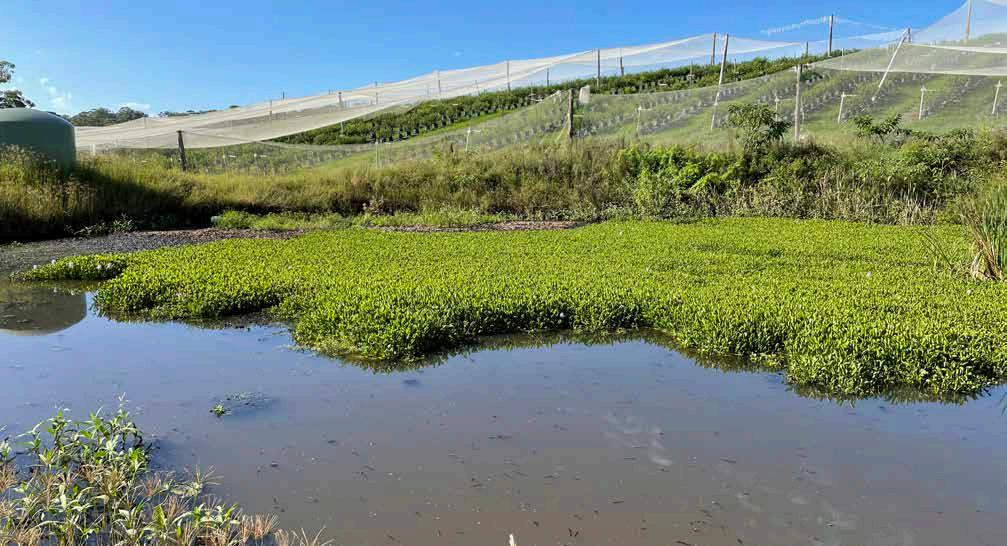 Figure 5. Water hyacinth on a dam in Woolgoolga, NSW. Photo credit: Melinda Simpson NSW DPI
Figure 5. Water hyacinth on a dam in Woolgoolga, NSW. Photo credit: Melinda Simpson NSW DPI
107 107
Figure 4. What a floating island can achieve in a dam
Some water weeds need to be reported. Report suspicious weeds to the local council weeds officer.
How to treat or prevent aquatic weeds
Aeration
Aeration systems can help increase oxygen levels in the dam, which can inhibit aquatic weed growth and promote the growth of beneficial aerobic organisms. Surface aerators, diffused aeration systems, or fountain aerators can be installed to enhance oxygenation and circulation in the water.
Probiotic treatments
A probiotic treatment (like Biostim® or REGEN-Sediment®) involves actively feeding the “good” microbes in your dam. This encourages populations of aerobic bacteria to grow. They eat the sludge on the floor of your dam and consume nutrients like nitrogen and phosphorus, thus outcompeting aquatic weeds.
Mechanical removal
Mechanical removal involves the removal of the plant biomass from the water body using specially designed harvesters or equipment. The benefit of mechanical removal is that there is less plant material to break down and provide nutrients for aquatic weed growth furthermore the water can be used straight away compared to restricted use following herbicide use.
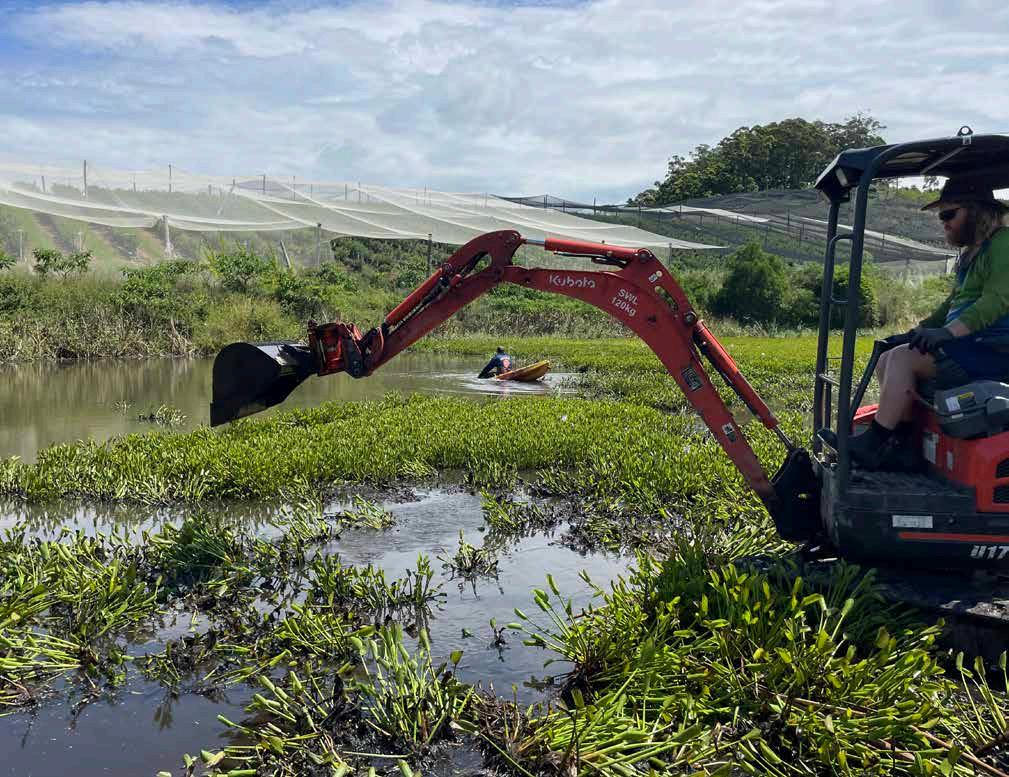 Figure 6. Mechanical removal of aquatic weeds using an excavator. Photo credit: Melinda Simpson, NSW DPI
Figure 6. Mechanical removal of aquatic weeds using an excavator. Photo credit: Melinda Simpson, NSW DPI
108 BERRY AUSTRALIAN JOURNAL WINTER 2024 EDITION 19 108
Herbicide
Killing weeds and leaving them in the dam is likely to release a lot of nutrients and make the water less attractive therefore using herbicides is generally a last resort and should only be used in extreme cases or only for spot spraying.
Not all herbicides can be used on aquatic weeds. Check labels before applying in aquatic areas. If using the water source for irrigation, ensure the product chosen and its use will not affect the crop you are irrigating.
There are specially designed herbicides for aquatic environments and therefore you should always read the label
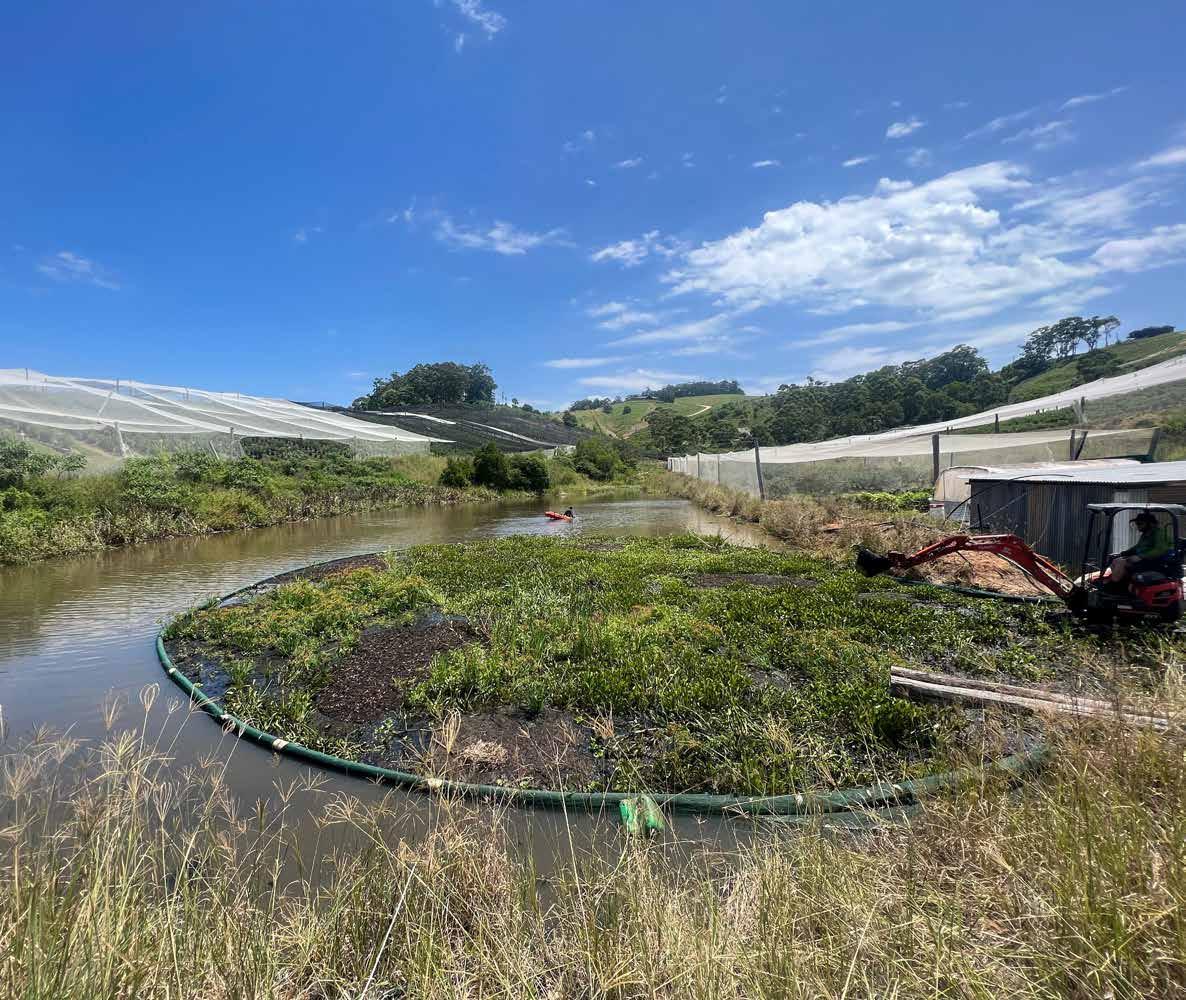
109 109
Figure 7. A net is used to clean up the remaining floating weed after the excavation has finished Photo credit: Melinda Simpson, NSW DPI

Irrigation systems used for fertigation should not use water high in iron. Injecting unchelated phosphates or calcium salts into the water will accelerate the precipitation of iron and should be avoided.
Table 1. Aquatic herbicides and their uses
Diquat as diquat
Dibromide
Diquat as diquat
Dibromide and wetting agent
Glyphosate
AQ200 Aquatic Herbicide ® Submerged aquatic weeds Spray diluted evenly across the water’s surface
AQ200 Aquatic Herbicide ® and wetting agent Free floating aquatic weeds
Spray diluted product and wetting agent mix directly onto aquatic weeds
Roundup Biactive® Aquatic weeds Avoid spraying across moving bodies of water, or where weeds do not exist
Example products Targeted aquatic weeds
Active
Comments
110 BERRY AUSTRALIAN JOURNAL WINTER 2024 EDITION 19 110
Figure 8. Iron sludge in pipe. Photo credit: Canva
How to reduce iron in water sources
Iron is soluble in water where there is little or no oxygen. Oxidising the iron makes it form solid particles that can then settle out of solution or be caught in a filter. The recommended treatment to remove iron is oxidation, sedimentation and then filtration.
Aeration and settling
Aeration and settling is an inexpensive method of iron removal. Aeration can be done by either spraying the water into the air, bleeding air into the intake side of a pump, agitating the water with propellers or paddles or cascading it over baffles into a settling tank.
The iron then settles out of the aerated water. As iron is more soluble at lower pH values, the best precipitation is likely to occur at a pH of 7.2. You can add hydrated lime, that is, calcium hydroxide Ca(OH)2, to raise the pH values.
In dams, problems caused by iron can often be reduced or eliminated by attaching the suction pipe of the pump to a raft or drum to bring it within 20 to 30cm of the surface.
You can read about a simple chlorine dosing system used to manage bacterial iron in bore water on the website Resource Library at berries.net.au/resource-library by typing ‘chlorine’ into the Search box.
Oxidation
Iron in water is often present in a soluble, ferrous (Fe2+) form. Oxidising agents such as chlorine, potassium permanganate, or hydrogen peroxide can convert soluble ferrous iron into insoluble ferric (Fe3+) iron, which can then be removed by filtration.
Chlorination can be used to control iron deposits if pH is below 6.5 and the iron concentration is less than 3.5 mg/L (3.5 ppm). If pH is above 6.5, the iron concentration must be below 1.5 mg/L (1.5 ppm) to use chlorination effectively. Chlorine also kills iron bacteria on contact.
Potassium permanganate is often used with manganese greensand, which acts as a filter, trapping the oxide. The main advantage of potassium permanganate oxidation is the high rate of reaction, which is many times faster than that of chlorine. The reaction is not sensitive to pH within the range of 5 to 9.
References and more information
NSW DPI 2014, Farm water quality and treatment, Agriculture NSW Water Unit
https://www.dpi.nsw.gov.au/__data/assets/pdf_ file/0013/164101/Farm-water-quality-and-treatment.pdf
The Dam Doctor
https://thedamdoctor.com.au
Water quality solutions
https://waterqualitysolutions.com.au
Love my dam
https://lovemydam.com.au
Acknowledgements
The on-farm work was completed under the Hort360 program for a sustainable and resilient berry industry as part of the storm and flood recovery project funded by the NSW State and Federal government.
We wish to thank Melinda Simpson (DPI) for being the co-organiser for the workshop and creating the guide on how to manage algae, aquatic weed and iron issues in dams, and Harriet Brickhill (LLS) and Melanie Craig (Landcare) for co-organising the workshop.


111 111
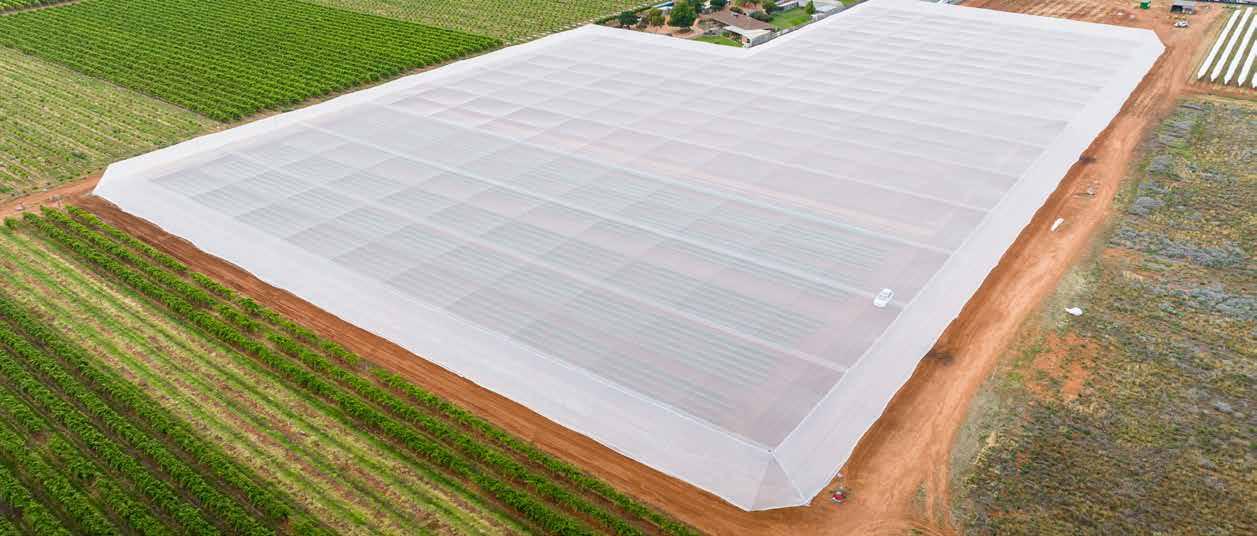


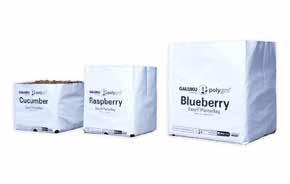


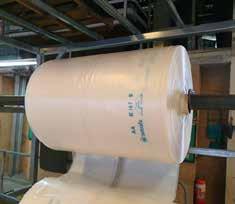


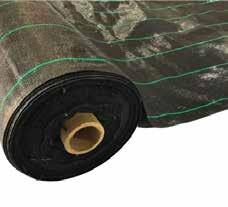
GreenlifeGRO
GreenlifeGRO is here for you. As a provider of horticultural products and services, we understand the importance of delivering exceptional customer service. Our team is not only knowledgeable in our products and services but also in the industry best practices. From selecting the right materials to the installation process, we are dedicated to providing personalised support every step of the way to provide quality service and products that help you grow and succeed.
GreenlifeGRO, part of the Australian privately owned Tapex Group is steeped in innovation and strong values. The groups' vision is straightforward – by investing in the best technology designs and product solutions, combining people with industry experience, and total commitment to service excellence to deliver the right outcomes for our customers.
We have been providing protective cropping solutions since the late 1980s through the building of Horticulture structures and product solutions across Australia.







Netting Structure Design and Construction 2023, Victoria Kingsgrove, Sydney +61 2 9502 6000 sales@greenlifegro.com.au 200 Kingsgrove Road, Kingsgrove NSW 2208 Australia Ballina, NSW +61 2 6686 7321 sales@greenlifegro.com.au 19 Cessna Crescent, Ballina NSW 2478 Australia CONTACT US www.greenlifegro.com.au LET’S CONNECT
Tunnel, Bird proofing installation services and product providers, 2023 - Queensland Greenhouse construction and internal rolling bench supply and construction services
GreenlifeGRO is an Australian Stockist and Distributor for Galuku Coir products
Quality tunnel parts and accessories stockist and provider Spanish Greenhouse / Tunnel film stockist provider (full rolls and cut to length) National Greenhouse and Netting Structure installation services Greenhouse parts and accessories stockist and supplier High Quality Weedmat stockist and supplier 01 Commercial Greenhouses 02 Netting and Shade Structures 03 Netting and Fabric Products 04 Greenhouse Films 05 Coir Products 06 Twine 07 Weed Mat 08 Rope 09 Greenhouse, Netting, and Tunnel Accessories PROTECTED CROPPING PRODUCTS BOOK NOW
GreenlifeGRO is an Australian Stockist and Distributor for Galuku Coir products






















Have you checked out the new Resource Library available at berries.net.au Visit and bookmark: berries.net.au/resource-library KEY MESSAGES Plastic mulch is commonly used for Australian crops such as tomatoes, capsicums, zucchinis, strawberries and in nursery production to retain moisture, suppress weeds and retain fumigation in the soil. Plastic mulch is an environmental issue as there is no viable or sustainable disposal and it is usually highly contaminated with plant matter and soil. Stockpiling, burying and/or burning on farm is common practice with a high risk of microplastics contamination. Certified soil biodegradable mulches (CSBM) are a potential solution which break down naturally in the soil, leaving organic material and no microplastics, and no removal or disposal costs. While the upfront cost for CSBM products can be 50% to 200% more than the cost of conventional plastic mulch, there are significant savings from disposal. It is therefore important to consider the whole-of-life cost when selecting these products. SOIL BIODEGRADABLE MULCH FILMS FACT SHEET – MARCH 2024 THE PROBLEM It is estimated that around 12,400 tonnes of conventional mulch films enter the Australian horticulture industry each year. A very small proportion is managed using best practice. Management costs for plastic mulch are significant including the labour, equipment and fuel use for removal at the end of each crop cycle, space for aggregation, transport for disposal and landfill fees. Disposal to landfill is currently the most practical option given there are often contaminants (such as soil and plant material) making the plastic mulch very challenging to recycle. As landfill is expensive, growers sometimes manage the material onsite through stockpiling, burying and/or burning. These practices expose the plastic to sun and rain resulting in fragmentation and microplastics entering the soil and water. Harmful chemicals emitted when burning conventional polyethylene plastic mulch includes soot, solid residue ash, black carbon, and toxic pollutants like dioxins and mercury. These by-products have global warming potential, for example black carbon is 5,000 times greater than CO². There is currently no method to account for this environmental burden and the associated costs. NATIONAL FARM WASTE COORDINATION SERVICES Recent food trials conducted by the Department of Agriculture and Fisheries (DAF) have centered on food neophobia, the hesitancy to try new or novel foods. Understanding consumer sentiment is crucial for the success of any product, particularly those that challenge conventional norms. One noteworthy example is the ongoing focus on white, blush, and dark red strawberries. In 2022, the consumer and sensory research (CSR) team at DAF conducted study emphasising the need to these novel strawberries to enhance product acceptance (See Sexy – future of strawberry breeding on PAGE 75 of the Winter 2022 Edition of the Berry Journal). Subsequently, the team has been actively engaged in testing new varieties, delving into their sensory attributes, and closely examining consumer opinions. The ultimate goal is to support the industry in successful product launch by gaining comprehensive understanding of consumer preferences. The trials, conducted in July and August 2023, examined Strawberry Breeding Program (ASBP) including seven standard red fruit; Scarlet Rose, Susie, Red Rhapsody, 2021-109, 2017-040 (new subtropical variety named ), and three novel; 2021-413, SB17-230 and SW20-317 (Figures and 2). Over the course of the research, the CSR team collaborated closely with the ASBP team in Nambour ensuring the seamless integration of the growing process into the trials. Fruits, meticulously selected and handpicked, underwent testing the day after harvesting, guaranteeing panellists taste of the freshest produce. The future’s bright, the future’s blush! Philippa Lyons – Senior Consumer & Sensory Scientist, Nat Ivanova Consumer & Sensory Scientist, Jodi Neal –Principal Plant Breeder, Katie O’Connor – Plant Breeder; Queensland Department of Agriculture and Fisheries This project, Genetics of Fruit Sensory Preference (AS19003), was funded by Hort Innovation as part of the Hort Frontiers strategic partnership initiative, with co-investment from Queensland Department of Agriculture and Fisheries and contributions from the Australian Government. Figure 2. Novel fruit; blush, white & dark red strawberries Photo credit: Photoelements Figure 1: Strawberries assessed (nine of 10) STRAWBERRIES BERRY Managing Rust in Blueberries INTRODUCTION Blueberry rust thrives in warm, wet conditions, especially when there are extended periods of leaf wetness. The disease is caused by the pathogen Pucciniastrum minimum formerly known as Thekopsora minima. SYMPTOMS & DISEASE PROGRESSION CULTURAL MANAGEMENT First, small pale-bright yellow lesions appear on 1 yellow pustules containing spores form on the underside of the leaf 2 As the lesions age they turn reddish brown, in size and merge together 3 Later stages of blueberry rust dark spots surrounded by yellowing on the leaf Early fruit symptoms appear as Purplish sunken lesions around the calyx which typically have yellow spores 5 Yellow pustules the calyx can be seen on ripe fruit 6 4 AZOXYSTROBIN PER89953 DAY 31.10.2024 CHLOROTHALONIL PER91300 28 DAYS 30.09.2026 DITHIANON PER82601 21 DAYS 31.12.2026 CHEMICAL MANAGEMENT Permitted products for blueberry rust control in Australia. Always read and follow permit and label directions. canopy for a reduction in leaf wetness (where possible) to encourage air flow Implement good biosecurity practices and inspect nursery plants on arrival Reduce humidity by preventing water from pooling i.e. good drainage GERMINATION INFECTION HIGH HUMIDITY HIGH RISK HIGH RISK LOW HUMIDITY LOW RISK LOW RISK INFECTION & FAVOURABLE CONDITIONS The rust fungus will only infect living plant tissues and survives primarily in infected leaves that remain on the plant after pruning. This poster has been produced as part of MT18020 Facilitating the development of the Australian berry industries funded by Hort Innovation using research and development levies from the Blueberry Fund and contributions from the Australian Government. NATIONAL FRUIT FLY COUNCIL preventfruitfly.com.au NFF RUBUS | ON-FARM FRUIT FLY MANAGEMENT FRUIT FLY SPECIES there are some which can cause significant damage to fruit and impact upon market access. Many of the top pest species are polyphagous, meaning they can use multiple hosts. Having multiple hosts means the flies are more resilient in the are other minor pest fruit fly species present, for example Mango Fruit Fly (Bactrocera frauenfedli) and Jarvis’ Fruit Fly (Bactrocera jarvisi) Likewise, there are pest fruit fly species not established in Australia that have the potential to cause LIFE CYCLE is important, as different control techniques are more effective at different stages. The developmental stages may also be extended by cooler weather. Fruit fly cause damage to fruit by laying their eggs within the host. The eggs hatch into larvae pupal stages can be completed in as little as two weeks in ideal conditions. Below is an indicative life cycle of Qfly at 26 MONITORING are increasing or decreasing. Although monitoring will not indicate the exact numbers of pest, is useful in informing control strategies are working and to highlight any specific areas needing further attention. Monitoring is also conducted lures attract different fruit fly species. Refer to fruitflyidentification.org.au for more information. Not all lure responses are the same, some lures are very attractive and can attract flies from long distances and some fly species may not be insecticide used is fast acting to ensure that the fly is caught within the trap and killed. Trap types In combination with the various lures there are several different trap types available, including Lynfield, McPhail and Biotraps to name few. Whilst each trap type has its own features, most follow a similar principle using a dispenser for an appropriate lure and fast-acting contact insecticide. such as near water courses or unmanaged hosts. The placement of individual traps is important also and should be located within the tree canopy or in sheltered positions, in shade during warm periods and in light during cooler periods. Trap Checking - Traps should be checked weekly during the active season and less frequently (fortnightly monthly) at other times. Records should be kept of the number of flies caught and the location of the trap. Information gained from monitoring activity will help to inform the frequency of control actions. This, combined with knowledge of the property, SOURCES OF INFESTATION Understanding the likely sources of infestation is vital in effectively managing fruit fly and prioritising where to act. Isolating your crop as much as possible from the sources of infestation very important. Urban gardens and backyards Urban gardens and backyards offer refuge to fruit flies by providing safe shelter and microclimate which assists over wintering. Urban areas also provide a wide range of hosts which help bridge the Alternate hosts Many significant pest species of fruit fly are polyphagous, meaning that they have more than one host. your own non-commercial fruit and vegetable plantings and amenity plants in your backyard. For example, loquats used in amenity plantings are an early alternate host which may support rapid population growth following winter. Feral trees are host fruit trees growing in unmanaged areas, often spread by birds. Whilst their potential impact is variable, they do represent risk which should be managed. Abandoned or neglected orchards potential source of flies as well as other pests and diseases. As such they need to be be acknowledged that whilst addressing the issue of abandoned orchards difficult, effort should still be made. Other pathways There are range of other pathways requiring awareness and farm and at packing sheds to name few. QFLY LIFE CYCLE 26 C 1st instar larvae 2nd instar larvae 3rd instar larvae Eggs Adult Pupae 2 days 2 days 2 days 2 days 10 days 14 days Larvae hop from fruit Flies emerge Mating and oviposition
You can now search the extensive database of resources, including all articles published in the Australian Berry Journal since it was launched in 2019, as well as factsheets, posters, case studies, research reports and links to industry resources hosted on other websites.












 Brett Fifield, Hort Innovation, Chief Executive Officer
Brett Fifield, Hort Innovation, Chief Executive Officer


 Victorian Strawberry Industry Development Committee
Victorian Strawberry Industry Development Committee

 Foundation screen house, VSICA
Photo credit: Angela Atkinson
Plug plants at Perry’s Certified Strawberry Runner Growers. Photo credit: Angela Atkinson
Foundation screen house, VSICA
Photo credit: Angela Atkinson
Plug plants at Perry’s Certified Strawberry Runner Growers. Photo credit: Angela Atkinson






 Attendees enjoyed a tour of the Costa packing shed
Photo credit: Katrina Hill, Vegetables WA
Brendon Fewster, Director of the Bee Industry Council of WA spoke to the group. Photo credit: Helen Newman
Attendees at the Blueberry Field Day on 30 April braved the weather to learn from industry expert Stuart Doyle.
Attendees enjoyed a tour of the Costa packing shed
Photo credit: Katrina Hill, Vegetables WA
Brendon Fewster, Director of the Bee Industry Council of WA spoke to the group. Photo credit: Helen Newman
Attendees at the Blueberry Field Day on 30 April braved the weather to learn from industry expert Stuart Doyle.




















 Simon Dornauf CONFERENCE COMMITTEE CHAIR
Simon Dornauf CONFERENCE COMMITTEE CHAIR












 The Berry Basket creative on the digital advertising screens across the country.
The Berry Basket creative on the digital advertising screens across the country.




 Our influencers created berry interesting uses for fresh berries from dressing up the everyday muffin to exciting brunch burrata toast and crunchy weekend salads.
Our influencers created berry interesting uses for fresh berries from dressing up the everyday muffin to exciting brunch burrata toast and crunchy weekend salads.


























 Figure 1. Plastic mulch trial at Bowen, Queensland
Figure 1. Plastic mulch trial at Bowen, Queensland



 L-R: Kevin Chapman and Murray Chapman. Photo credit: VSICA
The Sandford raspberry canes loaded with flowers and new fruit ready for the February harvest
L-R: Kevin Chapman and Murray Chapman. Photo credit: VSICA
The Sandford raspberry canes loaded with flowers and new fruit ready for the February harvest






 Richard McGruddy inspecting the blackberry canes at Queensland Berries
Photo credit: Wendy Morris
New long cane raspberry plants in tunnels at Queensland Berries
Richard McGruddy inspecting the blackberry canes at Queensland Berries
Photo credit: Wendy Morris
New long cane raspberry plants in tunnels at Queensland Berries

 Attendees at the grower dinner held at the Sandstone Point Hotel on day one of Mark’s visit
Photo credit: Wendy Morris
Jodi Neal from QDAF (L) and Dylan Bellchambers from Bitwise Agronomy (R) at the Stanthorpe dinner
Attendees at the grower dinner held at the Sandstone Point Hotel on day one of Mark’s visit
Photo credit: Wendy Morris
Jodi Neal from QDAF (L) and Dylan Bellchambers from Bitwise Agronomy (R) at the Stanthorpe dinner

 Strawberry plugs recently planted in tabletops at Pinata Farms in Wamuran
Photo credit: Wendy Morris
Mark Salter (L) and the new General Manager for Berries at Piñata Farms Johan Oosthuizen (R)
Strawberry plugs recently planted in tabletops at Pinata Farms in Wamuran
Photo credit: Wendy Morris
Mark Salter (L) and the new General Manager for Berries at Piñata Farms Johan Oosthuizen (R)
 Mark Salter (L) and Brock McDonald from Growcom (R) at the Stanthorpe dinner
Mark Salter (L) and Brock McDonald from Growcom (R) at the Stanthorpe dinner







 Figure
Klaas Plas
Figure
Klaas Plas






























 (Top) Grey mould (botrytis) and (Bottom) powdery mildew
(Top) Grey mould (botrytis) and (Bottom) powdery mildew











 Figure 1. Stunting of strawberry plants in the field caused by fumigant phytotoxicity
Photo credit: VSICA Research
Figure 2. Set up of a seed germination test to predict when it is safe to plant after fumigation. Left jar contains fumigated soil and has suppressed the germination of lettuce, right jar contains untreated ‘control’ soil.
Figure 1. Stunting of strawberry plants in the field caused by fumigant phytotoxicity
Photo credit: VSICA Research
Figure 2. Set up of a seed germination test to predict when it is safe to plant after fumigation. Left jar contains fumigated soil and has suppressed the germination of lettuce, right jar contains untreated ‘control’ soil.




 Figure 6. The adoption of TIF mulch used in conjunction with fumigants (L) has already drastically increased control of some soil-borne diseases compared with standard LDPE mulch (R) in the strawberry industry in Victoria.
Figure 6. The adoption of TIF mulch used in conjunction with fumigants (L) has already drastically increased control of some soil-borne diseases compared with standard LDPE mulch (R) in the strawberry industry in Victoria.


















 (Top) Workshop attendees viewing the dam where the dam doctor showcased some aeration technology (Bottom) Water hyacinth invasive weed has taken over a substantial surface area of the dam.
(Top) Workshop attendees viewing the dam where the dam doctor showcased some aeration technology (Bottom) Water hyacinth invasive weed has taken over a substantial surface area of the dam.



 Figure 5. Water hyacinth on a dam in Woolgoolga, NSW. Photo credit: Melinda Simpson NSW DPI
Figure 5. Water hyacinth on a dam in Woolgoolga, NSW. Photo credit: Melinda Simpson NSW DPI
 Figure 6. Mechanical removal of aquatic weeds using an excavator. Photo credit: Melinda Simpson, NSW DPI
Figure 6. Mechanical removal of aquatic weeds using an excavator. Photo credit: Melinda Simpson, NSW DPI




































